SPRINGCARDS PRNHSP01 USB contacless coupler User Manual Developer s reference manual
SPRINGCARD SAS USB contacless coupler Developer s reference manual
Contents
- 1. User_manual_ESL16114-AC
- 2. User_manual_pmd2271-ba
User_manual_pmd2271-ba

PMD2271-BA
page 2 of 118
SPRINGCARD PC/SC COUPLERS - H663 GROUP - Developer's reference manual
DOCUMENT IDENTIFICATION
Category Developer's manual
Family/Customer PC/SC Couplers
Reference PMD2271 Version BA
Status Classification Public
Keywords H663, CrazyWriter HSP, TwistyWriter HSP, CSB HSP, Prox'N'Roll HSP, FunkyGate HSP, PC/SC,
NFC P2P, contactless cards, RFID labels, NFC tags
Abstract
File name V:\Dossiers\SpringCard\A-Notices\H663 Group\Developpement\[PMD2271-BA] H663
Developer's Reference Manual.odt
Date saved 13/04/15 Date printed 05/12/12
SPRINGCARD, the SPRINGCARD logo, PRO ACTIVE and the PRO ACTIVE logo are registered trademarks of PRO ACTIVE SAS.
All other brand names, product names, or trademarks belong to their respective holders.
Information in this document is subject to change without notice. Reproduction without written permission of PRO ACTIVE is forbidden.

PMD2271-BA
page 3 of 118
SPRINGCARD PC/SC COUPLERS - H663 GROUP - Developer's reference manual
REVISION HISTORY
Ver. Date Author Valid. by Approv.
by
Details
Tech. Qual.
AA 29/08/12 JDA Created from PMD841P-FA and PMD2176-AD
AB 18/03/13 JDA Separated chapter 2 from chapter 1
Renumbered the chapters (moved up “contactless hints” and
“NFC initiator role”), named last chapters “annex”.
New drawings
Documented all the configuration registers
Removed the preliminary Watermark
AC 21/05/13 JDA Added the capability to stop the contactless slot when a contact
smartcard is inserted
AD 23/07/13 JDA Documented new behaviour of firmware ≥ 1.75 for NFC Forum
Type 1 tags, including Innovision (now Broadcom) Topaz and
alike
AE 17/06/14 JDA Added time-out extensions for T=0 and T=1
Improved chapter 7
AF 27/08/14 JDA A few rewordings
Order codes and related documents added
AG 07/11/14 JDA New features from FW 1.81:
- 'RFID memory control' instruction (INS=F6)
- Support of EM5134
- Recognition of Mifare Plus cards, updated the PIX.NN listing
BA 13/04/15 JDA New features from FW 2.00:
- buzzer
- name of reader could be the serial number
Added FreeRTOS licence information
Added Prox'N'Roll HSP
SPRINGCARD, the SPRINGCARD logo, PRO ACTIVE and the PRO ACTIVE logo are registered trademarks of PRO ACTIVE SAS.
All other brand names, product names, or trademarks belong to their respective holders.
Information in this document is subject to change without notice. Reproduction without written permission of PRO ACTIVE is forbidden.

PMD2271-BA
page 4 of 118
SPRINGCARD PC/SC COUPLERS - H663 GROUP - Developer's reference manual
CONTENTS
1.INTRODUCTION....................................................................6
1.1.ABSTRACT.....................................................................6
1.2.SUPPORTED PRODUCTS.......................................................6
1.3.RELATED DOCUMENTS.......................................................8
1.4.AUDIENCE.....................................................................8
1.5.SUPPORT AND UPDATES......................................................8
1.6.USEFUL LINKS.................................................................9
2.PC/SC, SMARTCARDS AND NFC: QUICK INTRODUCTION AND
GLOSSARY.............................................................................10
2.1.SMART-CARD AND CONTACTLESS SMARTCARDS STANDARDS............10
2.2.PC/SC.....................................................................11
2.3.NON-7816-4 CONTACTLESS CARDS – INTRODUCING THE EMBEDDED
APDU INTERPRETER............................................................12
2.4.NFC ?.....................................................................13
2.5.VENDOR-SPECIFIC FEATURES – DIRECT CONTROL OF THE COUPLER.....14
2.6.GLOSSARY – USEFUL TERMS...............................................15
3.EMBEDDED APDU INTERPRETER........................................19
3.1.BASIS........................................................................19
3.1.1.CLA byte of the embedded APDU interpreter..............19
3.1.2.Status words returned by the embedded APDU
interpreter............................................................................20
3.1.3.Embedded APDU interpreter instruction list................21
3.2.INSTRUCTIONS DEFINED BY THE PC/SC STANDARD (V2 PART 3).....22
3.2.1.GET DATA instruction...................................................22
3.2.2.LOAD KEY instruction...................................................24
3.2.3.GENERAL AUTHENTICATE instruction...........................26
3.2.4.READ BINARY instruction..............................................28
3.2.5.UPDATE BINARY instruction.........................................30
3.3.SPRINGCARD-SPECIFIC INSTRUCTIONS FOR THE CONTACTLESS SLOT....32
3.3.1.MIFARE CLASSIC READ instruction...............................32
3.3.2.MIFARE CLASSIC WRITE instruction..............................34
3.3.3.MIFARE CLASSIC VALUE instruction..............................37
3.3.4.RFID MEMORY CONTROL instruction...........................40
3.3.5.CONTACTLESS SLOT CONTROL instruction...................44
3.3.6.SET FELICA RUNTIME PARAMETERS instruction...........45
3.3.7.ENCAPSULATE instruction for the Contactless slot.......47
3.3.8.ENCAPSULATE instruction for one of the Contact slots 51
3.4.OTHER SPRINGCARD-SPECIFIC INSTRUCTIONS...........................52
3.4.1.READER CONTROL instruction......................................52
3.4.2.TEST instruction............................................................54
4.WORKING WITH CONTACTLESS CARDS – USEFUL HINTS....56
4.1.RECOGNIZING AND IDENTIFYING PICC/VICC IN PC/SC
ENVIRONMENT....................................................................56
4.1.1.ATR of an ISO 14443-4 compliant smartcard................56
4.1.2.ATR of a wired-logic PICC/VICC....................................58
4.1.3.Using the GET DATA instruction...................................59
4.1.4.Contactless protocol....................................................59
4.1.5.Contactless card name bytes........................................60
4.2.ISO 14443-4 PICCS..................................................62
4.2.1.Desfire first version (0.4)..............................................62
4.2.2.Desfire EV0 (0.6) and EV1.............................................62
4.2.3.Calypso cards...............................................................62
4.3.WIRED-LOGIC PICCS BASED ON ISO 14443-A....................63
4.3.1.Mifare Classic...............................................................63
4.3.2.Mifare Plus X and Mifare Plus S....................................65
4.3.3.NFC Forum Type 2 Tags – Mifare UltraLight and
UltraLight C, NTAG203..........................................................67
4.3.4.NFC Forum Type 1 Tags – Innovision/Broadcom chips. 69
4.4.WIRED-LOGIC PICCS BASED ON ISO 14443-B.....................72
4.4.1.ST Micro Electronics SR176..........................................72
4.4.2.ST Micro Electronics SRI4K, SRIX4K, SRI512, SRX512,
SRT512..................................................................................73
4.4.3.Inside Contactless PicoPass, ISO 14443-2 mode...........74
4.4.4.Inside Contactless PicoPass, ISO 14443-3 mode...........75
4.4.5.Atmel CryptoRF............................................................76
4.5.ISO 15693 VICCS.....................................................77
4.5.1.ISO 15693-3 read/write commands.............................77
4.5.2.Read/write commands for ST Micro Electronics chips
with a 2-B block address.......................................................78
4.5.3.Complete ISO 15693 command set..............................78
4.5.4.Implementation of basic ISO 15693 commands...........79
4.6.OTHER NON-ISO PICCS................................................82
4.6.1.NFC Forum Type 3 Tags / Felica....................................82
4.7.OTHER NON-ISO VICCS................................................83
4.7.1.EM4134........................................................................83
5.USING THE H663 WITH A NFCIP-1 TARGET.........................84
5.1.INTRODUCTION.............................................................84
5.1.1.Functions performed by the coupler............................84
5.1.2.Functions to be implemented on the PC......................85
5.2.MAPPING OF THE NFC FUNCTIONS INTO PC/SC FUNCTIONS........85
5.2.1.ATR of an ISO 18092 target..........................................85
5.2.2.Using SCardTransmit (ENCAPSULATE) to exchange PDUs
..............................................................................................86
5.3.ADVANCED FEATURES......................................................86
5.3.1.Changing the GI bytes in the ATR_REQ.........................86
6.DIRECT CONTROL OF THE H663..........................................88
6.1.BASIS........................................................................88
6.2.IMPLEMENTATION DETAILS.................................................88
6.2.1.Sample code.................................................................88
6.2.2.Link to SpringProx legacy protocol...............................90
6.2.3.Format of response, return codes................................90
6.2.4.Redirection to the Embedded APDU Interpreter..........90
6.3.LIST OF AVAILABLE CONTROL SEQUENCES.................................91
6.3.1.Action on the LEDs.......................................................91
6.3.2.Action on the buzzer....................................................92
6.3.3.Obtaining information on coupler and slots.................93
6.3.4.Stopping / starting a slot..............................................94
6.3.5.Forced insert/remove sequences.................................95
6.3.6.Reading/writing H663's configuration registers...........96
6.3.7.Pushing a new temporary configuration......................97
SPRINGCARD, the SPRINGCARD logo, PRO ACTIVE and the PRO ACTIVE logo are registered trademarks of PRO ACTIVE SAS.
All other brand names, product names, or trademarks belong to their respective holders.
Information in this document is subject to change without notice. Reproduction without written permission of PRO ACTIVE is forbidden.

PMD2271-BA
page 5 of 118
SPRINGCARD PC/SC COUPLERS - H663 GROUP - Developer's reference manual
7.CONFIGURATION REGISTERS..............................................98
7.1.EDITING COUPLER'S CONFIGURATION.....................................98
7.1.1.By software..................................................................98
7.1.2.Using SpringCard MultiConf software..........................98
7.2.LIST OF THE CONFIGURATION REGISTERS AVAILABLE TO THE END-USER OR
INTEGRATOR.......................................................................99
7.3.CORE CONFIGURATION...................................................100
7.3.1.Configuration of the LEDs...........................................100
7.3.2.Options for the LEDs and GPIOs.................................101
7.3.3.Behaviour of the LEDs and buzzer..............................101
7.4.PC/SC CONFIGURATION................................................102
7.4.1.Slot naming and startup mode...................................102
7.4.2.CLA byte of APDU interpreter....................................102
7.4.3.Behaviour of the contactless slot in PC/SC mode.......103
7.5.CONTACTLESS CONFIGURATION..........................................104
7.5.1.Enabled protocols......................................................104
7.5.2.Parameters for polling................................................105
7.5.3.Options for polling......................................................106
7.5.4.Allowed baudrates in T=CL (ISO 14443-4)..................107
7.5.5.Options for T=CL (ISO 14443-4)..................................108
7.5.6.Number of antennas + auto-stop...............................108
7.6.FELICA CONFIGURATION..................................................109
7.6.1.Service Codes for Felica read/write............................109
7.7.ISO 18092 / NFC-DEP CONFIGURATION........................110
7.7.1.Global Bytes in ATR_REQ............................................110
7.8.ISO 7816 CONFIGURATION...........................................111
7.8.1.Options for the smartcard slots..................................111
8.ANNEX A – SPECIFIC ERROR CODES..................................112
9.ANNEX B – ACTIVATING SCARDCONTROL WITH THE
DIFFERENT DRIVERS............................................................114
9.1.DIRECT CONTROL USING SPRINGCARD SDD480....................114
9.2.DIRECT CONTROL USING MS USBCCID............................114
9.3.DIRECT CONTROL USING MS WUDFUSBCCIDDRIVER.............115
9.4.DIRECT CONTROL USING PCSC-LITE CCID..........................116
10.3RD-PARTY LICENSES......................................................117
10.1.FREERTOS............................................................117
SPRINGCARD, the SPRINGCARD logo, PRO ACTIVE and the PRO ACTIVE logo are registered trademarks of PRO ACTIVE SAS.
All other brand names, product names, or trademarks belong to their respective holders.
Information in this document is subject to change without notice. Reproduction without written permission of PRO ACTIVE is forbidden.

PMD2271-BA
page 6 of 118
SPRINGCARD PC/SC COUPLERS - H663 GROUP - Developer's reference manual
1. INTRODUCTION
1.1. ABSTRACT
SpringCard H663 is a PC/SC RFID and NFC coupler module, featuring 0 to 5 optional T=0/T=1
interfaces for contact smartcards or SIM/SAM. The H663 module is the core of numerous PC/SC
Couplers offered by SpringCard, and also of specific readers designed by OEMs.
This document provides all necessary information to develop software that will use the H663 core.
1.2. SUPPORTED PRODUCTS
At the time of writing, this document refers to all SpringCard PC/SC Couplers in the H663 group:
The H663S and H663A: OEM modules without antenna,
The H663-USB: OEM coupler with integrated antenna based on the H663S,
The CrazyWriter HSP: multi-interface OEM coupler based on the H663A,
The TwistyWriter HSP: OEM coupler with remote antenna based on the H663S,
The Prox'N'Roll HSP: desktop coupler,
The CSB HSP LT: large desktop coupler based on the H663S,
The CSB HSP: multi-interface desktop coupler based on the H663S.
SPRINGCARD, the SPRINGCARD logo, PRO ACTIVE and the PRO ACTIVE logo are registered trademarks of PRO ACTIVE SAS.
All other brand names, product names, or trademarks belong to their respective holders.
Information in this document is subject to change without notice. Reproduction without written permission of PRO ACTIVE is forbidden.

PMD2271-BA
page 7 of 118
SPRINGCARD PC/SC COUPLERS - H663 GROUP - Developer's reference manual
Product list with order codes
Product name Order code Description
H663S SC14182 Contactless PC/SC OEM module for balanced antenna
H663SC SC14183 Contact & contactless PC/SC OEM module for balanced antenna
H663A SC14184 Contactless PC/SC OEM module for unbalanced antenna
H663AC SC14185 Contact & contactless PC/SC OEM module for unbalanced
antenna
H663-USB SC3016 Contactless PC/SC OEM coupler with integrated antenna
CrazyWriter
HSP
SC0168 Contact & contactless PC/SC OEM coupler with 1 x SAM + 1 x
remote antenna (50)
(expansion board for 3 more SAM available as an option)
CrazyWriter
HSP Dual
SC14148 Contact & contactless PC/SC OEM coupler with 1 x SAM + 2 x
remote antennas (50)
(expansion board for 3 more SAM available as an option)
TwistyWriter
HSP
SC14190 Contactless PC/SC OEM coupler with remote antenna (TP)
Prox'N'Roll HSP
PC/SC
SC15131 Desktop contactless PC/SC coupler
CSB HSP SC0177 Desktop contact & contactless PC/SC coupler with 3 x SAM + 1 x
ID-1 slot
CSB HSP LT SC14048 Desktop contactless PC/SC coupler
SPRINGCARD, the SPRINGCARD logo, PRO ACTIVE and the PRO ACTIVE logo are registered trademarks of PRO ACTIVE SAS.
All other brand names, product names, or trademarks belong to their respective holders.
Information in this document is subject to change without notice. Reproduction without written permission of PRO ACTIVE is forbidden.
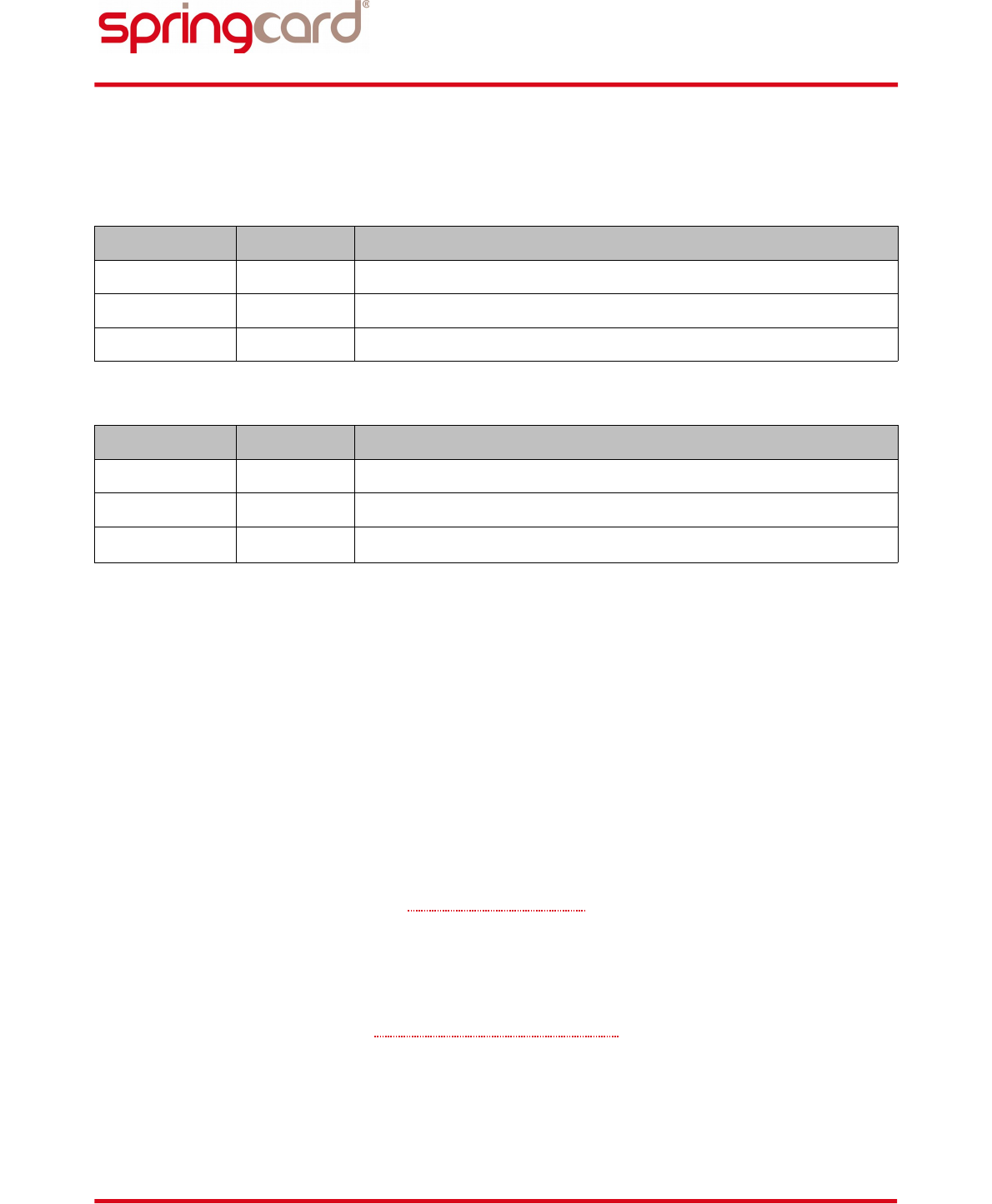
PMD2271-BA
page 8 of 118
SPRINGCARD PC/SC COUPLERS - H663 GROUP - Developer's reference manual
1.3. RELATED DOCUMENTS
a. End users
Editor Doc # Description
SpringCard PMU14186 CSB HSP, CSB HSP LT QuickStart Guide
SpringCard PMU14092 CrazyWriter HSP QuickStart Guide
SpringCard PMU14189 TwistyWriter HSP QuickStart Guide
b. Integrators
Editor Doc # Description
SpringCard PMD2236 H663 Hardware Integration guide
SpringCard PNA14187 CrazyWriter HSP Hardware Integration guide
SpringCard PNA14188 TwistyWriter HSP Hardware Integration guide
1.4. AUDIENCE
This manual is designed for use by application developers. It assumes that the reader has expert
knowledge of computer development and a basic knowledge of PC/SC, of the ISO 7816-4 standard
for smartcards, and of the NFC Forum's specifications.
Chapter 2 provides a quick introduction to those technologies and concepts, but can't cover all the
aspects, as would a book or a training session.
1.5. SUPPORT AND UPDATES
Useful related materials (product datasheets, application notes, sample software, HOWTOs and
FAQs…) are available at SpringCard’s web site:
www.springcard.com
Updated versions of this document and others are posted on this web site as soon as they are
available.
For technical support enquiries, please refer to SpringCard support page, on the web at
www.springcard.com/support
SPRINGCARD, the SPRINGCARD logo, PRO ACTIVE and the PRO ACTIVE logo are registered trademarks of PRO ACTIVE SAS.
All other brand names, product names, or trademarks belong to their respective holders.
Information in this document is subject to change without notice. Reproduction without written permission of PRO ACTIVE is forbidden.

PMD2271-BA
page 9 of 118
SPRINGCARD PC/SC COUPLERS - H663 GROUP - Developer's reference manual
1.6. USEFUL LINKS
Microsoft’s PC/SC reference documentation is included in Visual Studio help system, and
available online at http://msdn.microsoft.com . Enter “winscard” or “SCardTransmit”
keywords in the search box.
MUSCLE PCSC-Lite project: http://www.musclecard.com (direct link to PC/SC stack:
http://pcsclite.alioth.debian.org)
PC/SC workgroup: http://www.pcscworkgroup.com
NFC Forum: http://www.nfc-forum.org
SPRINGCARD, the SPRINGCARD logo, PRO ACTIVE and the PRO ACTIVE logo are registered trademarks of PRO ACTIVE SAS.
All other brand names, product names, or trademarks belong to their respective holders.
Information in this document is subject to change without notice. Reproduction without written permission of PRO ACTIVE is forbidden.

PMD2271-BA
page 10 of 118
SPRINGCARD PC/SC COUPLERS - H663 GROUP - Developer's reference manual
2. PC/SC, SMARTCARDS AND NFC: QUICK INTRODUCTION AND GLOSSARY
2.1. SMART-CARD AND CONTACTLESS SMARTCARDS STANDARDS
A smartcard is a microprocessor (running a software of course) mounted in a plastic card.
The ISO 7816 family of standards defines everything for contact smartcards:
ISO 7816-1 and ISO 7816-2 defines the form-factor and electrical characteristics,
ISO 7816-3 introduces two transport-level protocols between the coupler and the card:
“T=0” and “T=1”,
ISO 7816-4 mandates a common function set. This function set exposes the smartcard as a
small file-system, with directories and files, where the data are stored. The application-
level frames are called APDUs.
The ISO 14443 family is the normative reference for contactless smartcards:
ISO 14443-1 and ISO 14443-2 defines the form-factor, RF characteristics, and bit-level
communication,
ISO 14443-3 specifies the byte- and frame-levels part of the communication1,
ISO 14443-4 introduces a transport-level protocol that more-or-less looks like T=1, so it is
often called “T=CL” (but this name never appears is the standard).
On top of T=CL, the contactless smartcard is supposed to have the same function set and APDUs
formatting rules as contact smartcard, i.e. it should be “ISO 7816-4 on top of ISO 14443”.
In this context, working with a smartcard (either contact or contactless) is as easy as sending a
command (C-APDU) to the card, and receive its response (R-APDU). The “smartcard reader” is only
a gateway that implements this APDU exchange stuff (with a relative abstraction from the
transport-level protocols).
1 ISO 14443-2 and -3 are divided into 2 technologies: ISO 14443 type A and ISO 14443 type B. They use different codings and low-
level protocols, but the transport protocol defined in ISO 14443-4 is type-agnostic: it makes no difference whether the card is type
A or type B.
SPRINGCARD, the SPRINGCARD logo, PRO ACTIVE and the PRO ACTIVE logo are registered trademarks of PRO ACTIVE SAS.
All other brand names, product names, or trademarks belong to their respective holders.
Information in this document is subject to change without notice. Reproduction without written permission of PRO ACTIVE is forbidden.
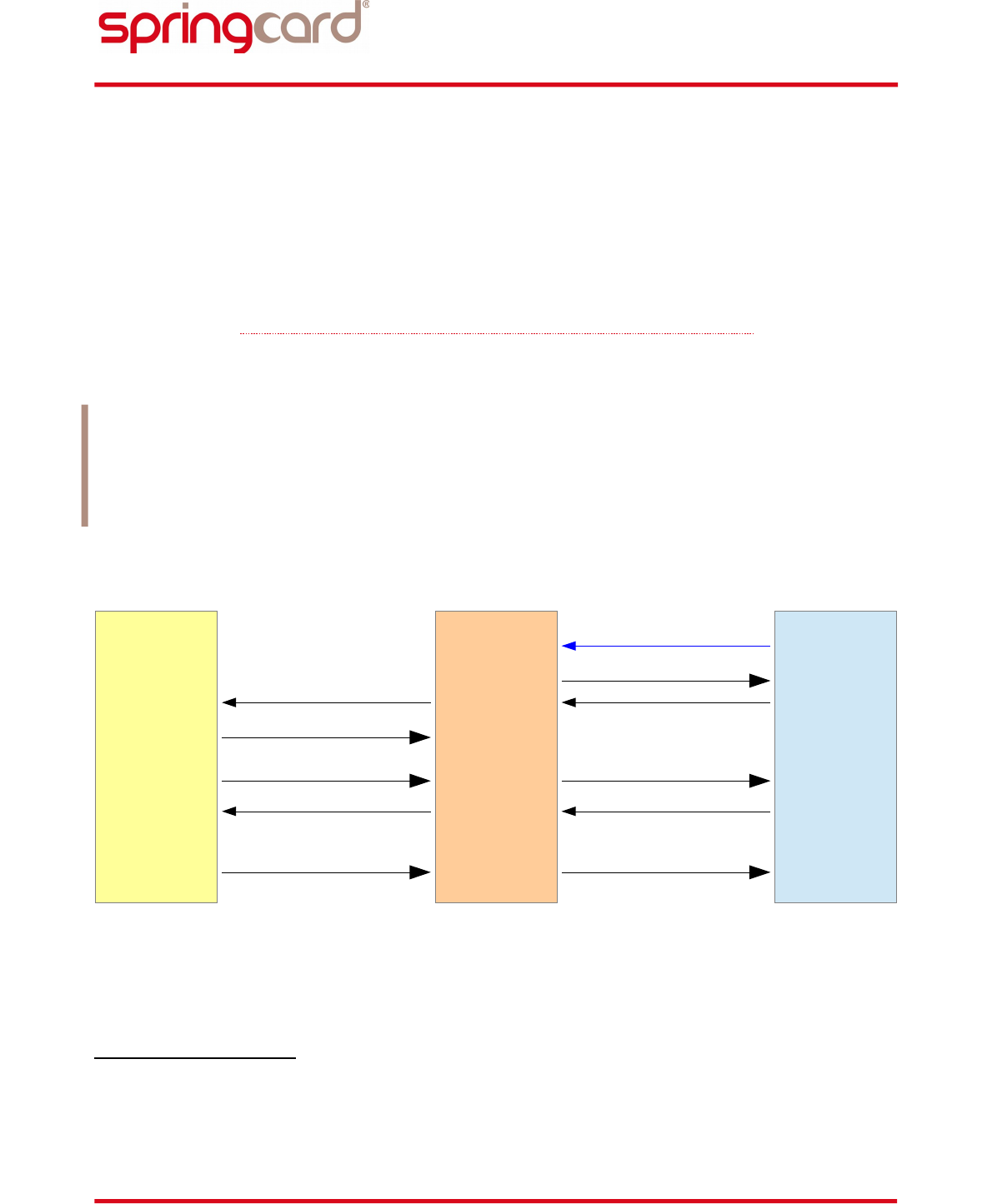
PMD2271-BA
page 11 of 118
SPRINGCARD PC/SC COUPLERS - H663 GROUP - Developer's reference manual
2.2. PC/SC
PC/SC is the de-facto standard to interface Personal Computers with Smart Cards (and smartcard
readers of course). SpringCard PC/SC Couplers comply with this standard. This makes those
products usable on most operating systems, using a high-level and standardized API.
To get started with PC/SC, please read our Introduction to PC/SC development and simplified
documentation of the API, available online at
http://www.springcard.com/download/find.php?file=pmdz061
The heart of PC/SC is the SCardTransmit function, that is the implementation in the computer of
the APDU exchange stuff.
If the smartcard you are working with does comply with ISO 7816-4, there is nothing more to add!
Refer to the ISO 7816-4 standard and/or to the documentation of the card2 to know the APDUs
you must send, and how to understand the responses. Then implement your card-aware process
through a batch of SCardTransmit calls. Whether the smartcard is contactless or contact makes
little to no difference3.
a. PC/SC and a contact smartcard
2 Note that a microprocessor-based smartcard is a chip plus some application running in it. It could be a monolithic application,
without an operating system, or an operating system (for instance JavaCard) with some applications added. You need the
documentation of the application(s) and in some situations the documentation of the operating system, not the chip's.
3 Actually there's more differences between contact protocols T=0 and T=1 than between contactless protocol “T=CL” and T=1.
When developing an application for a contactless smartcard, read the ISO 7816-4 standard and the documentation of the
smartcard as if it were running T=1.
SPRINGCARD, the SPRINGCARD logo, PRO ACTIVE and the PRO ACTIVE logo are registered trademarks of PRO ACTIVE SAS.
All other brand names, product names, or trademarks belong to their respective holders.
Information in this document is subject to change without notice. Reproduction without written permission of PRO ACTIVE is forbidden.
PC
application
H663
Contact
reader
ISO
7816-3
smartcard
(T=0 or
T=1)
(PPS)
(PPS Resp.)
Card insert event
(SCardWaitStatusChange)
Connect to the card
(SCardConnect)
C-APDU
(SCardTransmit)
C-APDU
(T=0 or T=1 blocks)
R-APDU
(T=0 or T=1 blocks)
R-APDU
(SCardTransmit success)
Disconnect from the card
(SCardDisconnect) (power down)
(ATR)
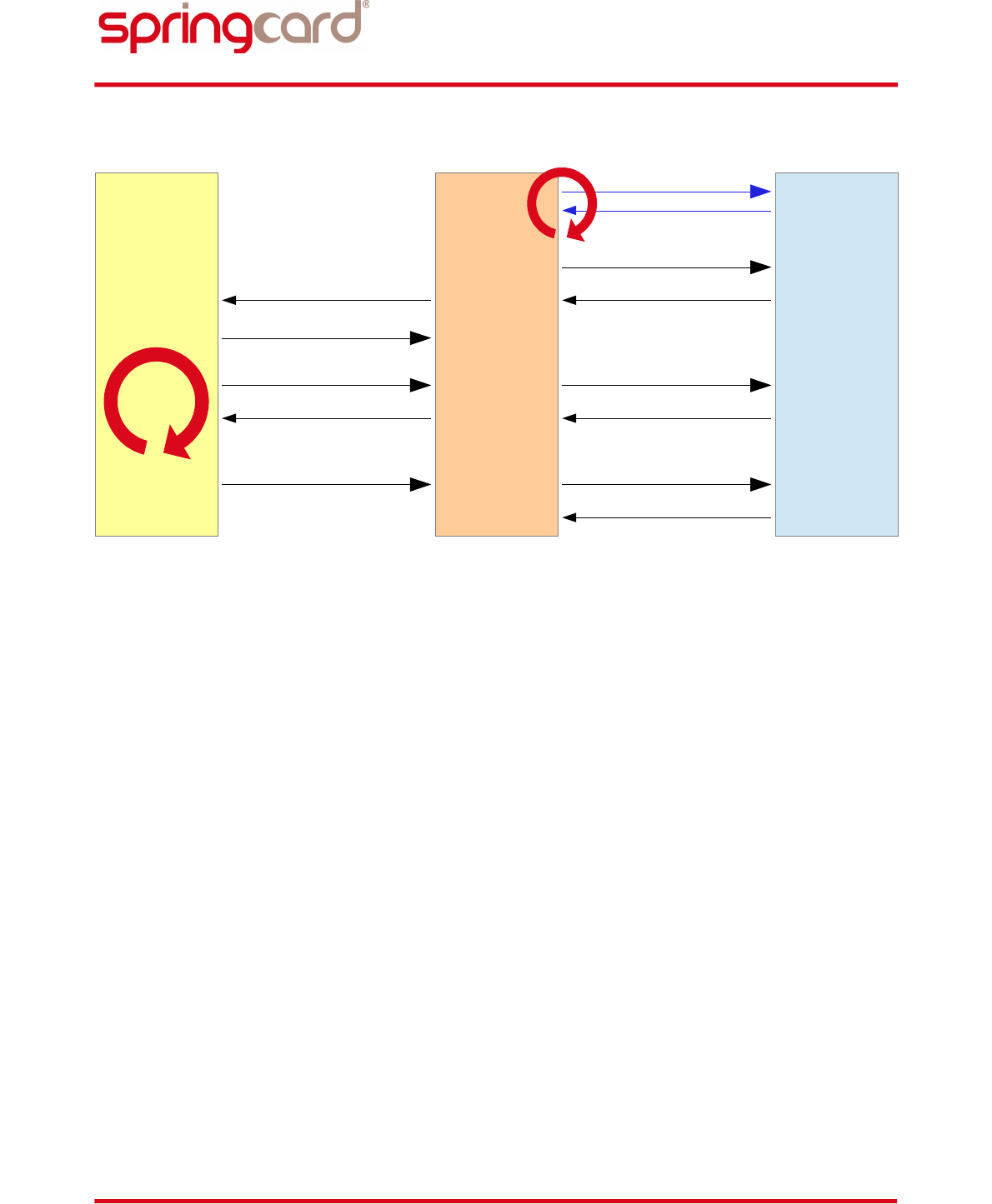
PMD2271-BA
page 12 of 118
SPRINGCARD PC/SC COUPLERS - H663 GROUP - Developer's reference manual
b. PC/SC and a contactless smartcard
2.3. NON-7816-4 CONTACTLESS CARDS – INTRODUCING THE EMBEDDED APDU INTERPRETER
A lot of contactless cards are not actually “smartcards” because they are not ISO 7816-4
compliant. They don't comply with the ISO 14443-4 transport-level protocol, and their vendor-
specific function set can't fit directly in a single “exchange” function. Therefore, they are not
natively supported by the system's PC/SC stack. This is the case of:
Wired-logic memory cards (Mifare, CTS, SR... families),
NFC Tags (type 1, type 2, type 3),
Even some proprietary microprocessor-based cards that use a specific communication
protocol with a frame format not compliant with ISO 7816-4 (Desfire EV0...).
The role of the embedded APDU interpreter, running in the H663, is to 'emulate' a standard
smartcard in those cases. Doing so, the PC/SC stack (and as a consequence your application)
doesn't have to deal with the underlying protocols and chip-specific commands.
Basically, the embedded APDU interpreter exposes the card as being a T=1 compliant smartcard,
and provides two functions taken from ISO 7816-4: READ BINARY and UPDATE BINARY. In ISO
7816-4, those functions are intended to access data within a file (in the card's file-system), but on
memory cards they give access to the “raw” storage, using a byte-, block- or page-based access
depending on the card technology and features.
SPRINGCARD, the SPRINGCARD logo, PRO ACTIVE and the PRO ACTIVE logo are registered trademarks of PRO ACTIVE SAS.
All other brand names, product names, or trademarks belong to their respective holders.
Information in this document is subject to change without notice. Reproduction without written permission of PRO ACTIVE is forbidden.
PC
application
H663
C/less
reader
ISO
14443-4
smartcard
(type A or
type B)
Polling + anticollision
(REQA, REQB, ...)
Enter T=CL
(RATS or ATTRIB)
(ATS or R-ATTRIB)
Card insert event
(SCardWaitStatusChange)
Connect to the card
(SCardConnect)
C-APDU
(SCardTransmit)
C-APDU
(I-blocks)
R-APDU
(I-blocks)
R-APDU
(SCardTransmit success)
Disconnect from the card
(SCardDisconnect)
Leave T=CL
(Deselect)
(Deselect)
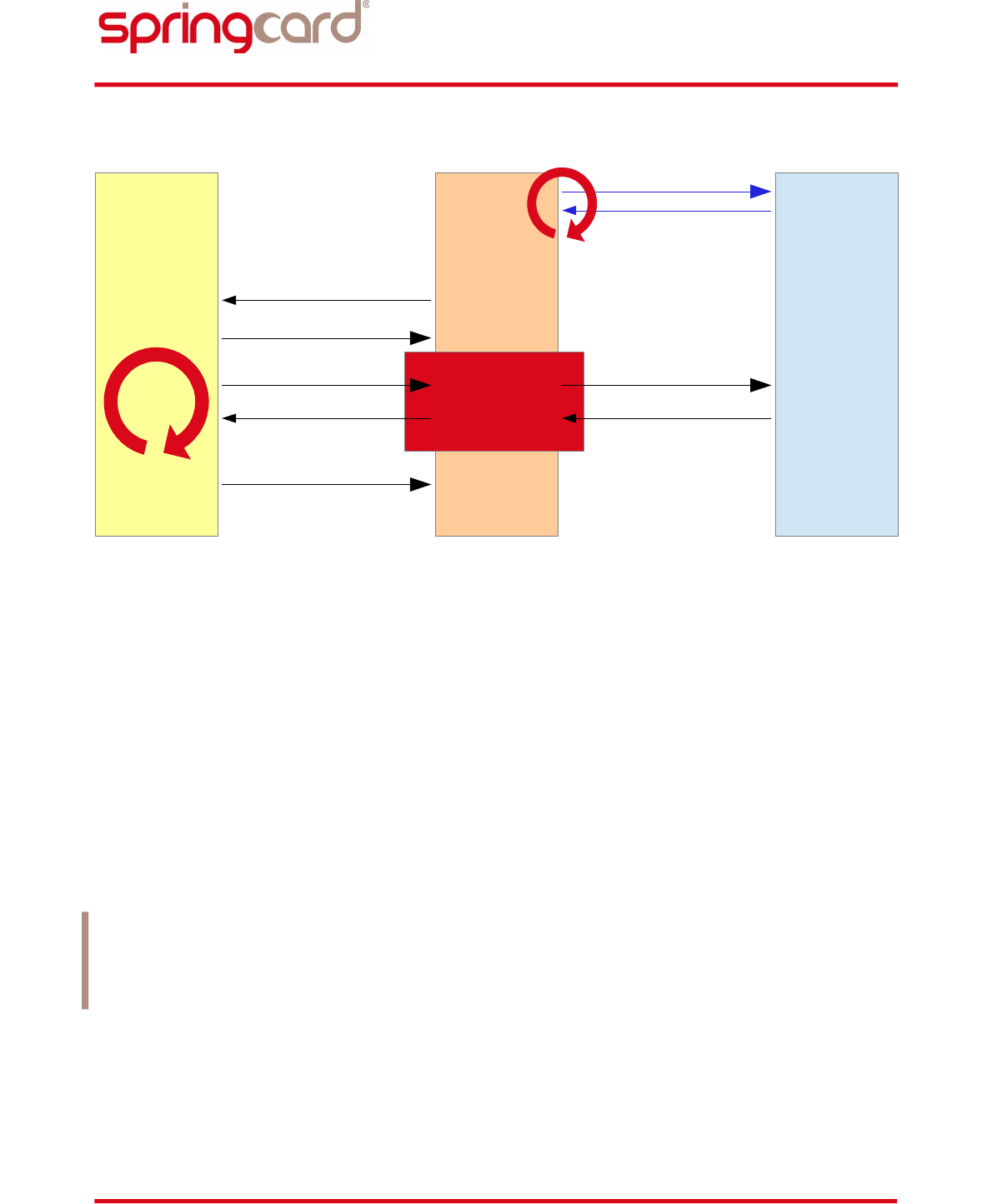
PMD2271-BA
page 13 of 118
SPRINGCARD PC/SC COUPLERS - H663 GROUP - Developer's reference manual
a. Role of the embedded APDU interpreter
2.4. NFC ?
NFC stands for Near Field Communication, which is the case of all communication systems using
low frequencies or very short operating distance. But NFC is now understood as both
NFCIP-1 (Near Field Communication Interface and Protocol), i.e. the ISO 18092 standard,
which defines a new transport-level protocol sometimes called “peer-to-peer” (but this
name never appears is the standard),
NFC Forum, an association that promotes the uses of NFC and publishes “application-level”
standards (where ISO focuses on the technical levels).
SpringCard H663 and derived products are partially compliant with NFCIP-1 (initiator role, passive
communication mode only). Please refer to chapter 5 for details. These products should also
support NFC Forum's applications, but no compliance with NFC Forum's low level requirements is
claimed.
Note that in NFC Forum's literature,
- ISO 14443 type A and ISO 18092 @ 106kbit/s is called NFC-A,
- ISO 14443 type B is called NFC-B,
- JIS:X6319-4 and ISO 18092 @ 212/424kbit/s is called NFC-F.
SPRINGCARD, the SPRINGCARD logo, PRO ACTIVE and the PRO ACTIVE logo are registered trademarks of PRO ACTIVE SAS.
All other brand names, product names, or trademarks belong to their respective holders.
Information in this document is subject to change without notice. Reproduction without written permission of PRO ACTIVE is forbidden.
H663
C/less
reader
APDU
interpreter
PC
application
C/less
memory
card
(or NFC Tag,
RFID label,
...)
Polling + anticollision
(all protocols)
Card insert event
(SCardWaitStatusChange)
Connect to the card
(SCardConnect)
C-APDU
(SCardTransmit)
Card-specific function
(using card-specific protocol)
Card-specific response
(using card-specific protocol)
R-APDU
(SCardTransmit success)
Disconnect from the card
(SCardDisconnect)

PMD2271-BA
page 14 of 118
SPRINGCARD PC/SC COUPLERS - H663 GROUP - Developer's reference manual
2.5. VENDOR-SPECIFIC FEATURES – DIRECT CONTROL OF THE COUPLER
PC/SC's SCardTransmit function implements a communication channel between your application
and the card. But sometimes the application wants to access some features of the H663 itself:
driving the LEDs or buzzer, getting the serial number... In other words, the application wants to
talk to the coupler and not to the card.
The PC/SC's SCardControl function has been designed to do so. Chapter 6 details the commands
supported by the H663 using this direct communication channel. But opening a SCardControl
channel means getting a direct (and exclusive) access to the coupler, and as a consequence blocks
the other communication channel(s).
To overcome this drawback, the embedded APDU interpreter could also be used to convey
commands to the coupler with an existing card-channel and using SCardTransmit calls (see § 3.4.1
for details).
SPRINGCARD, the SPRINGCARD logo, PRO ACTIVE and the PRO ACTIVE logo are registered trademarks of PRO ACTIVE SAS.
All other brand names, product names, or trademarks belong to their respective holders.
Information in this document is subject to change without notice. Reproduction without written permission of PRO ACTIVE is forbidden.
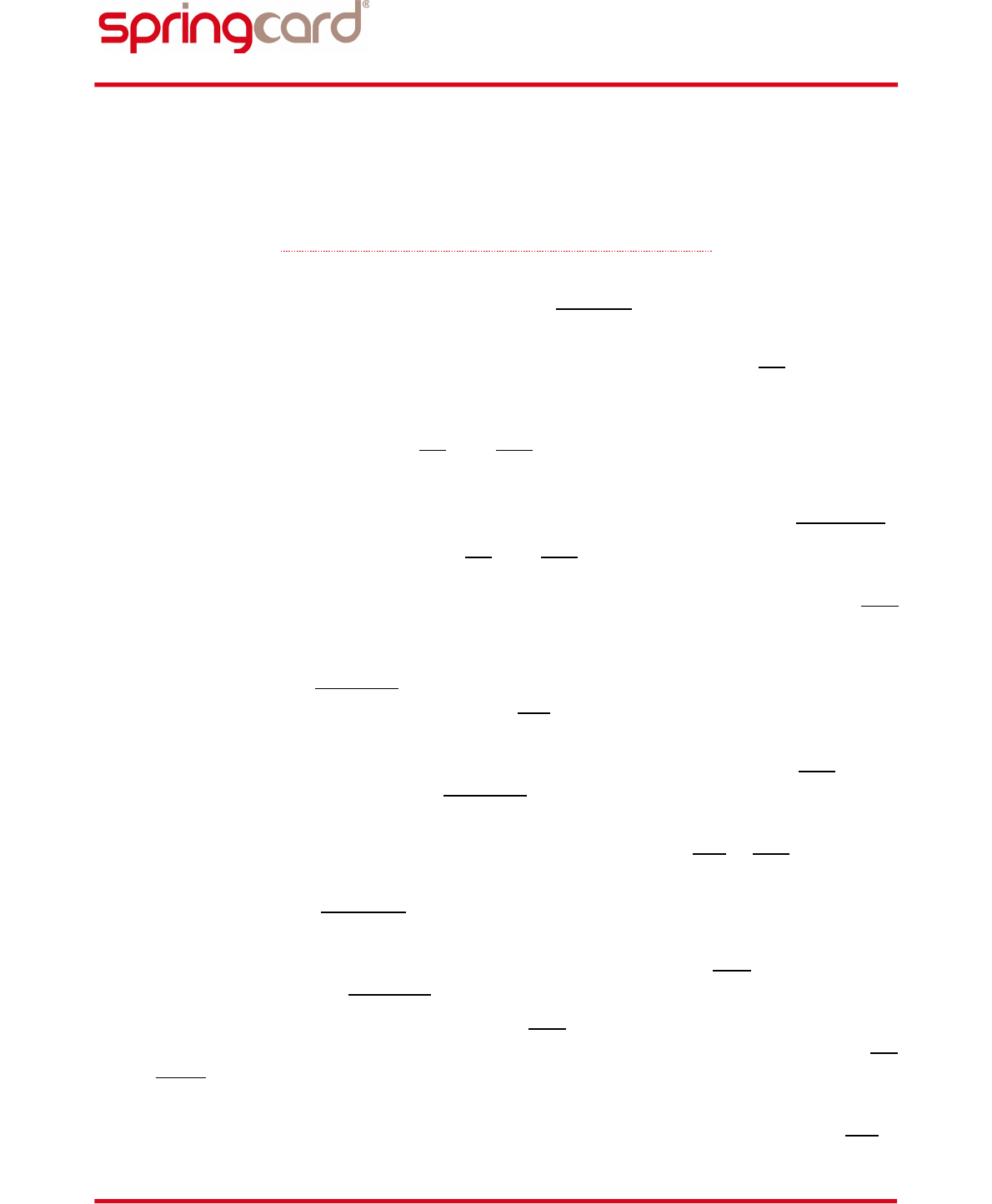
PMD2271-BA
page 15 of 118
SPRINGCARD PC/SC COUPLERS - H663 GROUP - Developer's reference manual
2.6. GLOSSARY – USEFUL TERMS
The following list contains the terms that are directly related to the subject of this document. This
is an excerpt from our technical glossary, available online at:
http://www.springcard.com/blog/technical-glossary/
ICC: integrated-circuit card. This is the standard name for a plastic card holding a silicon
chip (an integrated circuit) compliant with the ISO 7816 standards. A common name is
smartcard.
CD: coupling device or coupler. A device able to communicate with an ICC. This is what
everybody calls a smartcard reader. Technically speaking, it could be seen as a gateway
between the computer and the card.
Microprocessor-based card: an ICC (or a PICC) whose chip is a small computer. This is the
case of high-end cards used in payment, transport, eID/passports, access control... Key
features are security, ability to store a large amount of data and to run an application
inside the chip. Most of the time they implement the command set defined by ISO 7816-4.
Memory card or wired logic card: an ICC (or a PICC) whose chip is only able to store some
data, and features a limited security scheme (or no security scheme at all). They are
cheaper than microprocessor-based cards and therefore are widely used for RFID
traceability, loyalty, access control...
PICC: proximity integrated-circuit card. This is the standard name for any contactless card
compliant with the ISO 14443 standards (proximity: less than 10cm). This could either be a
smartcard or a memory card, or also any NFC object running in card emulation mode.
Common names are contactless card, or RFID card, NFC Tag.
PCD: proximity coupling device. A device able to communicate with a PICC, i.e. a
contactless coupler compliant with ISO 14443.
RFID: radio-frequency identification. This is the general name for any system using radio
waves for M2M communication (machine to machine, in our case PCD to PICC).
VICC: vicinity integrated circuit card. This is the standard name for any contactless card
compliant with the ISO 15693 standards (vicinity: less than 150cm). Common names are
RFID tag, RFID label.
VCD: vicinity coupling device. A device able to communicate with a VICC, i.e. a contactless
coupler compliant with ISO 15693.
NFC: near-field communication. A subset of RFID, where the operating distance is much
shorter than the wavelength of the radio waves involved. This is the case for both ISO
14443: the carrier frequency is 13.56MHz, leading to a wavelength of 22m. The proximity
and vicinity ranges are shorter than this wavelength.
NFC Forum: an international association that aims to standardize the applications of NFC in
the 13.56MHz range. Their main contribution is the NFC Tags, which are nothing more than
SPRINGCARD, the SPRINGCARD logo, PRO ACTIVE and the PRO ACTIVE logo are registered trademarks of PRO ACTIVE SAS.
All other brand names, product names, or trademarks belong to their respective holders.
Information in this document is subject to change without notice. Reproduction without written permission of PRO ACTIVE is forbidden.

PMD2271-BA
page 16 of 118
SPRINGCARD PC/SC COUPLERS - H663 GROUP - Developer's reference manual
PICCs which data are formatted according to their specifications, so the information they
contain is understandable by any compliant application.
NDEF: NFC Data Exchange Format. The format of the data on the NFC Tags specified by the
NFC Forum.
ISO 7816-1 and ISO 7816-2: This international standard defines the hardware
characteristics of the ICC. The standard smartcard format (86x54mm) is called ID-1. A
smaller form-factor is used for SIM cards (used in mobile phone) or SAM (secure
authentication module, used for payment or transport applications) and is called ID-000.
ISO 7816-3: This international standard defines two communication protocols for ICCs: T=0
and T=1. A compliant coupler must support both of them.
ISO 7816-4: This international standard defines both a communication scheme and a
command set. The communication scheme is made of APDUs. The command set assumes
that the card is structured the same way as a computer disk drive: directories and files
could be selected (SELECT instruction) and accessed for reading or writing (READ BINARY,
UPDATE BINARY instructions). More than 40 instructions are defined by the standard, but
most cards implement only a small subset, and often add their own (vendor-specific)
instructions.
APDU: application protocol datagram unit. These are the frames that are exchanged at
application-level between an application running on the computer and a smartcard. The
format of those frames is defined by ISO 7816-4 and checked by the system's PC/SC stack.
The command (application to card) is called a C-APDU, the response (card to application)
an R-APDU. Note that this is a request/response scheme: the smartcard has no way to send
something to the application unless the application asks for it.
ISO 14443: This international standard defines the PCD/PICC communication scheme. It is
divided into 4 layers:
1. Defines the hardware characteristics of the PICC,
2. Defines the carrier frequency and the bit-level communication scheme,
3. Defines the frame-level communication scheme and the session opening
sequence (anti-collision),
4. Defines the transport-level communication scheme (sometimes called “T=CL”).
The application-level is out of the scope of ISO 14443. Most microprocessor-based PICCs
implement ISO 7816-4 on top of ISO 14443-4.
A lot of wired logic PICCs (NXP Mifare family, ST Micro Electronics ST/SR families, to name
a few) implements only a subset of ISO 14443, and have their own set of functions on top
of either ISO 14443-2 or ISO 14443-3.
Note that ISO 14443-2 and ISO 14443-3 are divided into 2 protocols called 'A' and 'B'. A
PCD shall implement both, but the PICCs implement only one of them4. Four
4Yet some NFC objects may emulate both an ISO 14443-A and an ISO 14443-B card.
SPRINGCARD, the SPRINGCARD logo, PRO ACTIVE and the PRO ACTIVE logo are registered trademarks of PRO ACTIVE SAS.
All other brand names, product names, or trademarks belong to their respective holders.
Information in this document is subject to change without notice. Reproduction without written permission of PRO ACTIVE is forbidden.
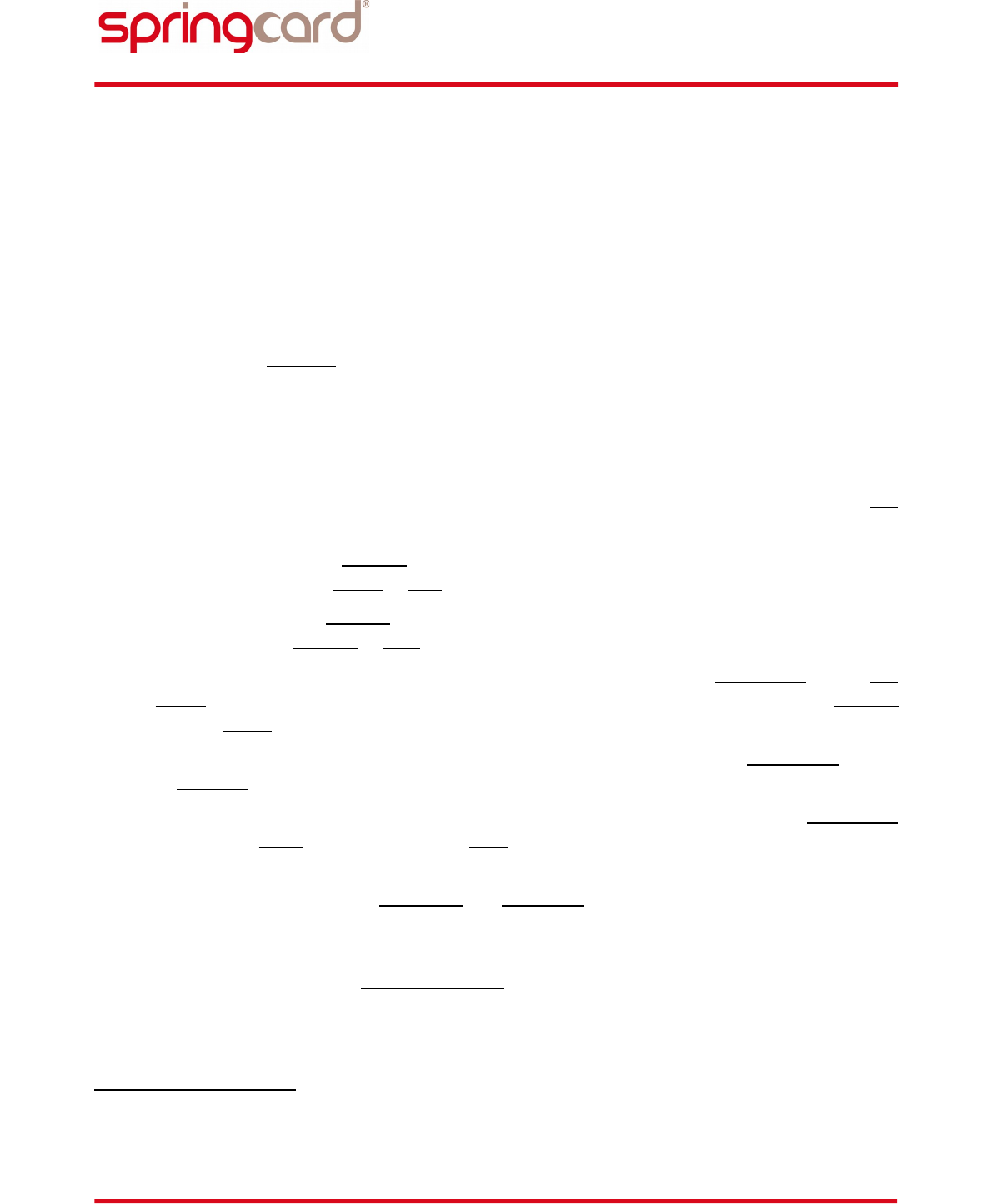
PMD2271-BA
page 17 of 118
SPRINGCARD PC/SC COUPLERS - H663 GROUP - Developer's reference manual
communication baud rates are possible: 106 kbit/s is mandatory, higher baud rates (212,
424 or 848 kbit/s) are optional.
ISO 15693: This international standard defines the VCD/VICC communication scheme. It is
divided into 3 layers:
1. Defines the hardware characteristics of the VICC,
2. Defines the carrier frequency and the bit-level communication scheme,
3. Defines the frame-level communication scheme, the session opening sequence
(anti-collision/inventory), and the command set of the VICC.
All VICCs are memory chips. Their data storage area is divided into blocks. The size of the
blocks and the number of them depend on the VICC.
Note that ISO 18000-3 mode 1 is the same as ISO 156935.
ISO 18092 or NFCIP-1: This international standard defines a communication scheme (most
of the time named “peer to peer mode”) where two peer “objects” are able to
communicate together (and not only a PCD and a PICC). The underlying protocol is ISO
14443-A at 106 kbit/s and JIS:X6319-4 (aka Sony Felica protocol) at 212 and 424 kbit/s.
Initiator: according to NFCIP-1, the NFC object that is the “master” of the communication
with a peer known as target. A PCD is a sort of initiator.
Target: according to NFCIP-1, the NFC object that is the “slave” in the communication with
a peer known as initiator. A PICC is a sort of target.
NFC-DEP: NFC Data Exchange Protocol. This is the name used by the NFC Forum for the ISO
18092 “high level” protocol. After an initial handshaking (ATR_REQ/ATR_RES), the initiator
and the target exchanges transport-level blocks (DEP_REQ/DEP_RES).
LLCP: Logical Link Control Protocol. A network protocol specified by the NFC Forum on top
of NFC-DEP.
SNEP: Simple NDEF Exchange Protocol. An application protocol specified by the NFC Forum
to exchange NDEF messages on top of LLCP.
ISO 21481 or NFCIP-2: This international standard defines how a NFC object shall also be
able to communicate using ISO 14443 and ISO 15693 standards.
Mifare: This trademark of NXP (formerly Philips Semiconductors) is the generic brand
name of their PICC products. Billions of Mifare Classic cards have been deployed since the
90's. This is a family of wired-logic PICCs were data storage is divided into sectors and
protected by a proprietary6 stream cipher called CRYPTO1. Every sector is protected by 2
access keys called “key A” and “key B”7. NXP also offers another family of wired-logic PICCs
called Mifare UltraLight (adopted by the NFC Forum as NFC Type 2 Tags). Mifare SmartMX
5ISO 15693 has been written by the workgroup in charge of smartcards, and then copied by the workgroup in charge of RFID into
ISO 18000, the large family of RFID standards.
6And totally broken. Do not rely on this scheme in security-sensitive applications!
7A typical formatting would define key A as the key for reading, and key B as the key for reading+writing.
SPRINGCARD, the SPRINGCARD logo, PRO ACTIVE and the PRO ACTIVE logo are registered trademarks of PRO ACTIVE SAS.
All other brand names, product names, or trademarks belong to their respective holders.
Information in this document is subject to change without notice. Reproduction without written permission of PRO ACTIVE is forbidden.

PMD2271-BA
page 18 of 118
SPRINGCARD PC/SC COUPLERS - H663 GROUP - Developer's reference manual
(and former Pro/ProX) is a family of microprocessor-based PICCs that may run virtually any
smartcard application, typically on top a JavaCard operating system. Mifare Desfire is a
particular microprocessor-based PICC that runs a single general-purpose application.
Felica: This trademark of Sony is the generic brand name of their PICC products. The
underlying protocol has been standardized in Japan (JIS:X6319-4) and is used by ISO 18092
at 212 and 424 kbit/s. The Felica standard includes a Sony-proprietary security scheme that
is not implemented in SpringCard's products. Therefore, only the Felica chips configured to
work without security (“Felica Lite”, “Felica Lite-S”, or NFC Type 3 Tags) are supported.
SPRINGCARD, the SPRINGCARD logo, PRO ACTIVE and the PRO ACTIVE logo are registered trademarks of PRO ACTIVE SAS.
All other brand names, product names, or trademarks belong to their respective holders.
Information in this document is subject to change without notice. Reproduction without written permission of PRO ACTIVE is forbidden.

PMD2271-BA
page 19 of 118
SPRINGCARD PC/SC COUPLERS - H663 GROUP - Developer's reference manual
3. EMBEDDED APDU INTERPRETER
3.1. BASIS
In PC/SC architecture, the SCardTransmit function implements the dialogue between an
application and a smartcard, the coupler being only a “passive” gateway. The coupler transmits
frames in both directions, without any specific processing. The dialogue follows the ISO 7816-4
APDU rules:
Application to smartcard C-APDU is CLA, INS, P1, P2, Data In (optional)
Smart-card to application R-APDU is Data Out (optional), SW1, SW2
In order to work with non ISO 7816-4 cards as if they were smartcards, the embedded APDU
interpreter obeys to the same rules, offering its own list of instructions under the reserved class
CLA=hFF. It is therefore available through regular SCardTransmit calls.
3.1.1. CLA byte of the embedded APDU interpreter
Default class is hFF. This means that every APDU starting with CLA= hFF will be interpreted by the
H663, and not forwarded by the card.
a. Changing the CLA byte of the embedded APDU interpreter
The CLA byte of the embedded APDU interpreter is stored in register hB2 of H663’s non volatile
memory (see § 7.4.2).
Note: in the following paragraphs, documentation of the APDUs is written with CLA= hFF. Change
this to match your own CLA if necessary.
b. Disabling the embedded APDU interpreter
Define CLA byte = h00 (register hB2= h00, see § 7.4.2) to disable the embedded APDU interpreter.
SPRINGCARD, the SPRINGCARD logo, PRO ACTIVE and the PRO ACTIVE logo are registered trademarks of PRO ACTIVE SAS.
All other brand names, product names, or trademarks belong to their respective holders.
Information in this document is subject to change without notice. Reproduction without written permission of PRO ACTIVE is forbidden.
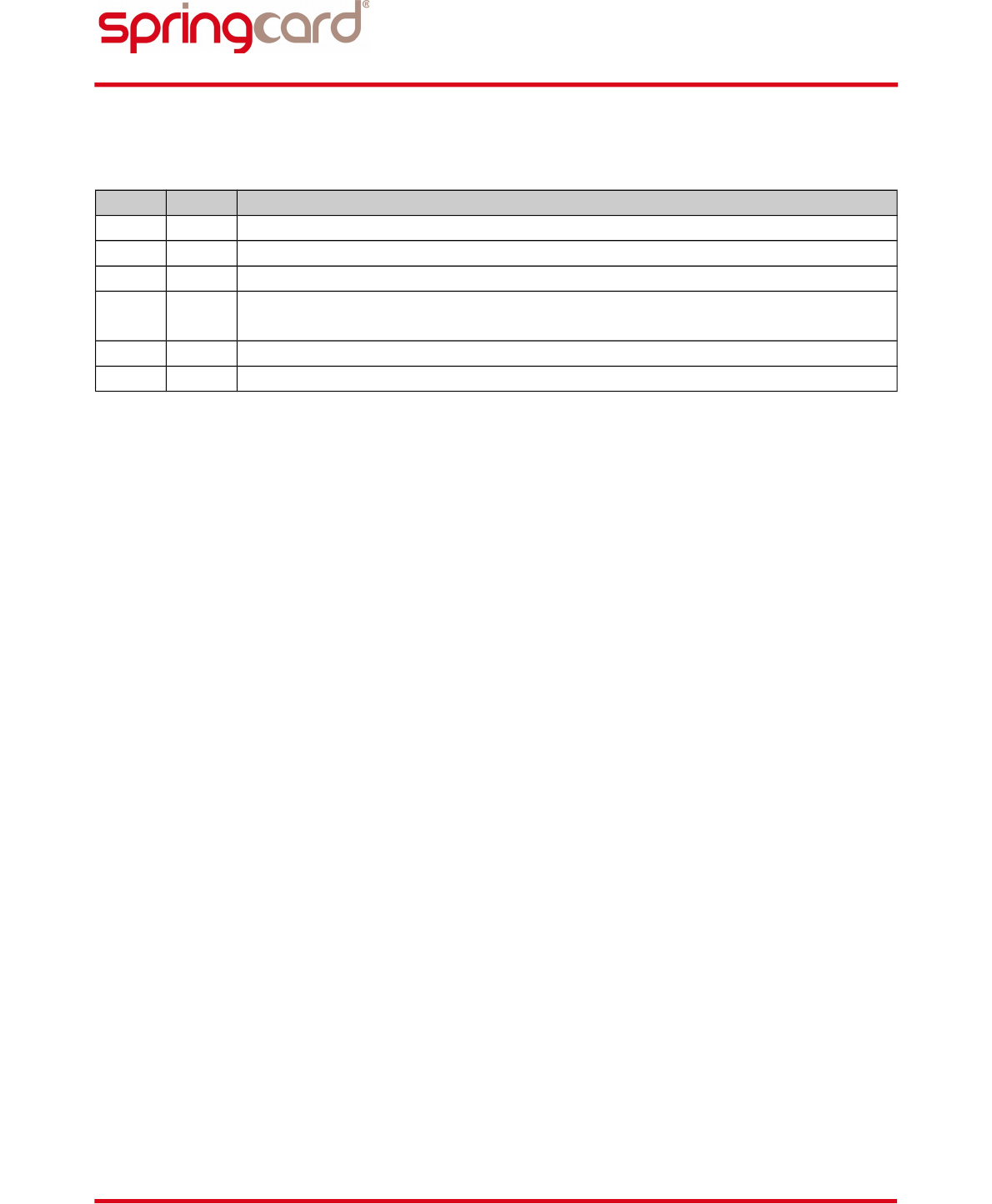
PMD2271-BA
page 20 of 118
SPRINGCARD PC/SC COUPLERS - H663 GROUP - Developer's reference manual
3.1.2. Status words returned by the embedded APDU interpreter
SW1 SW2 Meaning
h90 h00 Success
h67 h00 Wrong length (Lc incoherent with Data In)
h68 h00 CLA byte is not correct
h6A h81 Function not supported (INS byte is not correct), or not available for the
selected PICC/VICC
h6B h00 Wrong parameter P1-P2
h6F h01 PICC mute or removed during the transfer
Some functions provided by the embedded APDU interpreter may return specific status words.
This behaviour is documented within the paragraph dedicated to each function.
SPRINGCARD, the SPRINGCARD logo, PRO ACTIVE and the PRO ACTIVE logo are registered trademarks of PRO ACTIVE SAS.
All other brand names, product names, or trademarks belong to their respective holders.
Information in this document is subject to change without notice. Reproduction without written permission of PRO ACTIVE is forbidden.

PMD2271-BA
page 21 of 118
SPRINGCARD PC/SC COUPLERS - H663 GROUP - Developer's reference manual
3.1.3. Embedded APDU interpreter instruction list
Instruction INS Contactless Contact Notes (see below)
LOAD KEY h82 C
GENERAL AUTHENTICATE h86 C
READ BINARY hB0 A
ENVELOPE hC2 B
GET DATA hCA C
UPDATE BINARY hD6 A
READER CONTROL hF0 D
MICORE CONTROL hF1 D
ABCCORE CONTROL hF1 D
MIFARE CLASSIC READ hF3 D
MIFARE CLASSIC WRITE hF4 D
MIFARE CLASSIC VALUE hF5 D
RFID MEMORY CONTROL hF6 D – starting from FW 1.81
CONTACTLESS SLOT CONTROL hFB D
TEST hFD D
ENCAPSULATE hFE D
Notes:
AFunction fully implemented according to PC/SC standard
BFunction implemented according to PC/SC standard, but some feature are not supported
CFunction implemented according to PC/SC standard, but also provides vendor-specific
options
DVendor-specific function
SPRINGCARD, the SPRINGCARD logo, PRO ACTIVE and the PRO ACTIVE logo are registered trademarks of PRO ACTIVE SAS.
All other brand names, product names, or trademarks belong to their respective holders.
Information in this document is subject to change without notice. Reproduction without written permission of PRO ACTIVE is forbidden.

PMD2271-BA
page 22 of 118
SPRINGCARD PC/SC COUPLERS - H663 GROUP - Developer's reference manual
3.2. INSTRUCTIONS DEFINED BY THE PC/SC STANDARD (V2 PART 3)
3.2.1. GET DATA instruction
The GET DATA instruction retrieves information regarding the inserted PICC. It can be used with
any kind of PICC, but the returned content will vary with the type of PICC actually in the slot.
GET DATA command APDU
CLA INS P1 P2 Lc Data In Le
hFF hCA See
below
See
below - - h00
GET DATA command parameters
P1 P2 Action Fw
Standard PC/SC-defined values
h00 h00 Serial number of the PICC
- ISO 14443-A : UID (4, 7 or 11 bytes)
- ISO 14443-B : PUPI (4 bytes)
- ISO 15693: UID (8 bytes)
- Innovatron : DIV (4 bytes)
- JIS:X6319-4 : IDm (8 bytes)
- others: see chapter 4 for details
SpringCard specific values
h01 h00 - ISO 14443-A : historical bytes from the ATS
- ISO 14443-B : INF field in ATTRIB response
- JIS:X6319-4 : PMm (8 bytes)
- ISO 18092 : GT bytes in ATR_RES
- others: see chapter 4 for details
hF0 h00 Complete identifier of the PICC:
- ISO 14443-A: ATQA (2 bytes) + SAK (1 byte) + UID
- ISO 14443-B: complete ATQB (11 or 12 bytes)8
- ISO 15693: answer to GET SYSTEM INFORMATION command9
- Innovatron: REPGEN
- Innovision/Broadcom/NFC Forum Type 1 Tag: HR0, HR1
- JIS:X6319-4 : IDm and PMm (16 bytes)
- ISO 18092 : complete ATR_RES
≥ 1.75
8SpringCard PC/SC Couplers are ready to support the extended ATQB (12 bytes), but since a lot of PICC currently in circulation
don't reply to the REQB command with the “extended” bit set, this feature is not enabled by default.
9If the card doesn’t support the GET SYSTEM INFORMATION COMMAND, a valid SYSTEM INFORMATION value is constructed,
including the UID and the DSFID byte.
SPRINGCARD, the SPRINGCARD logo, PRO ACTIVE and the PRO ACTIVE logo are registered trademarks of PRO ACTIVE SAS.
All other brand names, product names, or trademarks belong to their respective holders.
Information in this document is subject to change without notice. Reproduction without written permission of PRO ACTIVE is forbidden.
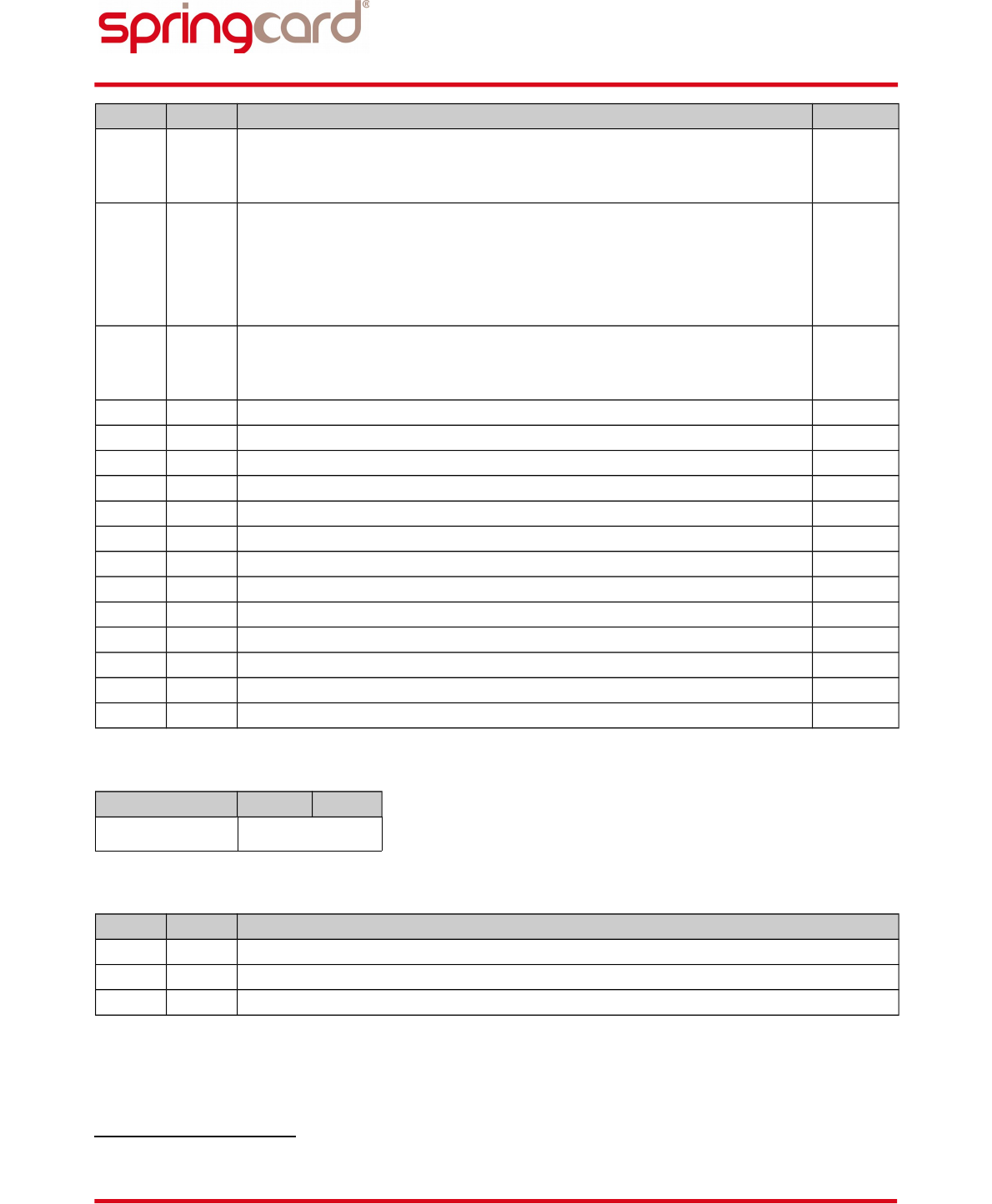
PMD2271-BA
page 23 of 118
SPRINGCARD PC/SC COUPLERS - H663 GROUP - Developer's reference manual
P1 P2 Action
hF1 h00 Type of the PICC/VICC, according to PC/SC part 3 supplemental
document: PIX.SS (standard, 1 byte) + PIX.NN (card name, 2 bytes)
See chapter 4.1 for details
hF1 h01 NFC Tag10 compliance:
- h01 if the PICC is recognized as a NFC Type 1 Tag
- h02 if the PICC is recognized as a NFC Type 2 Tag
- h03 if the PICC is recognized as a NFC Type 3 Tag
- h00 otherwise
hF2 h00 “Short” serial number of the PICC
- ISO 14443-A: UID truncated to 4 bytes, in “classical” order
- others: same as P1,P2=h00,h00
hFA h00 Card’s ATR
hFC h00 ISO 14443 communication indexes on 2 bytes (DSI, DRI)
hFC h01 PICC/VICC → H663 baudrate (DS in kbit/s, 2 bytes, MSB first)
hFC h02 H663 → PICC/VICC baudrate (DR in kbit/s, 2 bytes, MSB first)
hFC h03 Index of the active antenna on 1 byte
hFF h00 Product serial number (raw value on 4 bytes)
hFF h01 Not available for H663
hFF h02 Name of the RF interface component (“RC663”)
hFF h81 Vendor name in ASCII (“SpringCard”)
hFF h82 Product name in ASCII
hFF h83 Product serial number in ASCII
hFF h84 Product USB identifier (VID/PID) in ASCII
hFF h85 Product version (“x.xx”) in ASCII
GET DATA response
Data Out SW1 SW2
XX … XX See below
GET DATA status word
SW1 SW2 Meaning
h90 h00 Success
h62 h82 End of data reached before Le bytes (Le is greater than data length)
h6C XX Wrong length (Le is shorter than data length, XX in SW2 gives the correct value)
10 Please refer to NFC Forum’s specifications for details. Note that NFC Forum Type 4 Tags are “standard” contactless smartcards; it
is up to the application level to send the proper SELECT APPLICATION to recognize them.
SPRINGCARD, the SPRINGCARD logo, PRO ACTIVE and the PRO ACTIVE logo are registered trademarks of PRO ACTIVE SAS.
All other brand names, product names, or trademarks belong to their respective holders.
Information in this document is subject to change without notice. Reproduction without written permission of PRO ACTIVE is forbidden.
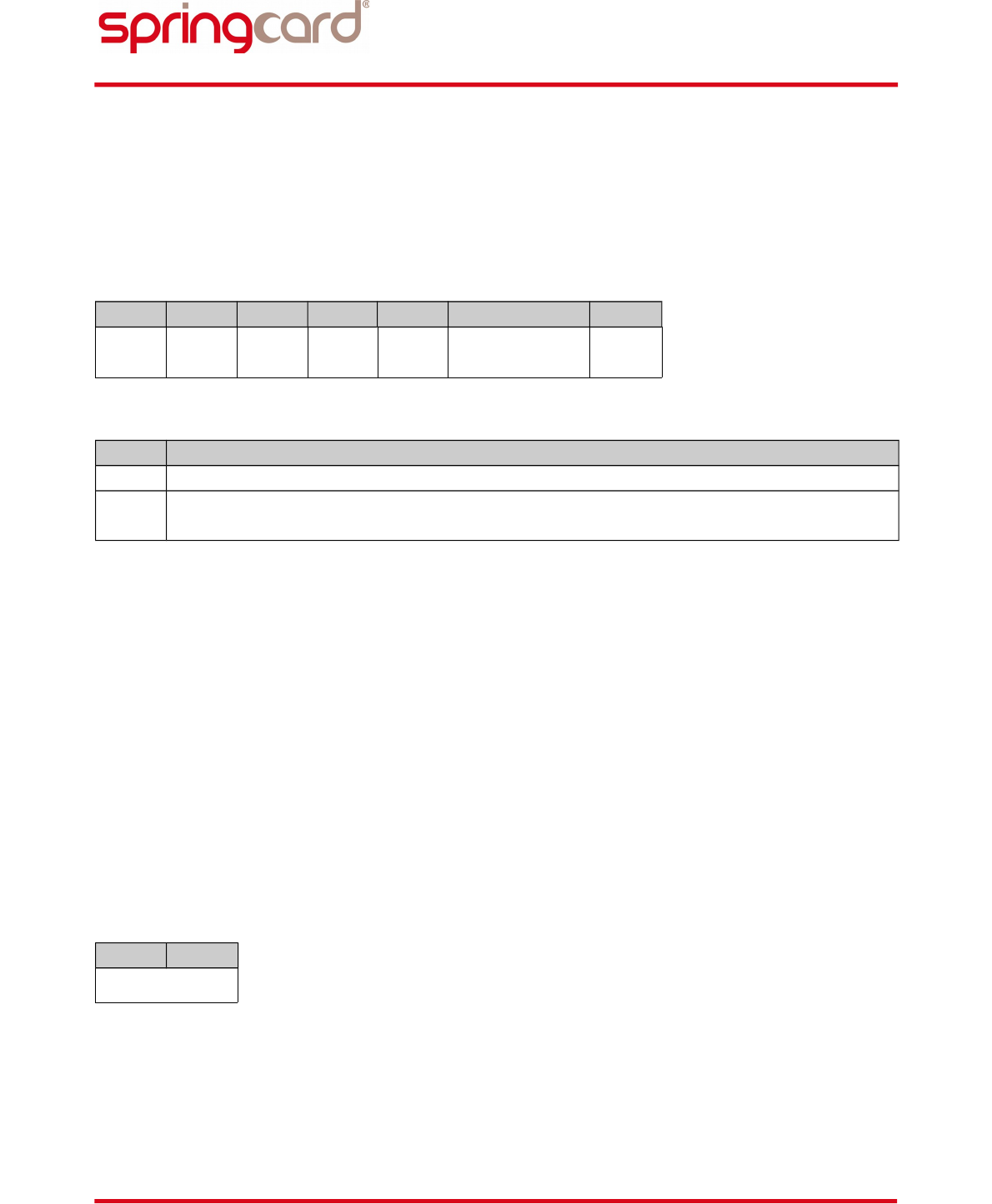
PMD2271-BA
page 24 of 118
SPRINGCARD PC/SC COUPLERS - H663 GROUP - Developer's reference manual
3.2.2. LOAD KEY instruction
The LOAD KEY instruction loads a 6-byte Mifare Classic access key (CRYPTO1) into the H663’s
memory.
LOAD KEY command APDU
CLA INS P1 P2 Lc Data In Le
hFF h82 Key
location
Key
index
h06 Key value -
LOAD KEY command parameter P1 (key location)
P1
h00 The key is to be loaded in H663’s volatile memory
h20 The key is to be loaded in H663’s non-volatile memory (secure E2PROM inside the RC
chipset)
LOAD KEY command parameter P2 (key index)
When P1 = h00, P2 is the identifier of the key into H663’s volatile memory. The memory has the
capacity to store up to 4 keys of each type (A or B).
P2 = h00 to P2 = h03 are “type A” keys,
P2 = h10 to P2 = h13 are “type B” keys.
When P1 = h20, P2 is the identifier of the key into the H663's non-volatile memory (if available).
This memory can store up to 16 keys of each type (A or B).
P2 = h00 to P2 = h0F are “type A” keys,
P2 = h10 to P2 = h1F are “type B” keys.
Note there's no way to read-back the keys stored in either volatile or non-volatile memory.
LOAD KEY response
SW1 SW2
See below
SPRINGCARD, the SPRINGCARD logo, PRO ACTIVE and the PRO ACTIVE logo are registered trademarks of PRO ACTIVE SAS.
All other brand names, product names, or trademarks belong to their respective holders.
Information in this document is subject to change without notice. Reproduction without written permission of PRO ACTIVE is forbidden.
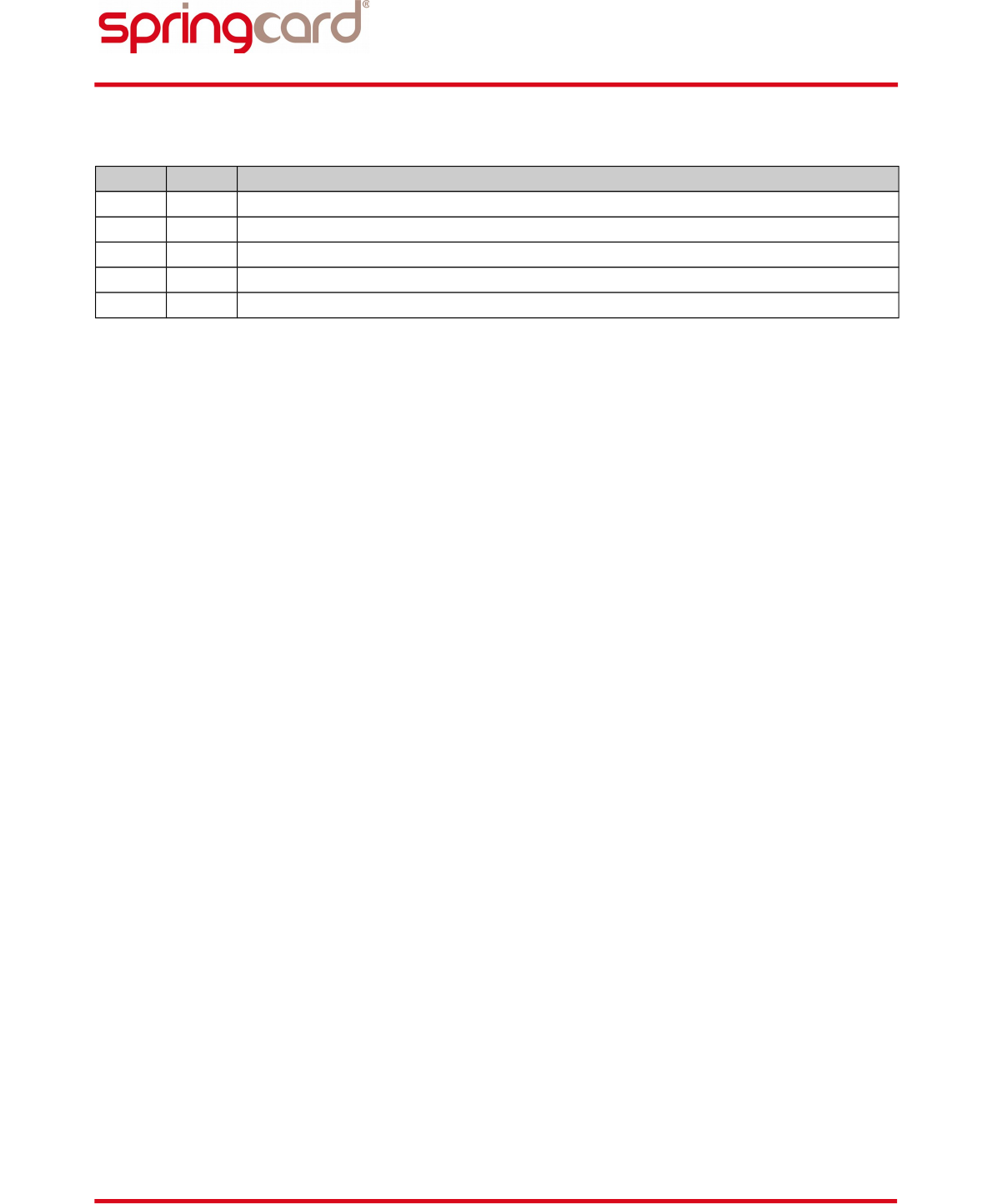
PMD2271-BA
page 25 of 118
SPRINGCARD PC/SC COUPLERS - H663 GROUP - Developer's reference manual
LOAD KEY status word
SW1 SW2 Meaning
h90 h00 Success
h69 h86 Volatile memory is not available
h69 h87 Non-volatile memory is not available
h69 h88 Key index (P2) is not in the allowed range
h69 h89 Key length (Lc) is not valid
SPRINGCARD, the SPRINGCARD logo, PRO ACTIVE and the PRO ACTIVE logo are registered trademarks of PRO ACTIVE SAS.
All other brand names, product names, or trademarks belong to their respective holders.
Information in this document is subject to change without notice. Reproduction without written permission of PRO ACTIVE is forbidden.
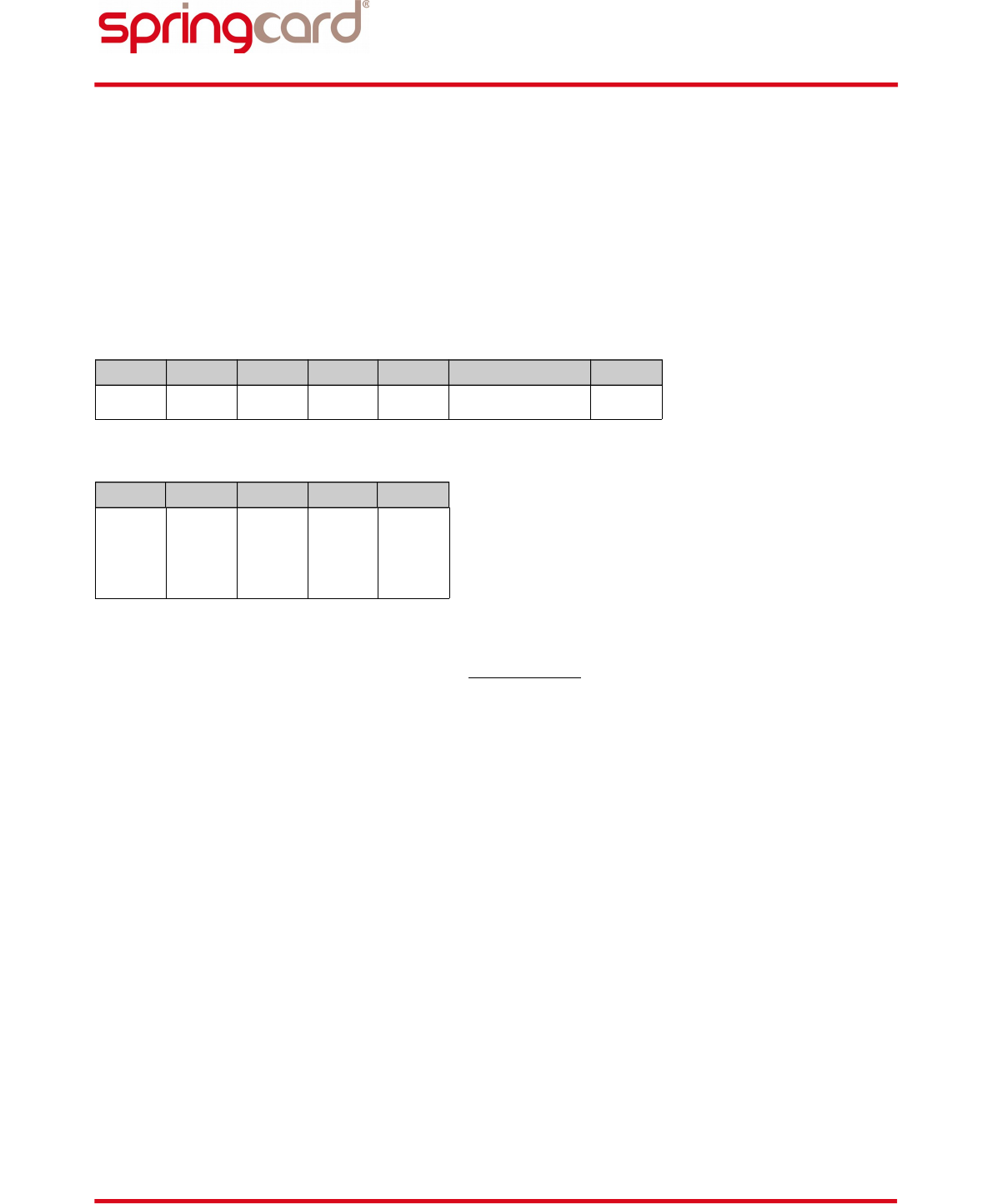
PMD2271-BA
page 26 of 118
SPRINGCARD PC/SC COUPLERS - H663 GROUP - Developer's reference manual
3.2.3. GENERAL AUTHENTICATE instruction
The GENERAL AUTHENTICATE instruction performs a Mifare Classic authentication (CRYPTO1).
The application must provide the index of the key to be used; this key must have been loaded into
the H663 through a previous LOAD KEY instruction.
Do not invoke this function if the currently activated PICC is not a Mifare Classic!
GENERAL AUTHENTICATE command APDU
CLA INS P1 P2 Lc Data In Le
hFF h86 h00 h00 h05 See below -
GENERAL AUTHENTICATE Data In bytes
Byte 0 Byte 1 Byte 2 Byte 3 Byte 4
h01 h00 Block
number
Key
location
or Key
type
Key
index
The block number (byte 2) is the address on the Mifare card, where the application tries to be
authenticated (note: this is the block number, not the sector number).
The key location or Key type (byte 3) must be either:
h60 for authentication using a CRYPTO1 “A” key (standard PC/SC-defined value),
h61 for authentication using a CRYPTO1 “B” key (standard PC/SC-defined value),
Same value as the P1 parameter used in the LOAD KEY instruction: h00 or h20 (SpringCard
specific value).
The key index (byte 4) is defined as follow:
If key type (byte 3) is h60, use values h00 to h03 to select one of the “A” keys stored in the H663's
volatile memory, and values h20 to h2F to select one of the “A” keys stored in the H663's non-
volatile memory (if available),
If key type (byte 3) is h61, use values h00 to h03 to select one of the “B” keys stored in the H663's
volatile memory, and values h20 to h2F to select one of the “B” keys stored in the H663's non-
volatile memory (if available),
If key type (byte 3) is either h00 or h20 (same value as the P1 parameter used in the LOAD key
instruction), choose one of the values allowed for the P2 parameter in the same LOAD key
instruction (SpringCard specific value).
SPRINGCARD, the SPRINGCARD logo, PRO ACTIVE and the PRO ACTIVE logo are registered trademarks of PRO ACTIVE SAS.
All other brand names, product names, or trademarks belong to their respective holders.
Information in this document is subject to change without notice. Reproduction without written permission of PRO ACTIVE is forbidden.
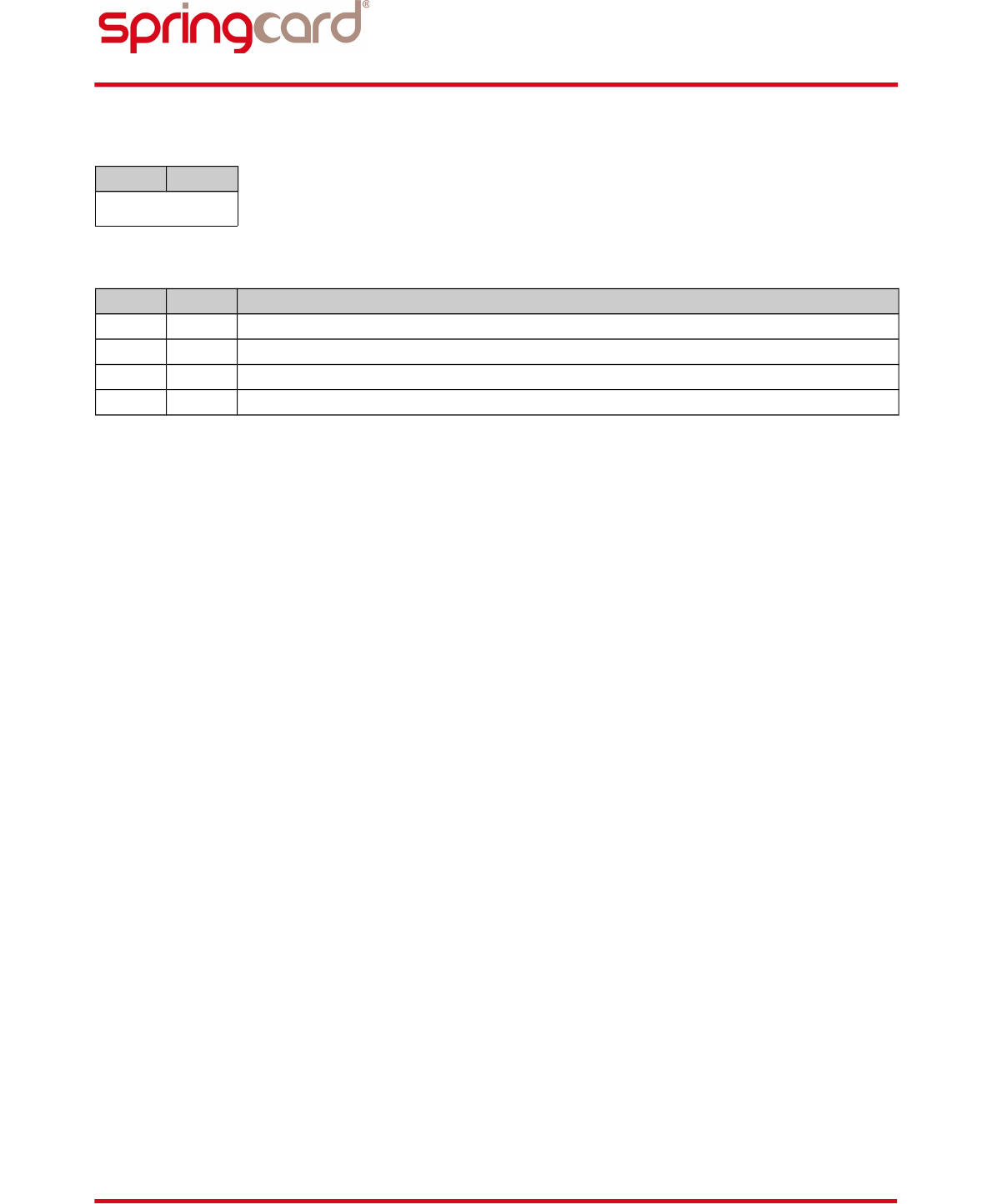
PMD2271-BA
page 27 of 118
SPRINGCARD PC/SC COUPLERS - H663 GROUP - Developer's reference manual
GENERAL AUTHENTICATE response
SW1 SW2
See below
GENERAL AUTHENTICATE status word
SW1 SW2 Meaning
h90 h00 Success
h69 h82 CRYPTO1 authentication failed
h69 h86 Key location or type (byte 3) is not valid (or not available for this coupler)
h69 h88 Key index (byte 4) is not in the allowed range
SPRINGCARD, the SPRINGCARD logo, PRO ACTIVE and the PRO ACTIVE logo are registered trademarks of PRO ACTIVE SAS.
All other brand names, product names, or trademarks belong to their respective holders.
Information in this document is subject to change without notice. Reproduction without written permission of PRO ACTIVE is forbidden.
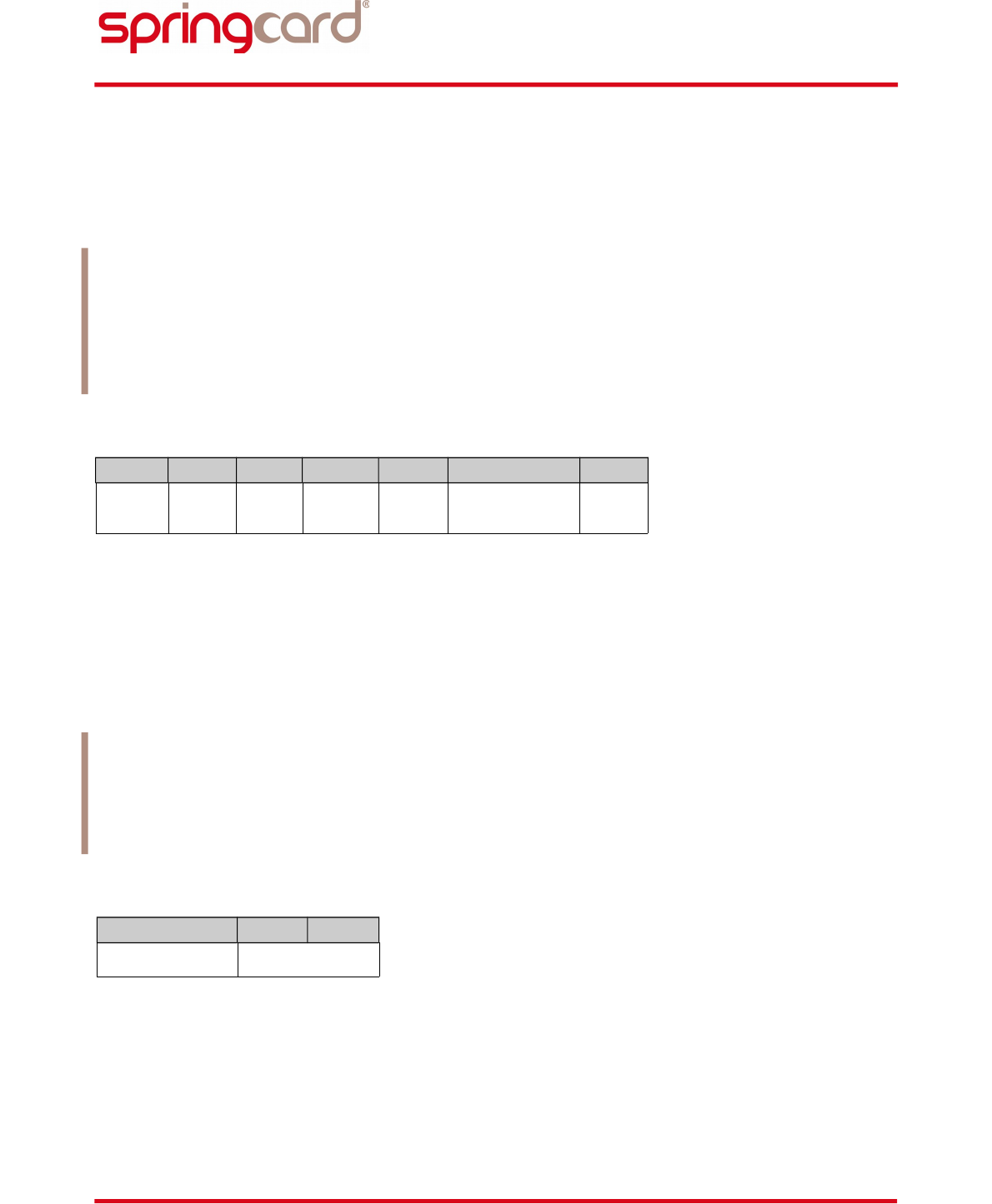
PMD2271-BA
page 28 of 118
SPRINGCARD PC/SC COUPLERS - H663 GROUP - Developer's reference manual
3.2.4. READ BINARY instruction
The READ BINARY instruction retrieves data from a memory card (wired-logic PICC or VICC). Refer
to chapter 4 for details.
For any PICC/VICC but Mifare Classic, this instruction is executed without any prerequisite.
For Mifare Classic, to be able to read the sector's data, the application must be authenticated on
the card's sector. The application must therefore invoke GENERAL AUTHENTICATE instruction
(with a valid key A or key B for the sector) before invoking the READ BINARY instruction. Using the
MIFARE CLASSIC READ instruction instead (§ 3.3.1) could be easier and may shorten the
transaction time.
READ BINARY command APDU
CLA INS P1 P2 Lc Data In Le
hFF hB0 Address
MSB
Address
LSB
- - XX
P1 and P2 form the address that will be sent to the PICC/VICC in its specific read command. Most
PICC/VICC are divided into small blocks (sometimes called pages). The address is a block number,
and not to an absolute byte offset in memory.
Both the allowed range for the address and the value for Le depend on the capabilities of the
PICC/VICC. Please always refer to its datasheet for details. Note that Le = h00 should always work,
provided that the address is valid.
For Mifare Classic, P1,P2 is the address of the block (h0000 to h00FF), but remember that the
authentication is made on a per-sector basis. A new authentication must be performed every time
you have to access another sector.
For a NFC Type 2 Tag, P2 is the block number, and P1 the sector number if the PICC supports this
feature. Set P1 to h00 if it is not the case.
READ BINARY response
Data Out SW1 SW2
XX … XX See below
SPRINGCARD, the SPRINGCARD logo, PRO ACTIVE and the PRO ACTIVE logo are registered trademarks of PRO ACTIVE SAS.
All other brand names, product names, or trademarks belong to their respective holders.
Information in this document is subject to change without notice. Reproduction without written permission of PRO ACTIVE is forbidden.
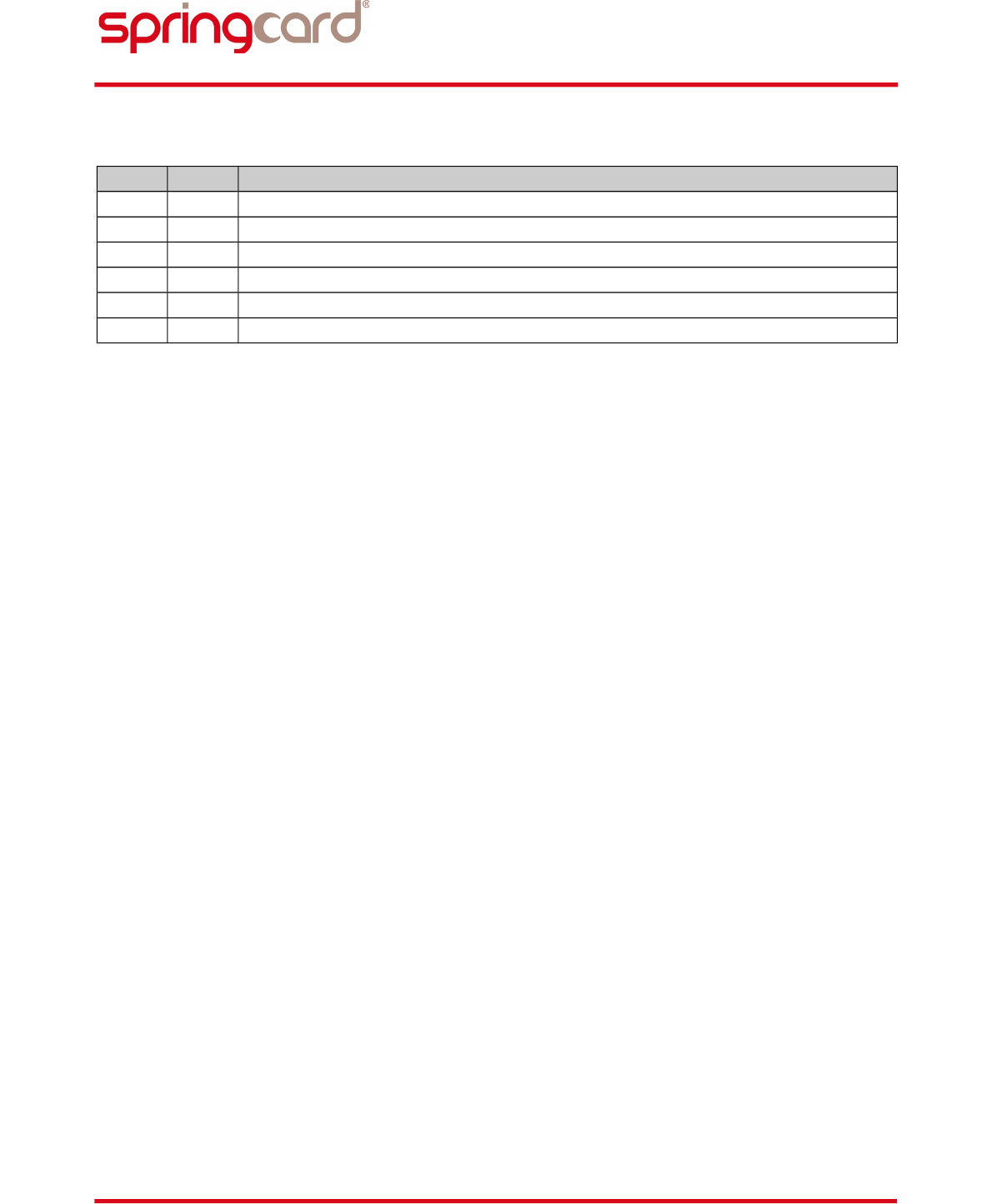
PMD2271-BA
page 29 of 118
SPRINGCARD PC/SC COUPLERS - H663 GROUP - Developer's reference manual
READ BINARY status word
SW1 SW2 Will return in Data Out
h90 h00 Success
h62 h82 End of data reached before Le bytes (Le is greater than data length)
h69 h81 Command incompatible
h69 h82 Security status not satisfied
h6A h82 Wrong address (no such block or no such offset in the PICC/VICC)
h6C XX Wrong length (Le is shorter than data length, XX in SW2 gives the correct value)
SPRINGCARD, the SPRINGCARD logo, PRO ACTIVE and the PRO ACTIVE logo are registered trademarks of PRO ACTIVE SAS.
All other brand names, product names, or trademarks belong to their respective holders.
Information in this document is subject to change without notice. Reproduction without written permission of PRO ACTIVE is forbidden.
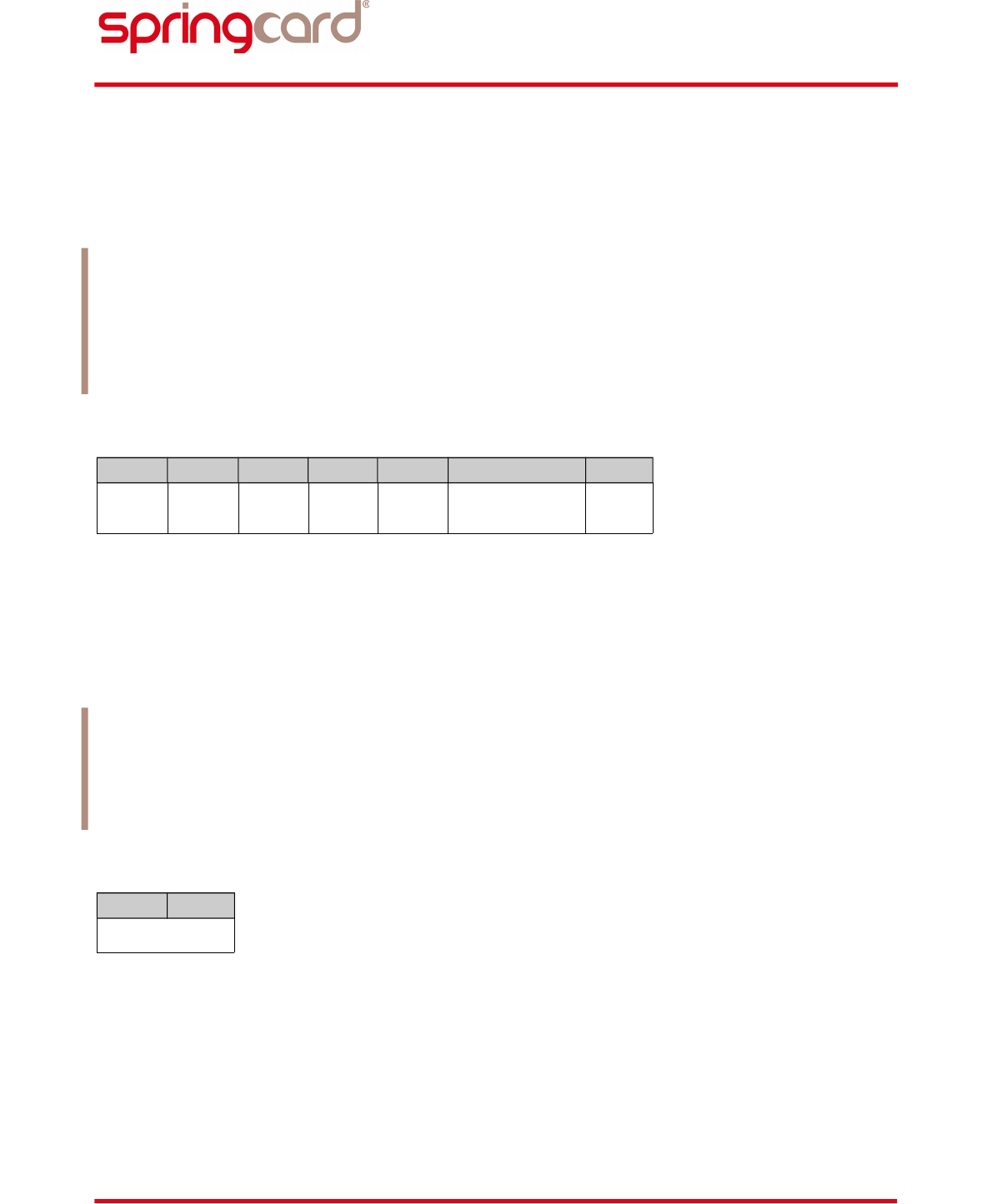
PMD2271-BA
page 30 of 118
SPRINGCARD PC/SC COUPLERS - H663 GROUP - Developer's reference manual
3.2.5. UPDATE BINARY instruction
The UPDATE BINARY instruction writes data into a memory card (wired-logic PICC or VICC). Refer
to chapter 4 for details.
For any PICC/VICC but Mifare Classic, this instruction is executed without any prerequisite.
For Mifare Classic, to be able to read the sector's data, the application must be authenticated on
the card's sector. Your application must always invoke GENERAL AUTHENTICATE instruction (with
a valid key A or key B for the sector) before invoking the UPDATE BINARY instruction. Using the
MIFARE CLASSIC WRITE instruction instead (§ 3.3.2) could be easier and may shorten the
transaction time.
UPDATE BINARY command APDU
CLA INS P1 P2 Lc Data In Le
hFF hD6 Address
MSB
Address
LSB
XX Data -
P1 and P2 form the address that will be sent to the PICC/VICC in its specific write command. Most
PICC/VICC are divided into small blocks (sometimes called pages). The address is a block number,
and not to an absolute byte offset in memory.
Both the allowed range for the address and the value for Lc depend on the capabilities of the PICC.
Please always refer to its datasheet for details.
For Mifare Classic, P1,P2 is the address of the block (h0000 to h00FF), but remember that the
authentication is made on a per-sector basis. A new authentication must be performed every time
you have to access another sector. Lc must be h10 (a block is 16-B long).
For a NFC Type 2 Tag, P2 is the block number, and P1 the sector number if the PICC does support
this feature. Set P1 to h00 if it is not the case. Lc must be h04 (a block is 4-B long).
UPDATE BINARY response
SW1 SW2
See below
SPRINGCARD, the SPRINGCARD logo, PRO ACTIVE and the PRO ACTIVE logo are registered trademarks of PRO ACTIVE SAS.
All other brand names, product names, or trademarks belong to their respective holders.
Information in this document is subject to change without notice. Reproduction without written permission of PRO ACTIVE is forbidden.
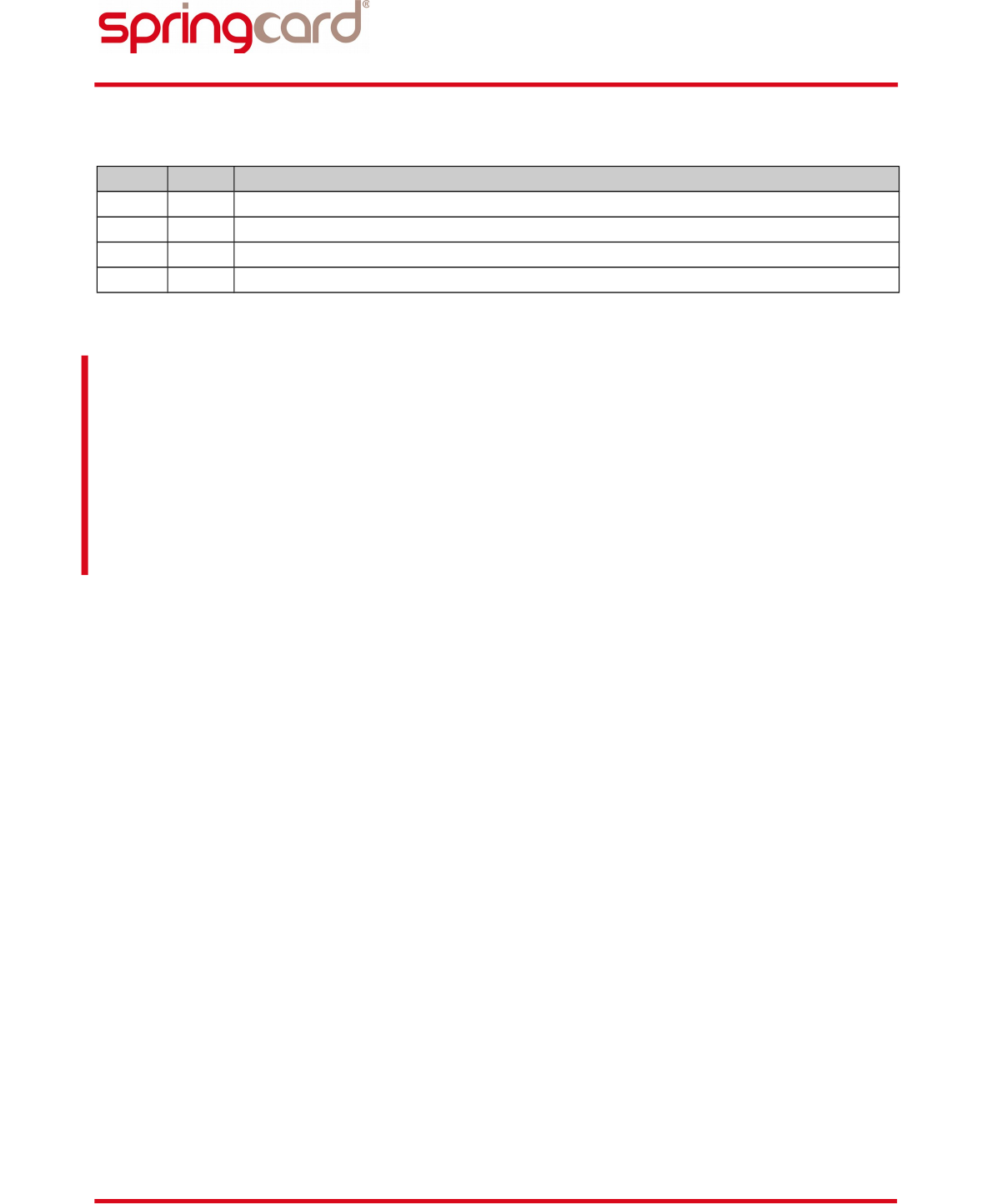
PMD2271-BA
page 31 of 118
SPRINGCARD PC/SC COUPLERS - H663 GROUP - Developer's reference manual
UPDATE BINARY status word
SW1 SW2 Will return in Data Out
h90 h00 Success
h69 h82 Security status not satisfied
h6A h82 Wrong address (no such block or no such offset in the PICC)
h6A h84 Wrong length (trying to write too much data at once)
Important disclaimer
Most PICC/VICC have specific areas:
- that can be written only once (OTP: one time programming or fuse bits),
- and/or that must be written carefully because they are involved in the security scheme of the
chip (lock bits),
- and/or because writing an invalid value will make the card unusable (sector trailer of a Mifare
Classic for instance).
Before invoking UPDATE BINARY, always double check where you're writing, and for the sensitive
addresses, what you're writing!
SPRINGCARD, the SPRINGCARD logo, PRO ACTIVE and the PRO ACTIVE logo are registered trademarks of PRO ACTIVE SAS.
All other brand names, product names, or trademarks belong to their respective holders.
Information in this document is subject to change without notice. Reproduction without written permission of PRO ACTIVE is forbidden.
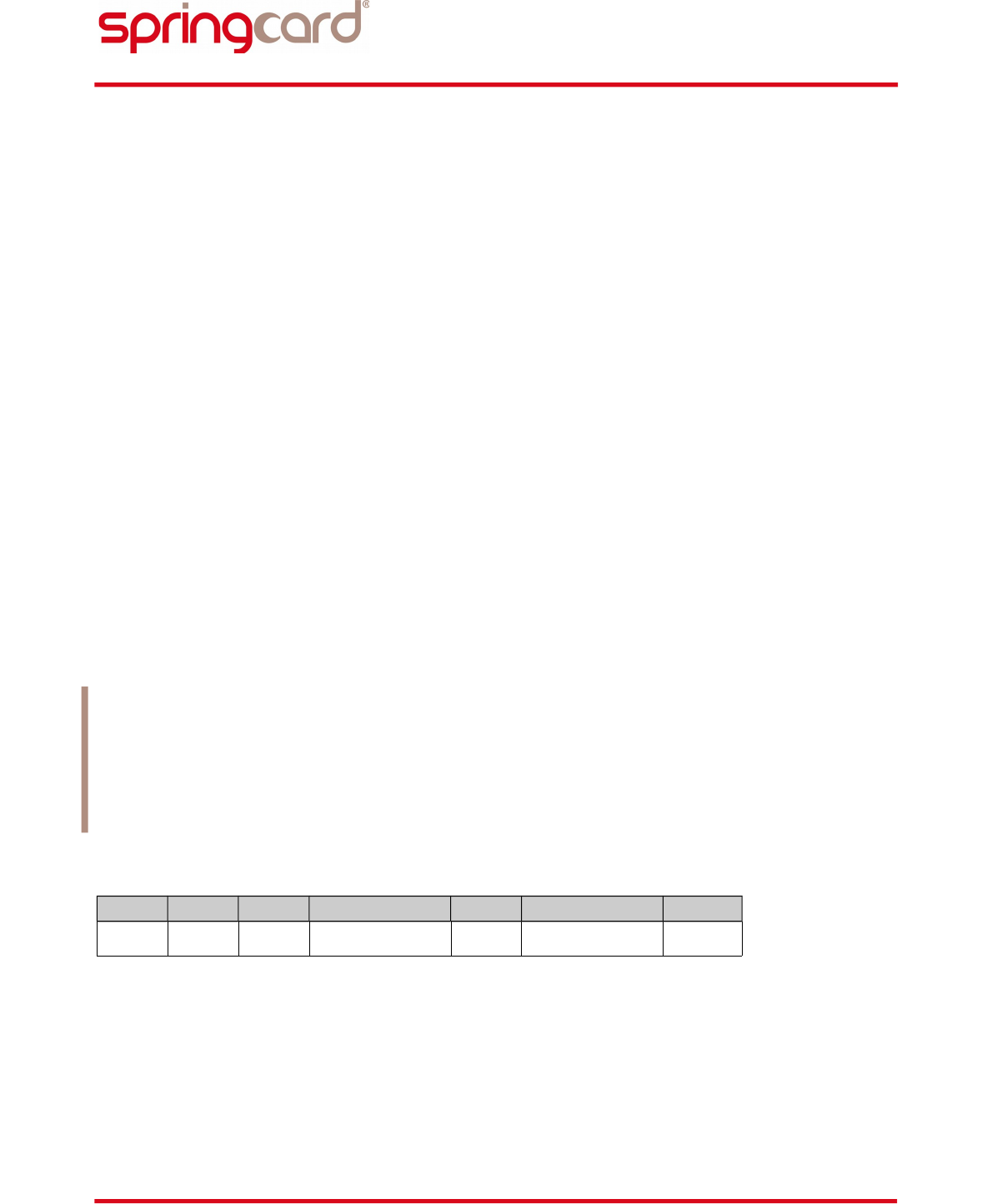
PMD2271-BA
page 32 of 118
SPRINGCARD PC/SC COUPLERS - H663 GROUP - Developer's reference manual
3.3. SPRINGCARD-SPECIFIC INSTRUCTIONS FOR THE CONTACTLESS SLOT
3.3.1. MIFARE CLASSIC READ instruction
The MIFARE CLASSIC READ instruction retrieves data from a Mifare Classic PICC (e.g. Mifare 1K or
Mifare 4K, or Mifare Plus in level 1).
The difference with READ BINARY lies in the authentication scheme:
With the READ BINARY instruction, authentication must be performed before, using the
GENERAL AUTHENTICATE instruction,
With the MIFARE CLASSIC READ instruction, the authentication is performed automatically
by the H663, trying every keys one after the other, until one succeed.
This “automatic” authentication makes MIFARE CLASSIC READ instruction an interesting helper to
read Mifare data easily.
Do not invoke this function if the currently activated PICC is not a Mifare Classic!
a. MIFARE CLASSIC READ using coupler’s keys
In this mode, the application doesn't specify anything. The H663 tries every keys he knows (both
permanent keys in E2PROM and temporary keys previously loaded in volatile memory – use LOAD
KEY to do so) until one succeeds.
Since the coupler must try all the keys, this method may take up to 1000ms. The ordering of the
keys in coupler's memory is very important to speed-up the process: the upper the right key is in
the coupler's memory, the sooner the authentication will succeed.
Note that the coupler tries all “type A” keys first, and only afterwards all the “type B” keys. This
behaviour has been chosen because in 95% of Mifare applications, the “type A” key is the
preferred key for reading (where the “type B” key is used for writing).
MIFARE CLASSIC READ command APDU
CLA INS P1 P2 Lc Data In Le
hFF hF3 h00 Block Number - - XX
Refer to the READ BINARY command (§ 3.2.4) for response and status words.
SPRINGCARD, the SPRINGCARD logo, PRO ACTIVE and the PRO ACTIVE logo are registered trademarks of PRO ACTIVE SAS.
All other brand names, product names, or trademarks belong to their respective holders.
Information in this document is subject to change without notice. Reproduction without written permission of PRO ACTIVE is forbidden.
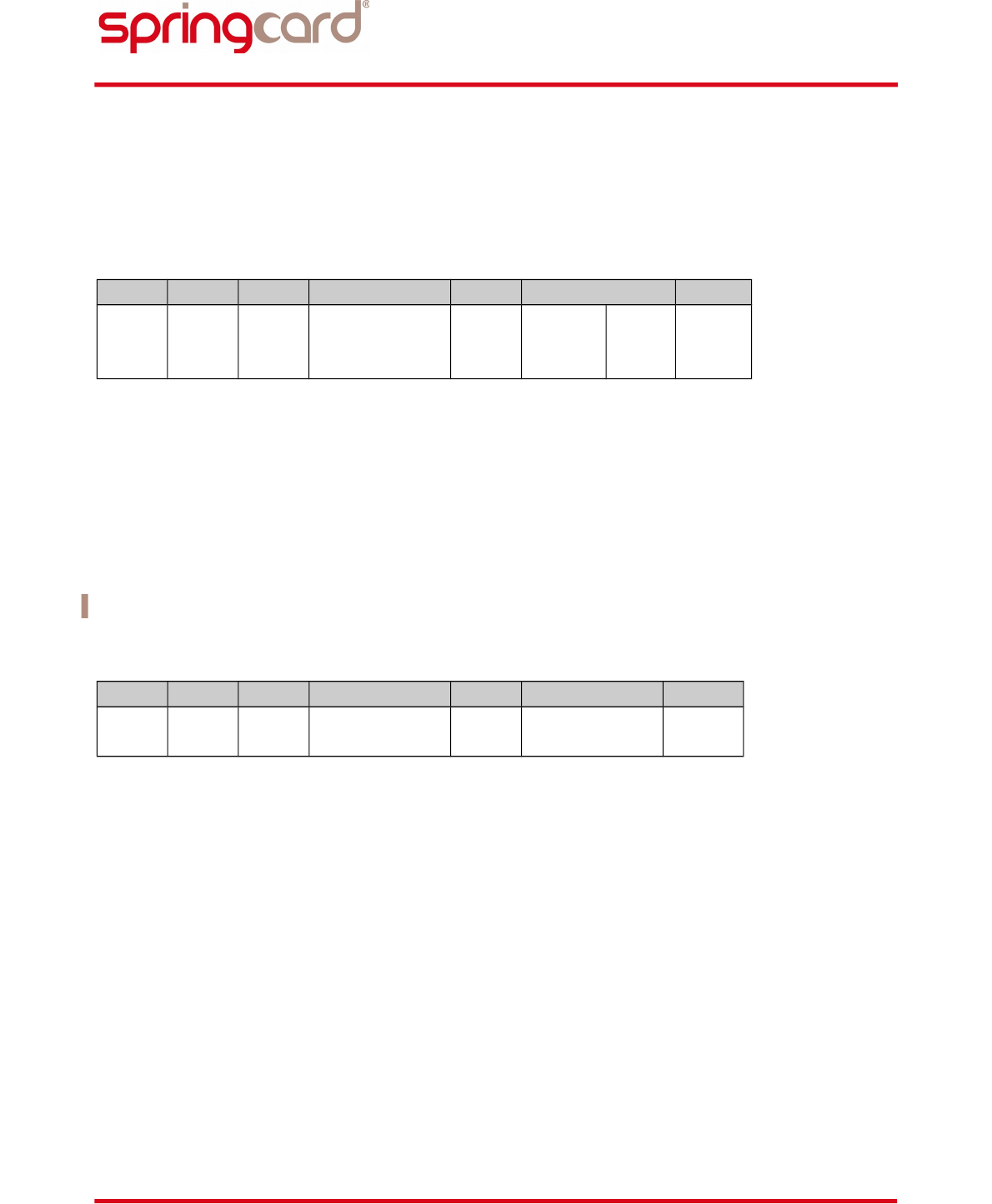
PMD2271-BA
page 33 of 118
SPRINGCARD PC/SC COUPLERS - H663 GROUP - Developer's reference manual
b. MIFARE CLASSIC READ selecting a key in the coupler
In this mode, the application chooses one of the key previously loaded in the H663 through the
LOAD KEY instruction.
MIFARE CLASSIC READ command APDU, selecting a key
CLA INS P1 P2 Lc Data In Le
hFF hF3 h00 Block Number h02
Key
Location
or Type
Key
Index XX
The understanding and values for bytes Key location or Key type and Key index are documented
in § 3.2.3 (GENERAL AUTHENTICATE instruction).
Refer to the READ BINARY instruction (§ 3.2.4) for response and status words.
c. MIFARE CLASSIC READ with specified key
In this mode, the application provides the 6-B value of the key to the H663.
The coupler tries the key as a “type A” first, and only afterwards as a “type B”.
MIFARE CLASSIC READ command APDU, with specified key
CLA INS P1 P2 Lc Data In Le
hFF hF3 h00 Block Number h06 Key value
(6 bytes) XX
Refer to the READ BINARY instruction (§ 3.2.4) for response and status words.
SPRINGCARD, the SPRINGCARD logo, PRO ACTIVE and the PRO ACTIVE logo are registered trademarks of PRO ACTIVE SAS.
All other brand names, product names, or trademarks belong to their respective holders.
Information in this document is subject to change without notice. Reproduction without written permission of PRO ACTIVE is forbidden.

PMD2271-BA
page 34 of 118
SPRINGCARD PC/SC COUPLERS - H663 GROUP - Developer's reference manual
3.3.2. MIFARE CLASSIC WRITE instruction
The MIFARE CLASSIC WRITE instruction writes data into a Mifare Classic PICC (e.g. Mifare 1K or
Mifare 4K, or Mifare Plus in level 1).
The difference with UPDATE BINARY lies in the authentication scheme:
With the UPDATE BINARY instruction, authentication must be performed before, using the
GENERAL AUTHENTICATE instruction,
With the MIFARE CLASSIC WRITE instruction, the authentication is performed
automatically by the H663, trying every keys one after the other, until one succeed.
This “automatic” authentication makes MIFARE CLASSIC WRITE instruction an interesting helper to
write Mifare data easily.
Do not invoke this function if the currently activated PICC is not a Mifare Classic!
Important disclaimer
Writing sector trailers (security blocks) is possible as long as the sector's current access condition
allows it, but Mifare sector trailers have to follow a specific formatting rule (mix-up of the access
conditions bits) to be valid. Otherwise, the sector becomes permanently unusable.
Before invoking MIFARE CLASSIC WRITE, always double check that you're not writing a sector
trailer, and if you really have to do so, make sure the new content is formatted as specified in the
datasheet of the PICC.
a. MIFARE CLASSIC WRITE using coupler’s keys
In this mode, the application doesn't specify anything. The H663 tries every key he knows (both
permanent keys in E2PROM and temporary keys previously loaded in volatile memory) until one
succeeds.
Since the coupler must try all the keys, this method may take up to 1000ms. The ordering of the
keys in coupler's memory is very important to speed-up the process: the upper the right key is in
the coupler's memory, the sooner the authentication will succeed.
Note that the coupler tries all “type B” keys first, and only afterwards all the “type A” keys. This
behaviour has been chosen because in 95% of Mifare applications, the “type B” key is the
preferred key for writing11.
11 Mifare Classic cards issued by NXP are delivered in “transport configuration”, with no “B” key and an “A” key allowed for both
reading and writing. This “transport configuration” gives poorest writing performance ; card issuer must start the card
personalisation process by enabling a “B” key for writing.
SPRINGCARD, the SPRINGCARD logo, PRO ACTIVE and the PRO ACTIVE logo are registered trademarks of PRO ACTIVE SAS.
All other brand names, product names, or trademarks belong to their respective holders.
Information in this document is subject to change without notice. Reproduction without written permission of PRO ACTIVE is forbidden.
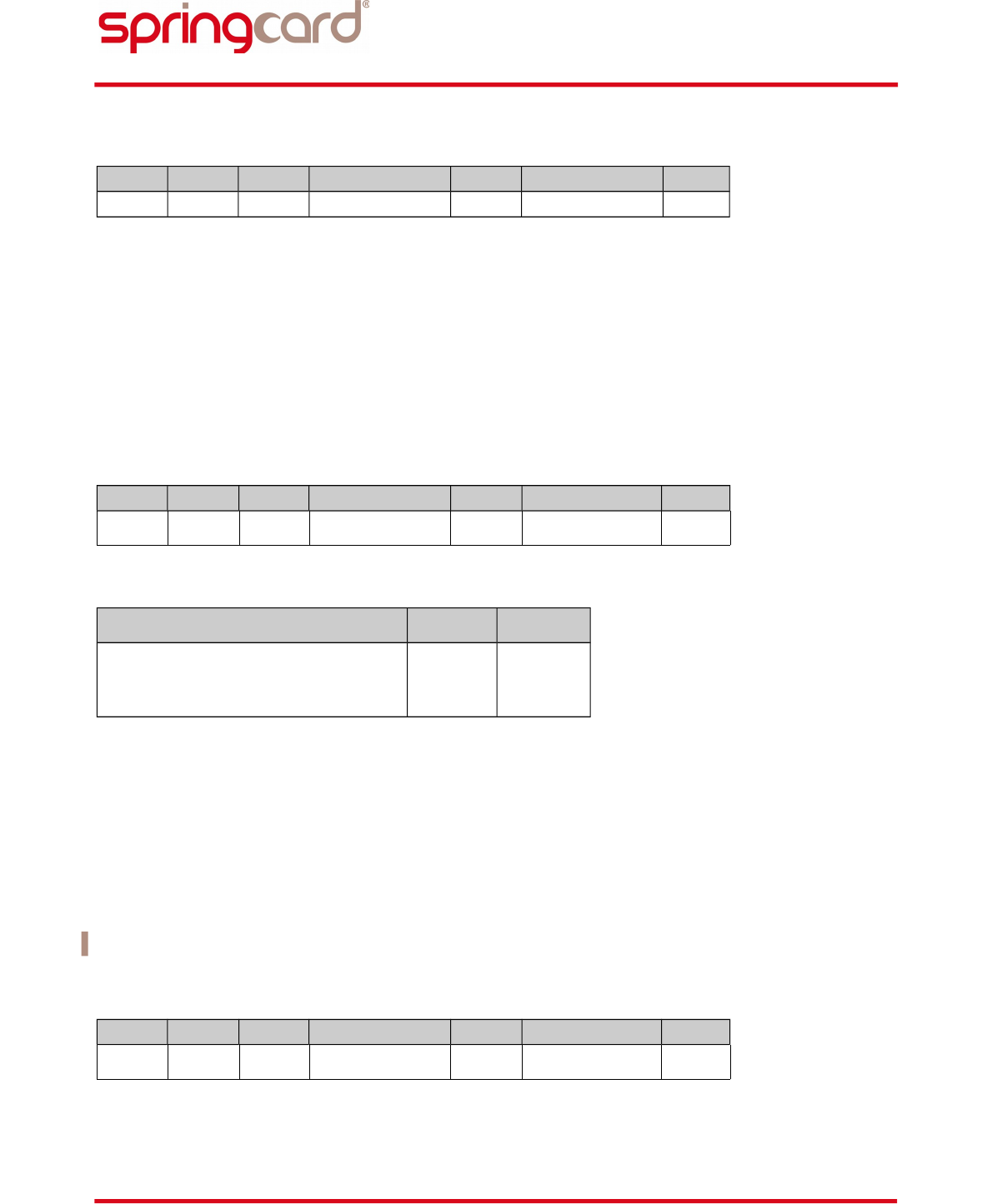
PMD2271-BA
page 35 of 118
SPRINGCARD PC/SC COUPLERS - H663 GROUP - Developer's reference manual
MIFARE CLASSIC WRITE command APDU
CLA INS P1 P2 Lc Data In Le
hFF hF4 h00 Block Number XX XX … XX -
Lc must be a multiple of 16.
Refer to the UPDATE BINARY instruction (§ 3.2.5) for response and status words.
b. MIFARE CLASSIC WRITE selecting a key in the coupler
In this mode, the application chooses one the key previously loaded in the H663 through the LOAD
KEY instruction.
MIFARE CLASSIC WRITE command APDU, selecting a key
CLA INS P1 P2 Lc Data In Le
hFF hF4 h00 Block Number XX See below -
MIFARE CLASSIC WRITE command APDU, selecting a key: Data In bytes
Bytes 0 to Lc-3 Byte Lc-2 Byte Lc-1
Data to be written
(multiple of 16 bytes)
Key
Location
or Type
Key Index
The understanding and values for bytes Key location or Key type and Key index are documented
in § 3.2.3 (GENERAL AUTHENTICATE instruction).
Refer to the UPDATE BINARY instruction (§ 3.2.5) for response and status words.
c. MIFARE CLASSIC WRITE with specified key
In this mode, the application provides the key to the H663.
The coupler tries the key as a “type B” first, and only afterwards as a “type A”.
MIFARE CLASSIC WRITE command APDU, with specified key
CLA INS P1 P2 Lc Data In Le
hFF hF4 h00 Block Number XX See below -
SPRINGCARD, the SPRINGCARD logo, PRO ACTIVE and the PRO ACTIVE logo are registered trademarks of PRO ACTIVE SAS.
All other brand names, product names, or trademarks belong to their respective holders.
Information in this document is subject to change without notice. Reproduction without written permission of PRO ACTIVE is forbidden.

PMD2271-BA
page 36 of 118
SPRINGCARD PC/SC COUPLERS - H663 GROUP - Developer's reference manual
MIFARE CLASSIC WRITE command APDU, with specified key: Data In Bytes
Bytes 0 to Lc-7 Bytes Lc-6 to Lc-1
Data to be written
(multiple of 16 bytes)
Key value
(6 bytes)
Lc = 6 + 16 x (number of blocks to be written).
Refer to the UPDATE BINARY instruction (§ 3.2.5) for response and status words.
SPRINGCARD, the SPRINGCARD logo, PRO ACTIVE and the PRO ACTIVE logo are registered trademarks of PRO ACTIVE SAS.
All other brand names, product names, or trademarks belong to their respective holders.
Information in this document is subject to change without notice. Reproduction without written permission of PRO ACTIVE is forbidden.

PMD2271-BA
page 37 of 118
SPRINGCARD PC/SC COUPLERS - H663 GROUP - Developer's reference manual
3.3.3. MIFARE CLASSIC VALUE instruction
The MIFARE CLASSIC VALUE instruction makes it possible to invoke the DECREMENT, INCREMENT,
and RESTORE functions of a Mifare Classic PICC (e.g. Mifare 1K or Mifare 4K, or Mifare Plus in level
1), followed by a TRANSFER function.
The DECREMENT, INCREMENT, RESTORE (and TRANSFER) functions could be performed only on the
blocks that have been formatted as VALUE block in the sector trailer (access condition bits). Do not
invoke this function on DATA blocks, and do not invoke this function if the currently activated PICC
is not a Mifare Classic!
MIFARE CLASSIC VALUE opcode, operand, and transfer address
The P1 parameter in the MIFARE CLASSIC VALUE command APDU in the PICCs' operation code
(opcode), as defined in Mifare Classic specification. Allowed values are:
hC1 for INCREMENT
hC0 for DECREMENT
hC2 for RESTORE
All three operations requires an operand. The operand is a 4-byte signed integer.
INCREMENT operation: the operand must be > 0 (between h00000001 and h7FFFFFFF). The
operand is added to the current value of the source block, and the result is kept by the
PICC in a register,
DECREMENT operation: the operand must be > 0 (between h00000001 and h7FFFFFFF). The
operand is subtracted from the current value of the source block, and the result is kept by
the PICC in a register,
RESTORE operation: the operand must be 0 (h00000000). The PICC copies the current value
of the source block into a register.
After the INCREMENT, DECREMENT or RESTORE operation has been performed by the PICC, the
H663 invokes the TRANSFER operation: the value of the register is written into a target block.
If the destination block number is not the same as the source block number, the original
value remains unchanged in the source block (this is a sort of “backup” feature),
If the destination block number is the same as the source block number, or not destination
block number is defined, then the source block is overwritten with the new value.
a. MIFARE CLASSIC VALUE using coupler’s keys
In this mode, the application doesn't specify anything. The H663 tries every keys he knows (both
permanent keys in E2PROM and temporary keys previously loaded in volatile memory) until one
succeeds.
SPRINGCARD, the SPRINGCARD logo, PRO ACTIVE and the PRO ACTIVE logo are registered trademarks of PRO ACTIVE SAS.
All other brand names, product names, or trademarks belong to their respective holders.
Information in this document is subject to change without notice. Reproduction without written permission of PRO ACTIVE is forbidden.
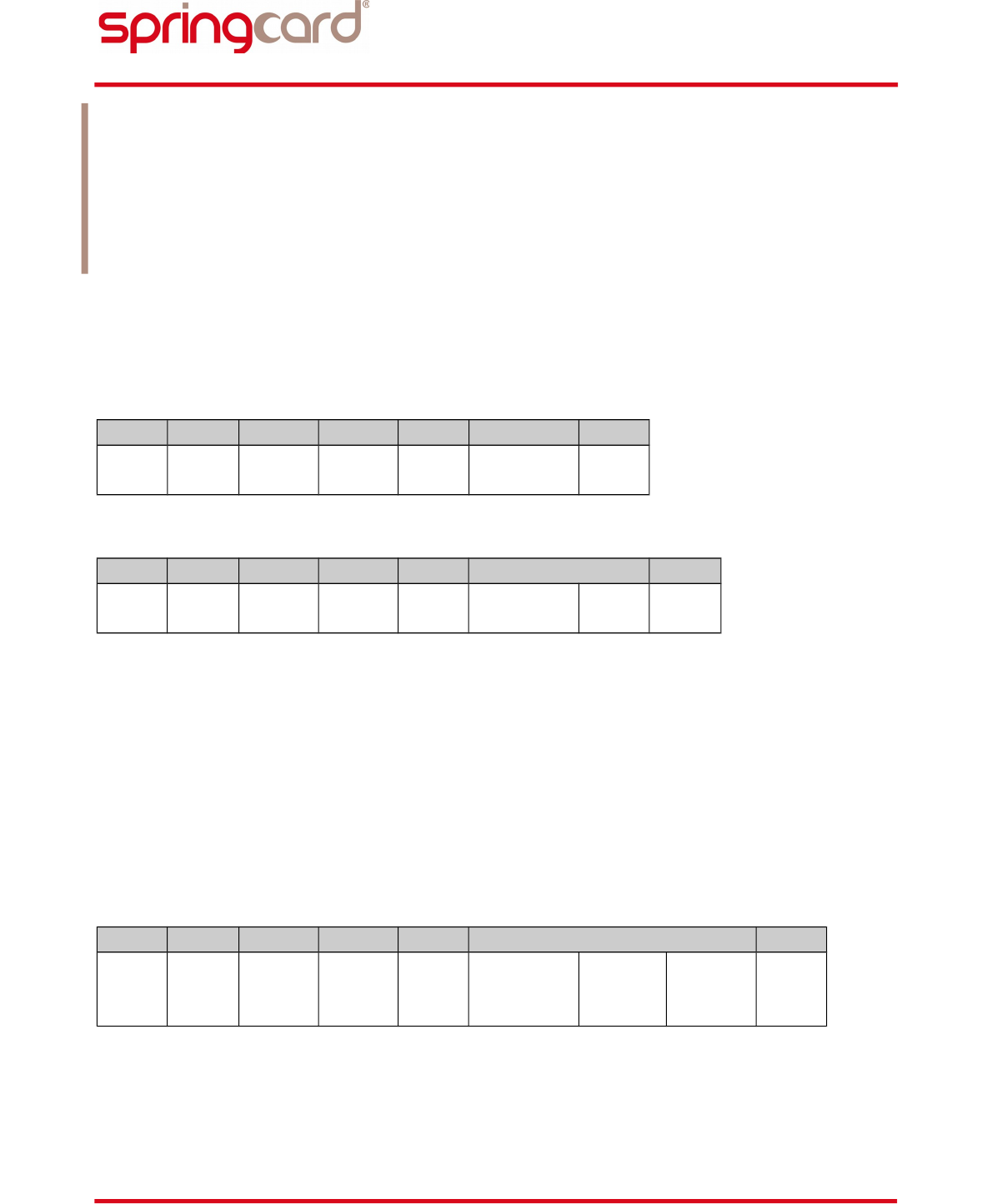
PMD2271-BA
page 38 of 118
SPRINGCARD PC/SC COUPLERS - H663 GROUP - Developer's reference manual
Because the coupler must try all the keys, this method can take up to 1000ms. The ordering of the
keys in coupler's memory is very important to speed-up the process: the upper the right key is in
the coupler's memory, the sooner the authentication will succeed.
For DECREMENT and RESTORE operations, the coupler tries all “type A” keys first, and only
afterwards all the “type B” keys.
For INCREMENT operation, the coupler tries all “type B” keys first, and only afterwards all the
“type A” keys.
The destination block could optionally be specified at the end of the command APDU. If not, the
source block is overwritten by the TRANSFER operation.
MIFARE CLASSIC VALUE command APDU, using coupler's key, without backup
CLA INS P1 P2 Lc Data In Le
hFF hF5 Opcode Source
block h04 Operand
(4B – MSB first) -
MIFARE CLASSIC VALUE command APDU, using coupler's key, with backup
CLA INS P1 P2 Lc Data In Le
hFF hF5 Opcode Source
block h05 Operand
(4B – MSB first)
Dest.
block -
Refer to the UPDATE BINARY instruction (§ 3.2.5) for response and status words.
b. MIFARE CLASSIC VALUE selecting a key in the coupler
In this mode, the application chooses one the key previously loaded in the H663 through the LOAD
KEY instruction.
The destination block could optionally be specified at the end of the command APDU. If not, the
source block is overwritten by the TRANSFER operation.
MIFARE CLASSIC VALUE command APDU, selecting a key, without backup
CLA INS P1 P2 Lc Data In Le
hFF hF5 Opcode Source
block h06 Operand
(4B – MSB first)
Key
location
or Type
Key
index -
SPRINGCARD, the SPRINGCARD logo, PRO ACTIVE and the PRO ACTIVE logo are registered trademarks of PRO ACTIVE SAS.
All other brand names, product names, or trademarks belong to their respective holders.
Information in this document is subject to change without notice. Reproduction without written permission of PRO ACTIVE is forbidden.
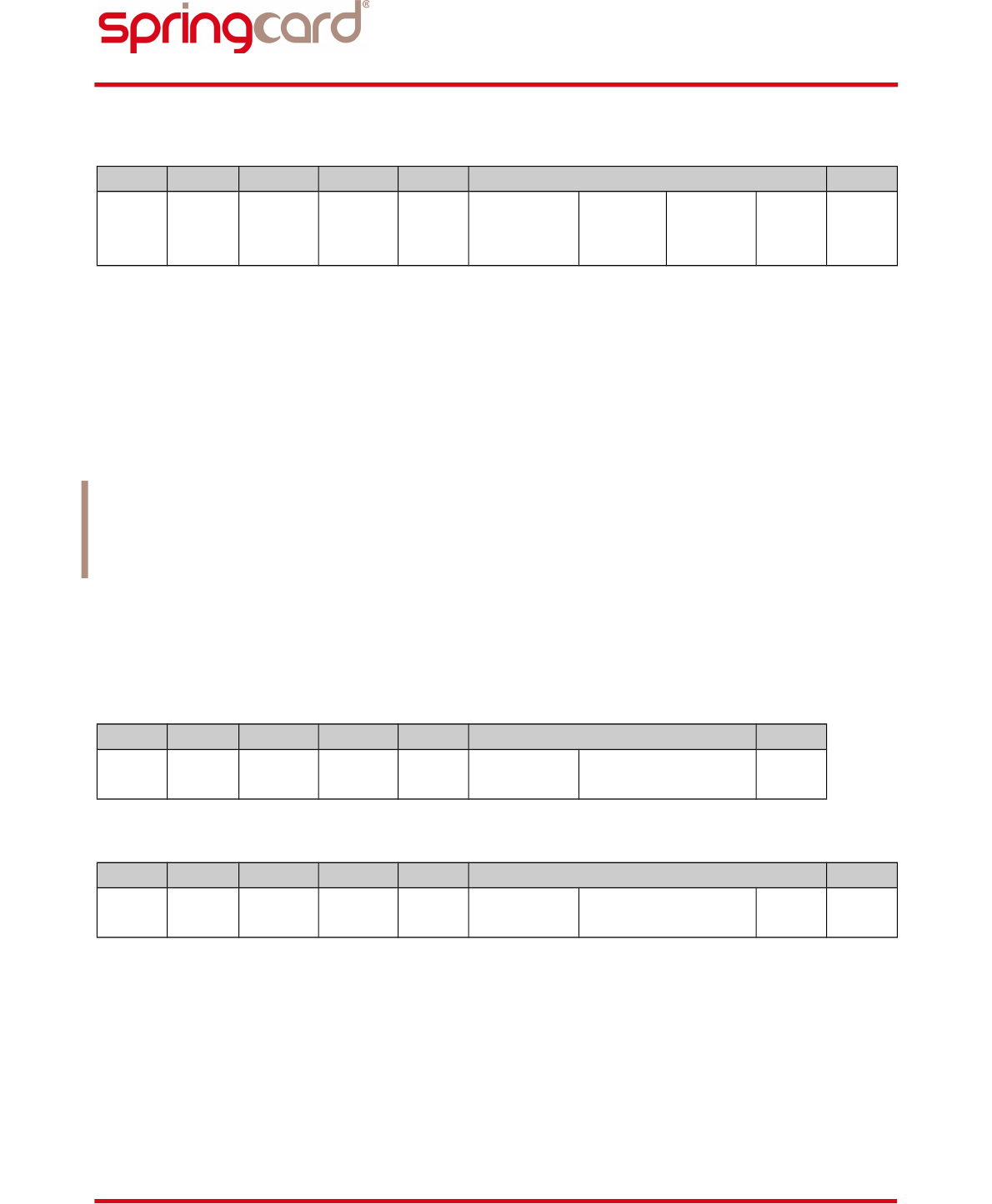
PMD2271-BA
page 39 of 118
SPRINGCARD PC/SC COUPLERS - H663 GROUP - Developer's reference manual
MIFARE CLASSIC VALUE command APDU, selecting a key, with backup
CLA INS P1 P2 Lc Data In Le
hFF hF5 Opcode Source
block h07 Operand
(4B – MSB first)
Key
location
or Type
Key
index
Dest.
block -
The understanding and values for bytes Key location or Key type and Key index are documented
in § 3.2.3 (GENERAL AUTHENTICATE instruction).
Refer to the UPDATE BINARY instruction (§ 3.2.5) for response and status words.
c. MIFARE CLASSIC VALUE with specified key
In this mode, the application provides the key to the H663.
For DECREMENT and RESTORE operations, the coupler tries the key as a “type A” first, and only
afterwards as a “type B”.
For INCREMENT operation, the coupler tries the key as a “type B” first, and only afterwards as a
“type A”.
The destination block could optionally be specified at the end of the command APDU. If not, the
source block is overwritten by the TRANSFER operation.
MIFARE CLASSIC VALUE command APDU, key specified, without backup
CLA INS P1 P2 Lc Data In Le
hFF hF5 Opcode Source
block h0A Operand
(4B – MSB first)
Key value
(6B) -
MIFARE CLASSIC VALUE command APDU, key specified, with backup
CLA INS P1 P2 Lc Data In Le
hFF hF5 Opcode Source
block h0B Operand
(4B – MSB first)
Key value
(6B)
Dest.
block -
Refer to the UPDATE BINARY instruction (§ 3.2.5) for response and status words.
SPRINGCARD, the SPRINGCARD logo, PRO ACTIVE and the PRO ACTIVE logo are registered trademarks of PRO ACTIVE SAS.
All other brand names, product names, or trademarks belong to their respective holders.
Information in this document is subject to change without notice. Reproduction without written permission of PRO ACTIVE is forbidden.
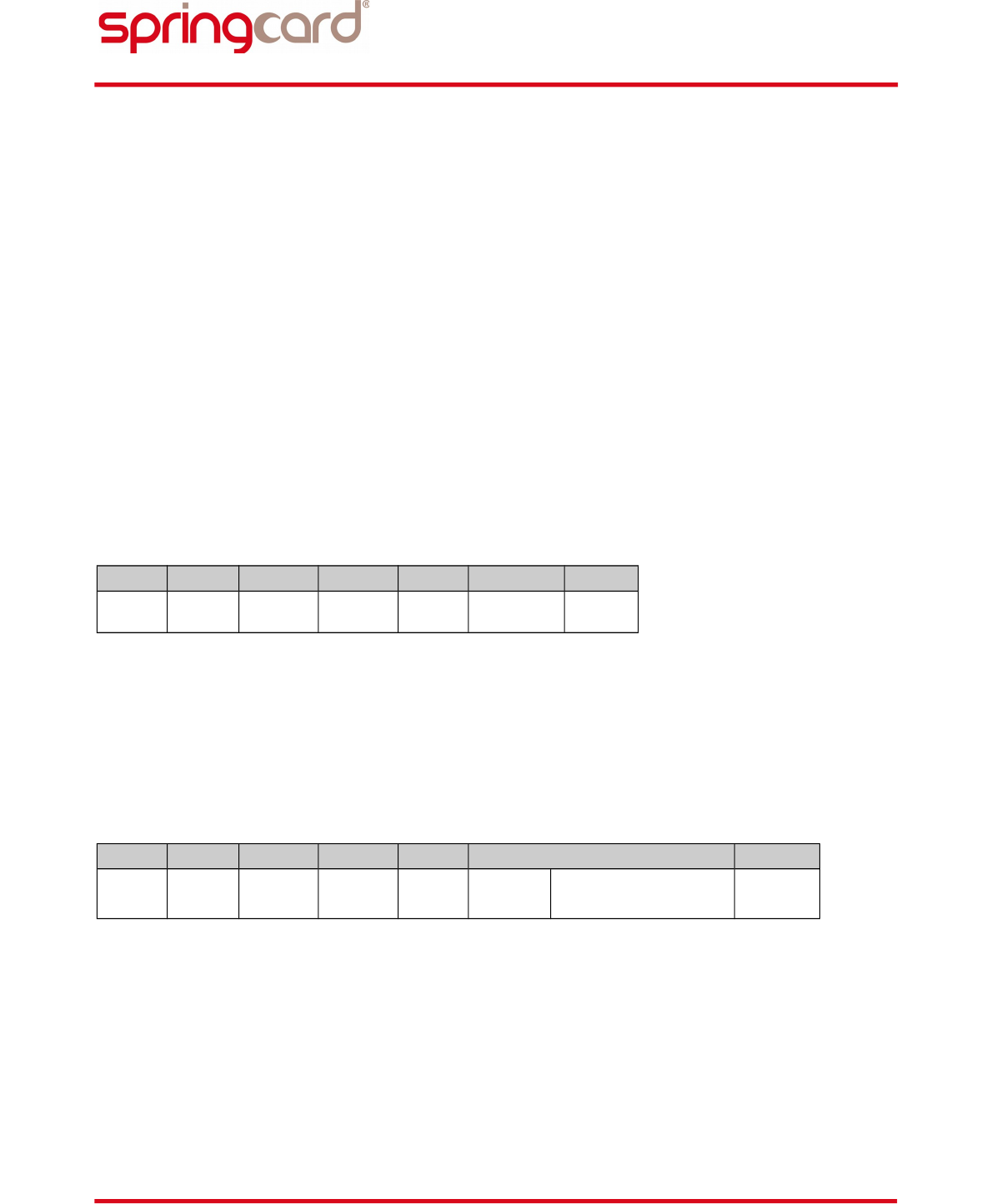
PMD2271-BA
page 40 of 118
SPRINGCARD PC/SC COUPLERS - H663 GROUP - Developer's reference manual
3.3.4. RFID MEMORY CONTROL instruction
The RFID MEMORY CONTROL instruction gives access to some functions of RFID wired-logic PICCs
or VICCs that have no equivalent in the smartcard world.
For instance, Reading to / Writing from a RFID memory chip maps to READ BINARY / UPDATE
BINARY which are “standards” instructions defined by ISO 7816. But ISO 7816 has no equivalent
for a lot of functions defined in ISO 15693, such as “Write DSFID”, “Lock AFI”, and much more.
Therefore, the RFID MEMORY CONTROL instruction is a SpringCard-defined function that eases
operating ISO 15693 and related VICCs, such as EM4134.
a. Read Single Block
This function is available for ISO 15693 and EM4134 VICCs.
This function is a low-level alternative to READ BINARY.
RFID MEMORY CONTROL : Read Single Block command APDU
CLA INS P1 P2 Lc Data In Le
hFF hF6 h20 h00 h01 Address
(1B) h00
b. Write Single Block
This function is available for ISO 15693 and EM4134 VICCs.
This function is a low-level alternative to UPDATE BINARY.
RFID MEMORY CONTROL : Write Single Block command APDU
CLA INS P1 P2 Lc Data In Le
hFF hF6 h21 h00 h01
+Len
Address
(1B)
Data
(Len) -
SPRINGCARD, the SPRINGCARD logo, PRO ACTIVE and the PRO ACTIVE logo are registered trademarks of PRO ACTIVE SAS.
All other brand names, product names, or trademarks belong to their respective holders.
Information in this document is subject to change without notice. Reproduction without written permission of PRO ACTIVE is forbidden.
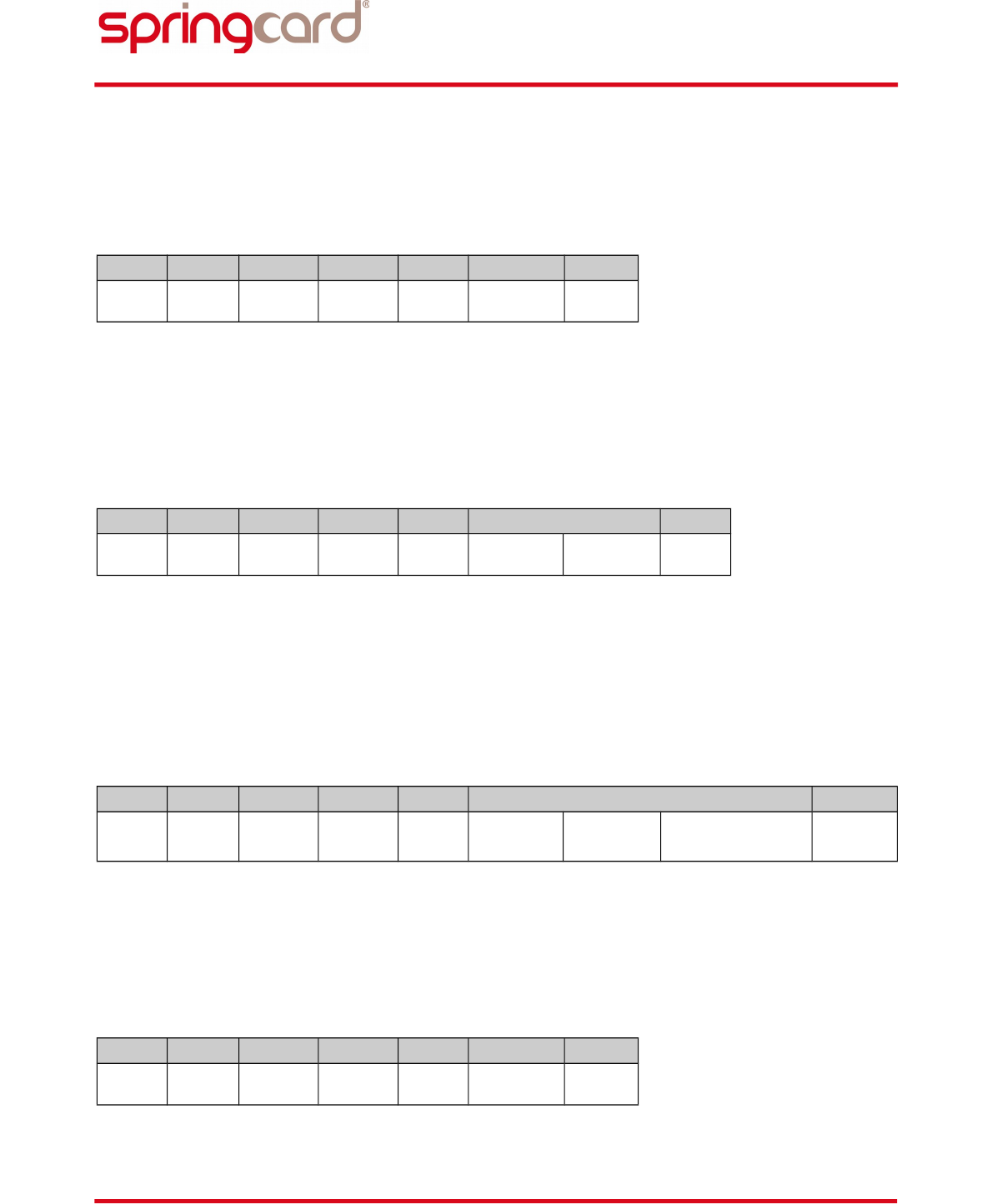
PMD2271-BA
page 41 of 118
SPRINGCARD PC/SC COUPLERS - H663 GROUP - Developer's reference manual
c. Lock Block
This function is available for ISO 15693 and EM4134 VICCs.
RFID MEMORY CONTROL : Lock Block command APDU
CLA INS P1 P2 Lc Data In Le
hFF hF6 h22 h00 h01 Address
(1B) -
d. Read Multiple Blocks
This function is available for ISO 15693 VICCs only.
This function is a low-level alternative to READ BINARY.
RFID MEMORY CONTROL : Read Multiple Blocks command APDU
CLA INS P1 P2 Lc Data In Le
hFF hF6 h23 h00 h01 Address
(1B)
Count
(1B) h00
e. Write Multiple Blocks
This function is available for ISO 15693 VICCs only.
This function is a low-level alternative to UPDATE BINARY.
RFID MEMORY CONTROL : Write Multiple Block command APDU
CLA INS P1 P2 Lc Data In Le
hFF hF6 h24 h00 h02
+Len
Address
(1B)
Count
(1B)
Data
(Len) -
f. Write AFI
This function is available for ISO 15693 VICCs only.
RFID MEMORY CONTROL : Write AFI command APDU
CLA INS P1 P2 Lc Data In Le
hFF hF6 h27 h00 h01 AFI
(1B) -
SPRINGCARD, the SPRINGCARD logo, PRO ACTIVE and the PRO ACTIVE logo are registered trademarks of PRO ACTIVE SAS.
All other brand names, product names, or trademarks belong to their respective holders.
Information in this document is subject to change without notice. Reproduction without written permission of PRO ACTIVE is forbidden.
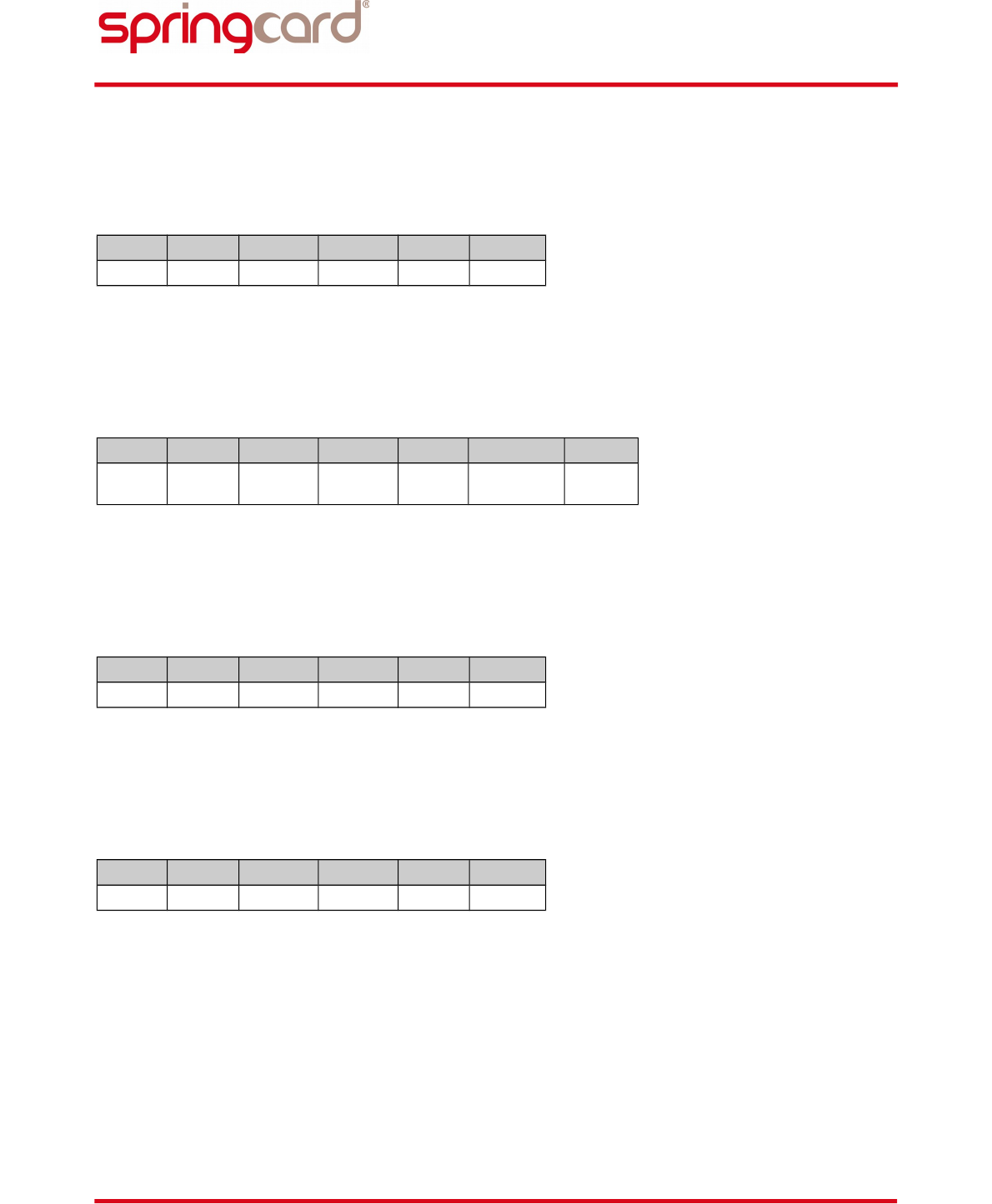
PMD2271-BA
page 42 of 118
SPRINGCARD PC/SC COUPLERS - H663 GROUP - Developer's reference manual
g. Lock AFI
This function is available for ISO 15693 VICCs only.
RFID MEMORY CONTROL : Lock AFI command APDU
CLA INS P1 P2 Lc Le
hFF hF6 h28 h00 h00 -
h. Write DSFID
This function is available for ISO 15693 VICCs only.
RFID MEMORY CONTROL : Write DSFID command APDU
CLA INS P1 P2 Lc Data In Le
hFF hF6 h29 h00 h01 DSFID
(1B) -
i. Lock DSFID
This function is available for ISO 15693 VICCs only.
RFID MEMORY CONTROL : Lock DSFID command APDU
CLA INS P1 P2 Lc Le
hFF hF6 h2A h00 h00 -
j. Get System Information
This function is available for ISO 15693 VICCs only.
RFID MEMORY CONTROL : Get System Information command APDU
CLA INS P1 P2 Lc Le
hFF hF6 h2A h00 - h00
Note: the H663 always sends the Get system information command to the VICC, as part of the
discovery process. Invoke the GET DATA instruction (§ 3.2.1) to retrieve the value already returned
by the VICC to the H663.
SPRINGCARD, the SPRINGCARD logo, PRO ACTIVE and the PRO ACTIVE logo are registered trademarks of PRO ACTIVE SAS.
All other brand names, product names, or trademarks belong to their respective holders.
Information in this document is subject to change without notice. Reproduction without written permission of PRO ACTIVE is forbidden.
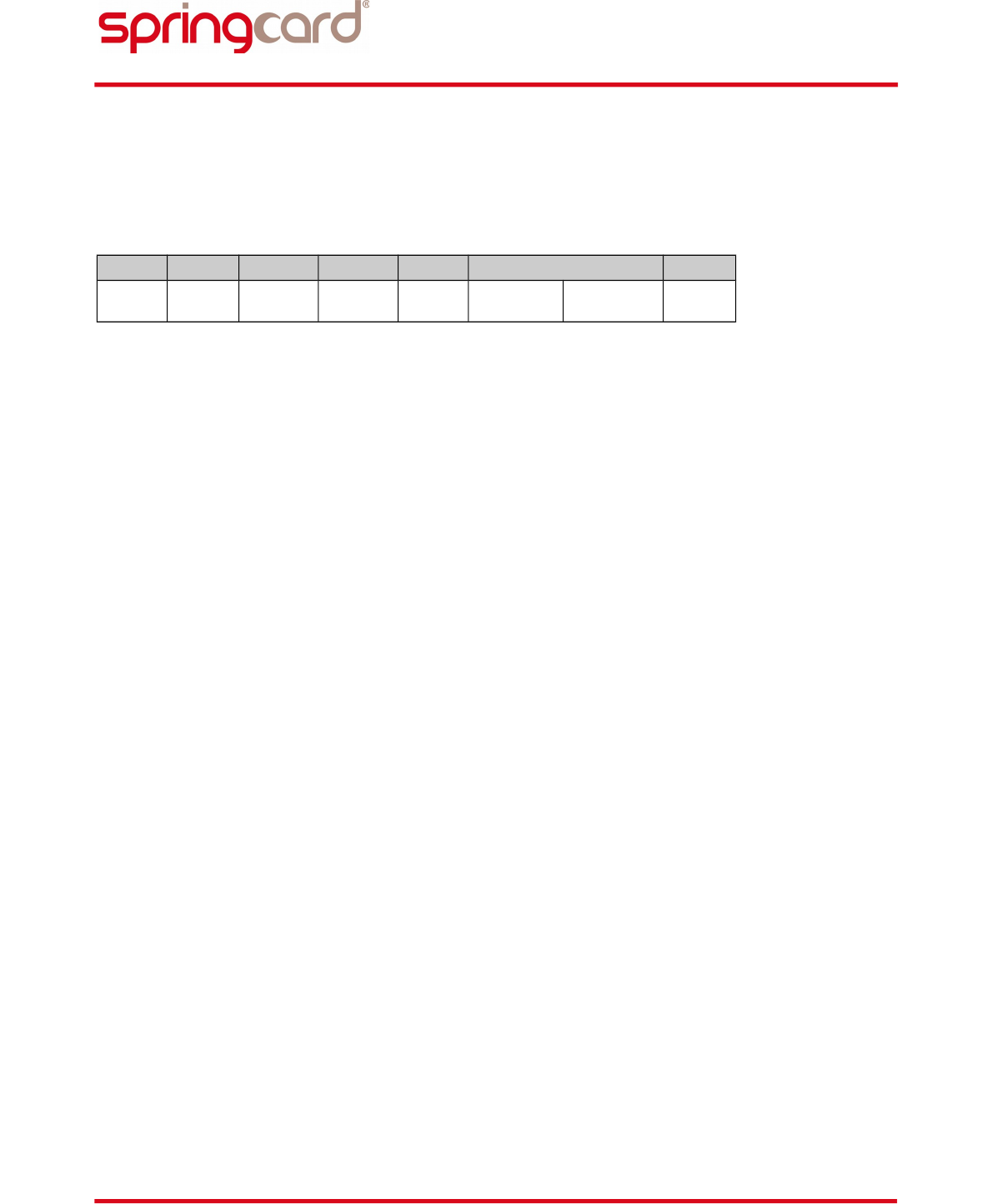
PMD2271-BA
page 43 of 118
SPRINGCARD PC/SC COUPLERS - H663 GROUP - Developer's reference manual
k. Get Multiple Block Security
This function is available for ISO 15693 VICCs only.
RFID MEMORY CONTROL : Get Multiple Block Security command APDU
CLA INS P1 P2 Lc Data In Le
hFF hF6 h24 h00 h02 Address
(1B)
Count
(1B) -
SPRINGCARD, the SPRINGCARD logo, PRO ACTIVE and the PRO ACTIVE logo are registered trademarks of PRO ACTIVE SAS.
All other brand names, product names, or trademarks belong to their respective holders.
Information in this document is subject to change without notice. Reproduction without written permission of PRO ACTIVE is forbidden.
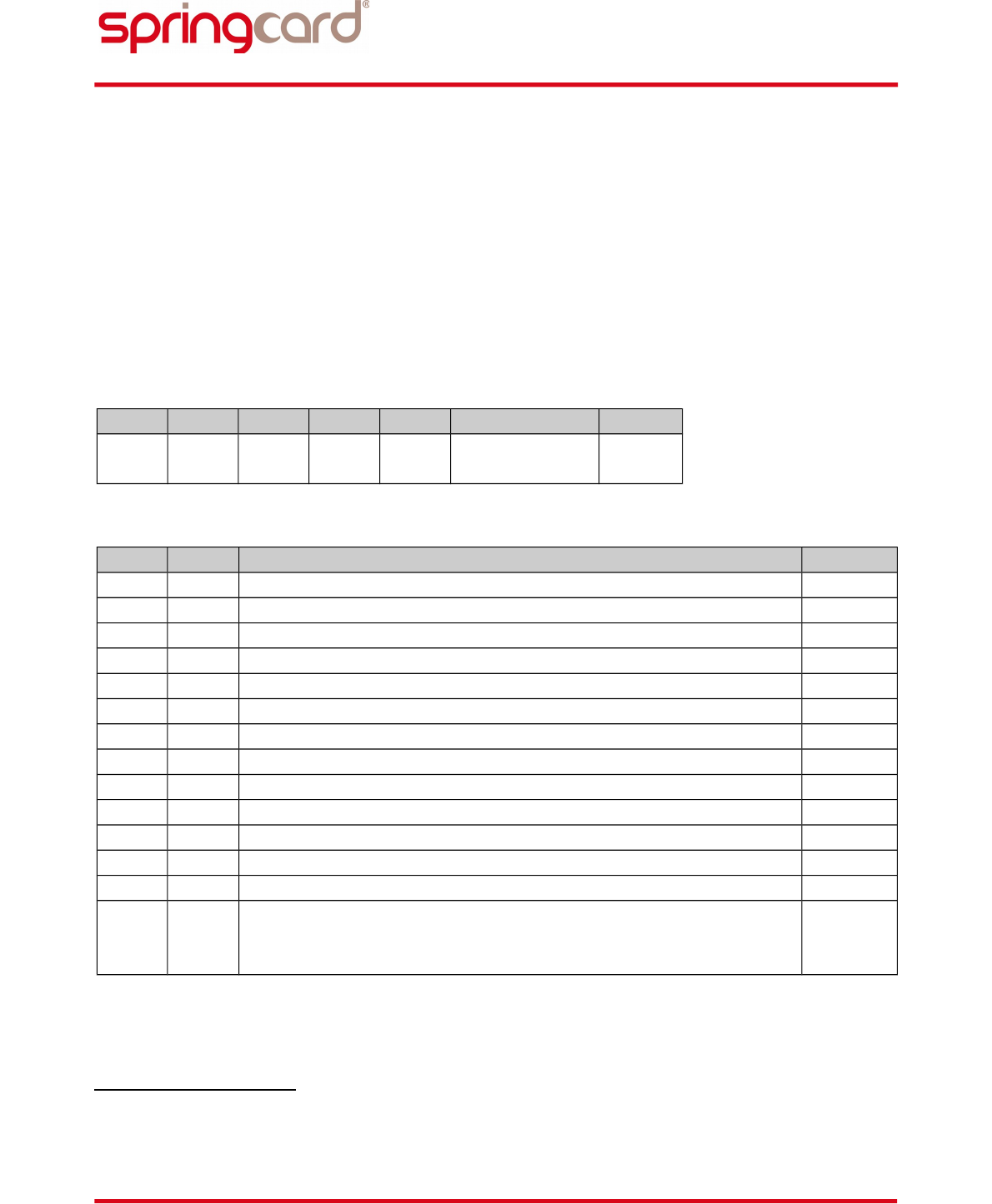
PMD2271-BA
page 44 of 118
SPRINGCARD PC/SC COUPLERS - H663 GROUP - Developer's reference manual
3.3.5. CONTACTLESS SLOT CONTROL instruction
The CONTACTLESS SLOT CONTROL instruction allows pausing and resuming the card tracking
mechanism of the contactless slot.
This is useful because card tracking implies sending commands to the PICC periodically (and
watch-out its answer). Such commands may have unwanted side-effects, such as breaking the
atomicity between a pair of commands. Switching the card tracking mechanism OFF during the
transaction with solve this problem.
SLOT CONTROL command APDU
CLA INS P1 P2 Lc Data In Le
hFF hFB See
below
See
below - - -
SLOT CONTROL command parameters
P1 P2 Action
h00 h00 Resume the card tracking mechanism
h01 h00 Suspend the card tracking mechanism
h10 h00 Stop the RF field
h10 h01 Start the RF field
h10 h02 Reset the RF field (10ms pause)
h20 h00 T=CL de-activation (DESELECT12)
h20 h01 T=CL activation of ISO 14443-A card (RATS)
h20 h02 T=CL activation of ISO 14443-B card (Attrib)
h20 h04 Disable the next T=CL activation13
h20 h05 Disable every T=CL activation (until reset of the H663)
h20 h06 Enable T=CL activation again
h20 h07 Disable the next T=CL activation and force a RF reset
hFC xx Felica runtime parameters, see § 3.3.6 below
hDE hAD Stop the slot
NOTE: a stopped slot is not available to SCardConnect any more. It
may be restarted only through an SCardControl command.
12 Or DISC for Innovatron cards. This makes it possible to operate ISO 14443-4 compliant cards at ISO 14443-3 level. No CARD
INSERTED event is triggered, so the ATR of the card stays unchanged.
13 Upon DISCONNECT, the CARD REMOVED event fires, then the CARD INSERTED event. A new ATR is computed, and reflects that
the card runs at ISO 14443-3 level.
SPRINGCARD, the SPRINGCARD logo, PRO ACTIVE and the PRO ACTIVE logo are registered trademarks of PRO ACTIVE SAS.
All other brand names, product names, or trademarks belong to their respective holders.
Information in this document is subject to change without notice. Reproduction without written permission of PRO ACTIVE is forbidden.
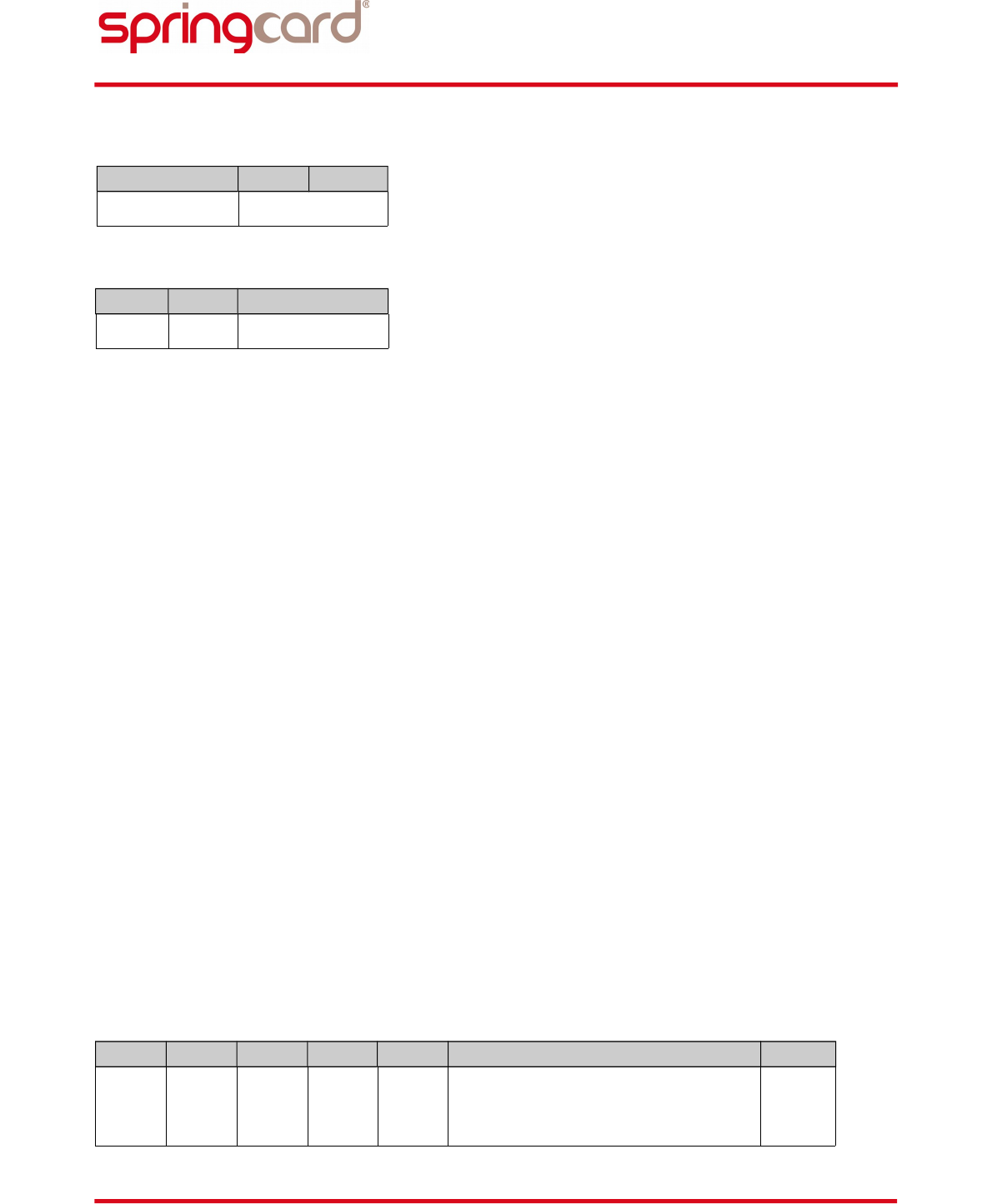
PMD2271-BA
page 45 of 118
SPRINGCARD PC/SC COUPLERS - H663 GROUP - Developer's reference manual
SLOT CONTROL response
Data Out SW1 SW2
- See below
SLOT CONTROL status word
SW1 SW2 Meaning
h90 h00 Success
3.3.6. SET FELICA RUNTIME PARAMETERS instruction
Working with Felica (Lite) cards or NFC Type 3 Tags involves 4 parameters:
The SYSTEM CODE is sent by the H663 during the JIS:X6319-4 polling loop (SENSF_REQ) to
specify which family of cards may answer. The value hFFFF allows any card to answer,
The REQUEST CODE is sent by the H663 during the JIS:X6319-4 polling loop (SENSF_REQ) to
get technical data from the cards, and not only their IDm/PPm. The value h00 prevent the
card from sending technical data,
A first SERVICE CODE is a mandatory parameter used during read operations (READ BINARY
instruction) to tell the card which “service” is accessed. The value h000B has been assigned
by the NFC Forum to give (read) access to a type 3 Tag's NDEF record,
Another SERVICE CODE is a mandatory parameter used during write operations (UPDATE
BINARY instruction) to tell the card which “service” is accessed. The value h0009 has been
assigned by the NFC Forum to give write access to a type 3 Tag's NDEF record.
The values emphasized in the above paragraph are the H663's default values. They could be
updated permanently thanks to the WRITE REGISTER command (§ 6.3.6) applied to the
configuration registers hB4 (§ 7.5.2) and hCF (§ 7.6.1).
Alternatively, those values may be changed dynamically using a simple APDU command in the
SCardTransmit stream, as depicted in the paragraphs below.
a. SERVICE CODE for the READ BINARY instruction
SET FELICA SERVICE READ command APDU
CLA INS P1 P2 Lc Data In Le
hFF hFB hFC h01 h02 Service Code to be used by the
READ BINARY instruction
(2 bytes, MSB first)
-
SPRINGCARD, the SPRINGCARD logo, PRO ACTIVE and the PRO ACTIVE logo are registered trademarks of PRO ACTIVE SAS.
All other brand names, product names, or trademarks belong to their respective holders.
Information in this document is subject to change without notice. Reproduction without written permission of PRO ACTIVE is forbidden.
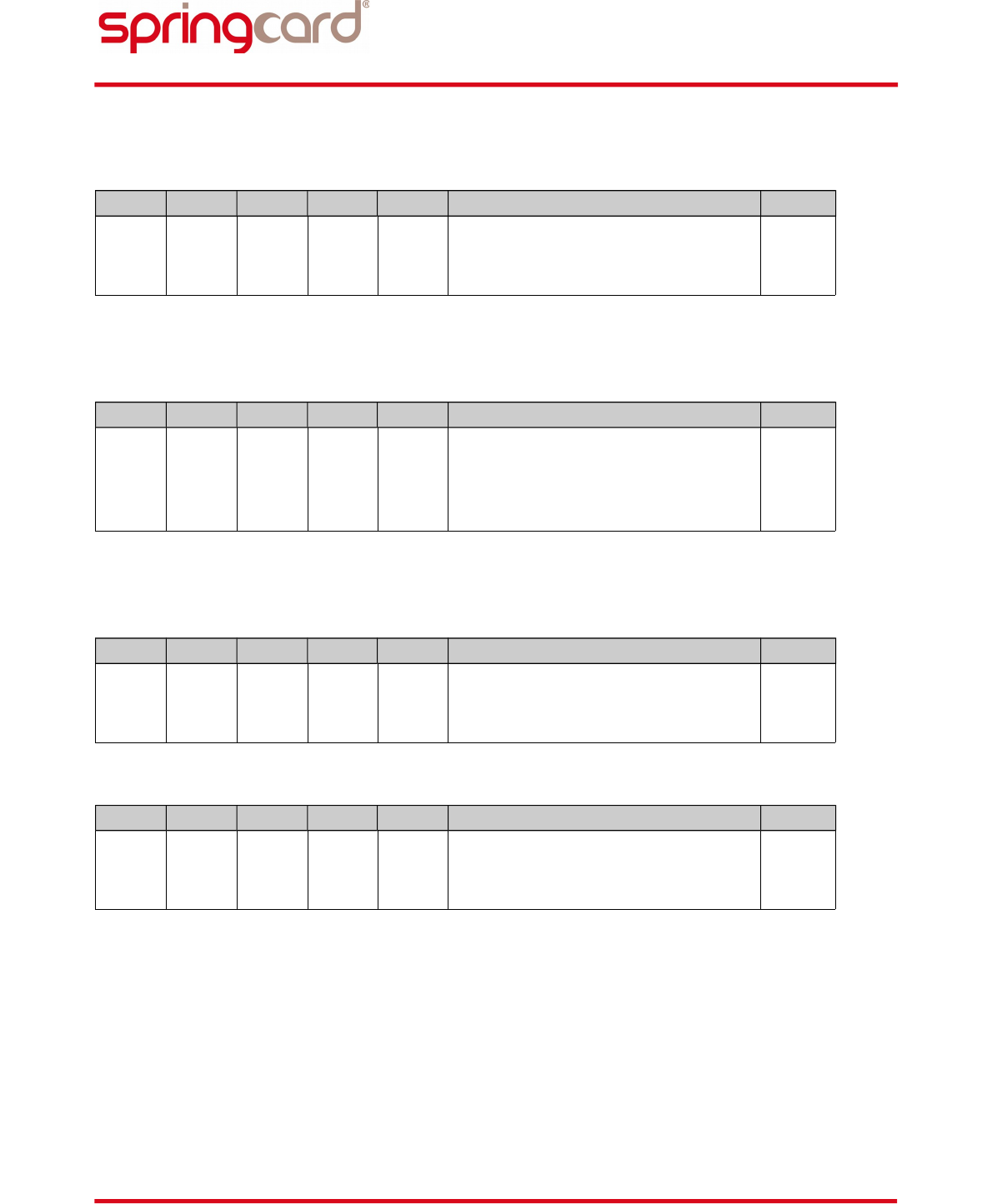
PMD2271-BA
page 46 of 118
SPRINGCARD PC/SC COUPLERS - H663 GROUP - Developer's reference manual
b. SERVICE CODE for the UPDATE BINARY instruction
SET FELICA SERVICE WRITE command APDU
CLA INS P1 P2 Lc Data In Le
hFF hFB hFC h02 h02 Service Code to be used by the
UPDATE BINARY instruction
(2 bytes, MSB first)
-
c. SERVICE CODE for both READ BINARY and UPDATE BINARY instructions
SET FELICA SERVICES command APDU
CLA INS P1 P2 Lc Data In Le
hFF hFB hFC h03 h02 Service Code to be used both by the
READ BINARY and UPDATE BINARY
instructions
(2 bytes, MSB first)
-
d. SYSTEM CODE and REQUEST code for Felica polling
SET FELICA SYSTEM CODE command APDU
CLA INS P1 P2 Lc Data In Le
hFF hFB hFC h10 h02 System Code to be used during
JIS:X6319-4 polling (SC in SENS_REQ)
(2 bytes, MSB first)
-
SET FELICA REQUEST CODE command APDU
CLA INS P1 P2 Lc Data In Le
hFF hFB hFC h11 h01 Request Code to be used during
JIS:X6319-4 polling (RC in SENS_REQ)
(1 byte)
-
SPRINGCARD, the SPRINGCARD logo, PRO ACTIVE and the PRO ACTIVE logo are registered trademarks of PRO ACTIVE SAS.
All other brand names, product names, or trademarks belong to their respective holders.
Information in this document is subject to change without notice. Reproduction without written permission of PRO ACTIVE is forbidden.

PMD2271-BA
page 47 of 118
SPRINGCARD PC/SC COUPLERS - H663 GROUP - Developer's reference manual
3.3.7. ENCAPSULATE instruction for the Contactless slot
The ENCAPSULATE instruction has been designed to help the applications communicate with
PICC/VICC that don’t comply with ISO 7816-4.
ENCAPSULATE command APDU for the contactless slot
CLA INS P1 P2 Lc Data In Le
hFF hFE See
below
See
below XX Frame to send to the PICC/VICC XX
ENCAPSULATE command parameter P1 for the contactless slot
P1 Standard communication protocols
h00
For ISO 14443-4 (A or B) PICCs : send the frame in the T=CL stream14.
Data In shall not include PCB, CID, NAD nor CRC fields
For ISO 18092 targets : send the frame DEP_REQ/DEP_RES stream. Data In shall not
include PFB, DID, NAD nor CRC fields
h01
Send the frame “as is” using the ISO 14443-3 A protocol @ 106 kbit/s.
The standard parity bits are added (and checked in return) by the H663.
The standard CRC is added (and checked in return) by the H663.
h02
Send the frame “as is” using the ISO 14443-3 B protocol @ 106 kbit/s.
The standard CRC is added (and checked in return) by the H663.
h03
Send the frame “as is” using the JIS:X6319-4 protocol @ 212 kbit/s.
The standard CRC is added (and checked in return) by the H663.
h04
Send the frame “as is” using the ISO 15693 protocol.
The standard CRC is added (and checked in return) by the H663.
h05
Send the frame “as is” using the ISO 15693 protocol.
The UID of the VICC is added to the frame (unselected access mode).
The standard CRC is added (and checked in return) by the H663.
h07
Send the frame “as is” using the JIS:X6319-4 protocol @ 424 kbit/s.
The standard CRC is added (and checked in return) by the H663.
…/…
14 This is the only way to send commands to a T=CL PICC that doesn't comply with the ISO 7816-4 APDU formatting, for instance a
Desfire 0.4.
SPRINGCARD, the SPRINGCARD logo, PRO ACTIVE and the PRO ACTIVE logo are registered trademarks of PRO ACTIVE SAS.
All other brand names, product names, or trademarks belong to their respective holders.
Information in this document is subject to change without notice. Reproduction without written permission of PRO ACTIVE is forbidden.

PMD2271-BA
page 48 of 118
SPRINGCARD PC/SC COUPLERS - H663 GROUP - Developer's reference manual
P1 Non-standard communication
h09
Send the frame “as is” using the ISO 14443-3 A modulation @ 106 kbit/s.
The standard parity bits are added (and checked in return) by the H663, but the CRC is
not added (and not checked) by the H663
the application must append the CRC to Data In and check it in Data Out.
h0A
Send the frame “as is” using the ISO 14443-3 B modulation @ 106 kbit/s.
The CRC is not added (and not checked) by the H663
the application must append the CRC to Data In and check it in Data Out.
h0C
Send the frame “as is” using the ISO 15693 modulation.
The CRC is not added (and not checked) by the H663
the application must append the CRC to Data In and check it in Data Out.
P1 Mifare low level communication15
h0F
Send the frame “as is” using the ISO 14443-3 A modulation.
The CRC is not added (and not checked) by the H663
the application must append the CRC to Data In and check it in Data Out.
The parity bits are not added (and not checked) by the H663
the application must provide a valid stream, including the parity bits).
The last byte is complete (8 bits will be sent)
h1F Same as h0F, but only 1 bit of the last byte will be sent
h2F Same as h0F, but only 2 bits of the last byte will be sent
h3F Same as h0F, but only 3 bits of the last byte will be sent
h4F Same as h0F, but only 4 bits of the last byte will be sent
h5F Same as h0F, but only 5 bits of the last byte will be sent
h6F Same as h0F, but only 6 bits of the last byte will be sent
h7F Same as h0F, but only 7 bits of the last byte will be sent
15 The above values allow an application to transmit “ciphered” Mifare frames (the CRYPTO1 stream cipher makes a non-standard
use of the parity bits and CRC). The number of valid bits in the last byte of card’s answer will be reported in SW2.
SPRINGCARD, the SPRINGCARD logo, PRO ACTIVE and the PRO ACTIVE logo are registered trademarks of PRO ACTIVE SAS.
All other brand names, product names, or trademarks belong to their respective holders.
Information in this document is subject to change without notice. Reproduction without written permission of PRO ACTIVE is forbidden.

PMD2271-BA
page 49 of 118
SPRINGCARD PC/SC COUPLERS - H663 GROUP - Developer's reference manual
P1 Redirection to another slot16
h80 Redirection to the main contact slot (if present)
h81 Redirection to the 1st SIM/SAM slot (if present)
h82 Redirection to the 2nd SIM/SAM slot (if present)
h83 Redirection to the 3rd SIM/SAM slot (if present)
h84 Redirection to the 4th SIM/SAM slot (if present)
ENCAPSULATE command parameter P2 for the contactless slot
P2 encodes the frame time-out.
P2 Timeout value
h-0 If P1 = h00, use the default time-out defined by the PICC or the target (T=CL: card's FWT)
If P1 h00, this value shall not be used
h-1 Timeout = 106 ETU 1ms
h-2 Timeout = 212 ETU 2ms
h-3 Timeout = 424 ETU 4ms
h-4 Timeout = 848 ETU 8ms
h-5 Timeout = 1696 ETU 16ms
h-6 Timeout = 3392 ETU 32ms
h-7 Timeout = 6784 ETU 65ms
h-8 Timeout = 13568 ETU 0,125s
h-9 Timeout = 27136 ETU 0,250s
h-A Timeout = 54272 ETU 0,500s
h-B Timeout = 108544 ETU 1s
h-C Timeout = 217088 ETU 2s
h-D Timeout = 434176 ETU 4s
h0- Set status word = h6F XX, XX being the contactless specific error
h8- Set status word = h63 00 on any contactless specific error
16 Those values allow an application to transmit APDUs to a SAM or an auxiliary card through the PC/SC handle of the main card.
SPRINGCARD, the SPRINGCARD logo, PRO ACTIVE and the PRO ACTIVE logo are registered trademarks of PRO ACTIVE SAS.
All other brand names, product names, or trademarks belong to their respective holders.
Information in this document is subject to change without notice. Reproduction without written permission of PRO ACTIVE is forbidden.
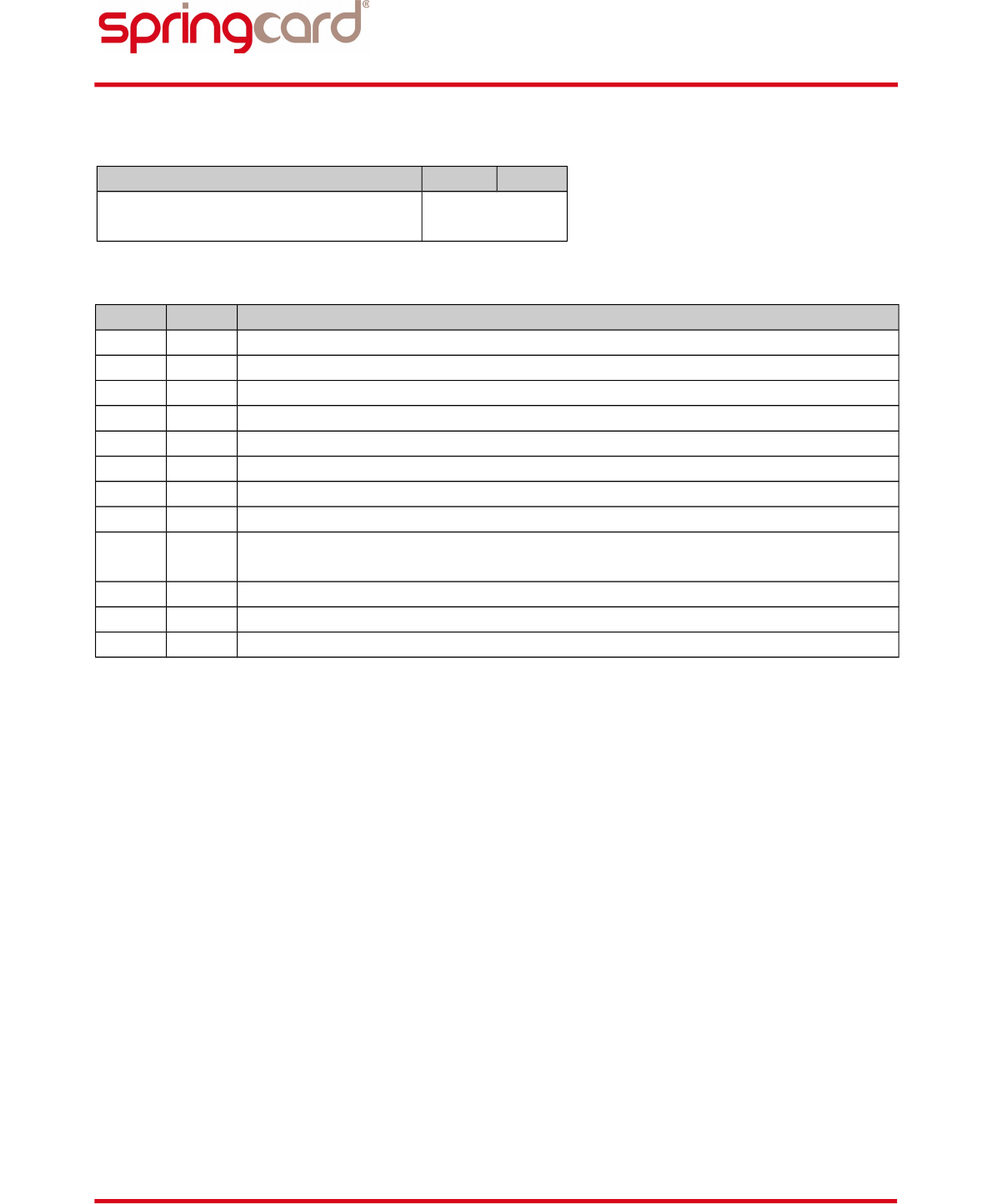
PMD2271-BA
page 50 of 118
SPRINGCARD PC/SC COUPLERS - H663 GROUP - Developer's reference manual
ENCAPSULATE response for the contactless slot
Data Out SW1 SW2
Frame received from the
PICC/VICC See below
ENCAPSULATE status word for the contactless slot
SW1 SW2 Meaning
h90 h00 Success – last byte of Data Out has 8 valid bits
h90 h01 Success – last byte of Data Out has 1 valid bits
h90 h02 Success – last byte of Data Out has 2 valid bits
h90 h03 Success – last byte of Data Out has 3 valid bits
h90 h04 Success – last byte of Data Out has 4 valid bits
h90 h05 Success – last byte of Data Out has 5 valid bits
h90 h06 Success – last byte of Data Out has 6 valid bits
h90 h07 Success – last byte of Data Out has 7 valid bits
h6F XX Error reported by the contactless interface (only allowed if high-order bit of P2
is 0). See chapter 8 for the list of possible values and their meaning.
h63 h00 Error reported by the contactless interface (when high-order bit of P2 is 1).
h62 h82 Le is greater than actual response from PICC/VICC
h6C XX Le is shorter than actual response from PICC/VICC
SPRINGCARD, the SPRINGCARD logo, PRO ACTIVE and the PRO ACTIVE logo are registered trademarks of PRO ACTIVE SAS.
All other brand names, product names, or trademarks belong to their respective holders.
Information in this document is subject to change without notice. Reproduction without written permission of PRO ACTIVE is forbidden.
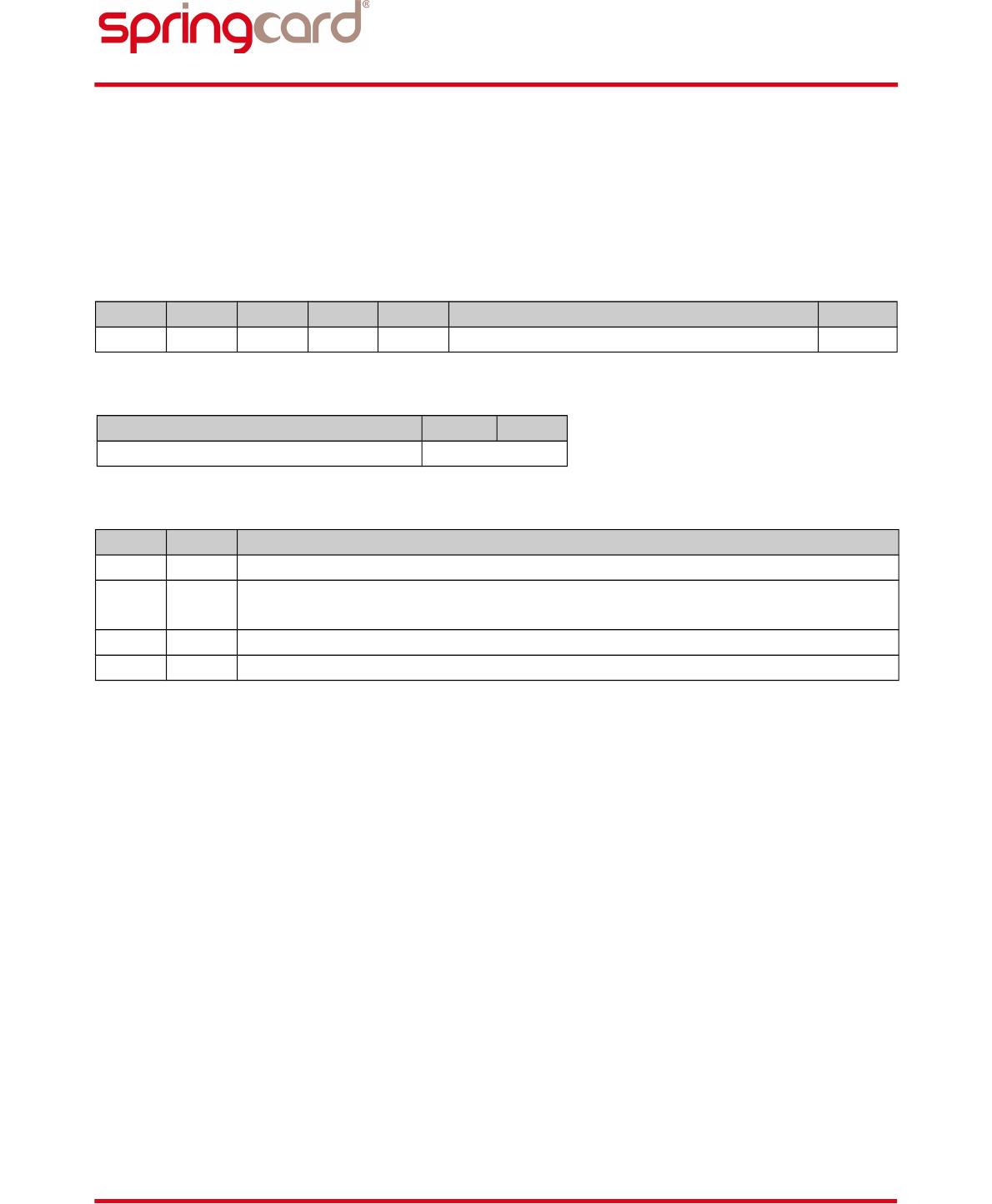
PMD2271-BA
page 51 of 118
SPRINGCARD PC/SC COUPLERS - H663 GROUP - Developer's reference manual
3.3.8. ENCAPSULATE instruction for one of the Contact slots
The ENCAPSULATE instruction has been designed to help the applications communicate with
PICC/VICC that don’t comply with ISO 7816-4.
ENCAPSULATE command APDU for a contact slot
CLA INS P1 P2 Lc Data In Le
hFF hFE h00 h00 XX Frame to send to the card XX
ENCAPSULATE response for a contact slot
Data Out SW1 SW2
Frame received from the card See below
ENCAPSULATE status word for a contact slot
SW1 SW2 Meaning
h90 h00 Success
h6F XX Error reported by the contactless interface (only allowed if high-order bit of P2
is 0). See chapter 8 for the list of possible values and their meaning.
h62 h82 Le is greater than actual response from card
h6C XX Le is shorter than actual response from card
SPRINGCARD, the SPRINGCARD logo, PRO ACTIVE and the PRO ACTIVE logo are registered trademarks of PRO ACTIVE SAS.
All other brand names, product names, or trademarks belong to their respective holders.
Information in this document is subject to change without notice. Reproduction without written permission of PRO ACTIVE is forbidden.
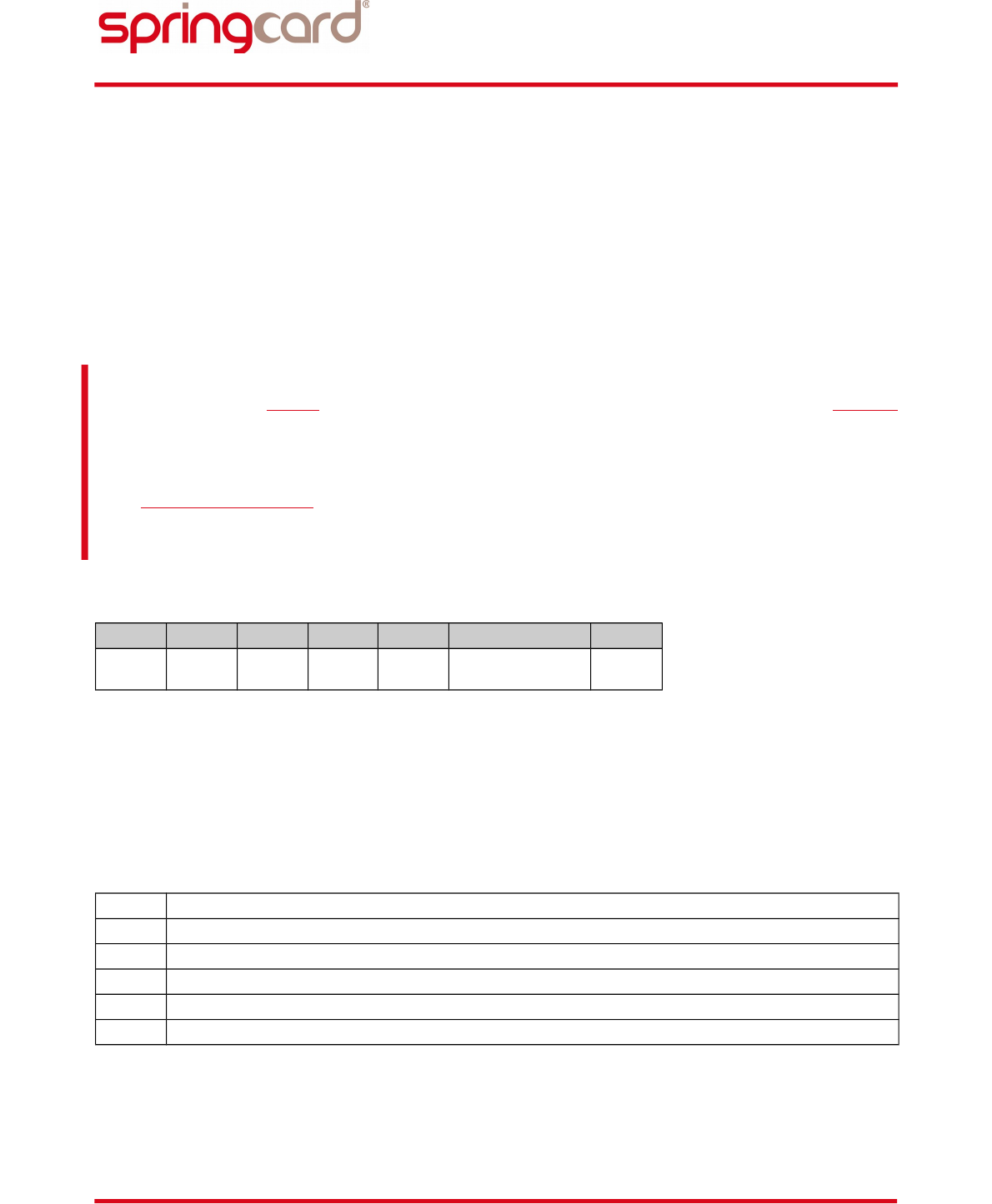
PMD2271-BA
page 52 of 118
SPRINGCARD PC/SC COUPLERS - H663 GROUP - Developer's reference manual
3.4. OTHER SPRINGCARD-SPECIFIC INSTRUCTIONS
3.4.1. READER CONTROL instruction
The READER CONTROL instruction allows driving the global behaviour of the H663 (LEDs, buzzer,
etc. depending on product physical characteristics).
For advanced operation, or if you want to interact with the H663 even when there's no card
inserted, use SCardControl instead (see chapter 6).
If your coupler is multi-slot (contactless + contact or SAM), the READER CONTROL instruction is
sent to one slot (a logical coupler), but is likely to have a global impact to the whole physical
coupler.
In other words, sending a READER CONTROL instruction to one card channel may have an impact
on another card channel.
It is highly recommended to use a synchronisation object in your application(s) (mutex, critical
section, …) to prevent any concurrent access to the same physical coupler when the READER
CONTROL instruction is called.
READER CONTROL command APDU
CLA INS P1 P2 Lc Data In Le
hFF hF0 h00 h00 See
below See below See
below
a. Driving coupler’s LEDs
For a coupler with only red and green LEDs, send the APDU:
FF F0 00 00 03 1E <red> <green>
For a coupler with red, green and yellow / blue LEDs, send the APDU:
FF F0 00 00 04 1E <red> <green> <yellow/blue>
Choose values for red, green and yellow/blue in this table:
h00 LED is switched OFF
h01 LED is switched ON
h02 LED blinks slowly
h03 LED is driven automatically by the H663’s firmware (default behaviour)
h04 LED blinks quickly
h05 LED performs the “heart-beat” sequence
SPRINGCARD, the SPRINGCARD logo, PRO ACTIVE and the PRO ACTIVE logo are registered trademarks of PRO ACTIVE SAS.
All other brand names, product names, or trademarks belong to their respective holders.
Information in this document is subject to change without notice. Reproduction without written permission of PRO ACTIVE is forbidden.

PMD2271-BA
page 53 of 118
SPRINGCARD PC/SC COUPLERS - H663 GROUP - Developer's reference manual
To go back to default (LEDs driven by the H663's firmware automatically), send the APDU:
FF F0 00 00 01 1E
b. Driving coupler’s buzzer
Some hardware feature a single tone beeper. To start the buzzer, send the APDU:
FF F0 00 00 03 1C <duration MSB> <duration LSB>
where duration specifies the length of the tone, in milliseconds (max is 60000ms).
Set duration to 0000 if you need to stop the buzzer before the duration started in a previous call.
To go back to default (buzzer driven by the H663's firmware automatically), send the APDU:
FF F0 00 00 01 1C
c. Others
The data block in the READER CONTROL instruction is forwarded “as is” to the reader control
interpreter, as documented in chapter 6.
Therefore, every command documented in § 6.3 and starting with code h58 may be transmitted in
the SCardTransmit link using the READER CONTROL instruction, exactly as if it were transmitted in
a SCardControl link.
Do not use this feature unless you know exactly what you are doing.
SPRINGCARD, the SPRINGCARD logo, PRO ACTIVE and the PRO ACTIVE logo are registered trademarks of PRO ACTIVE SAS.
All other brand names, product names, or trademarks belong to their respective holders.
Information in this document is subject to change without notice. Reproduction without written permission of PRO ACTIVE is forbidden.
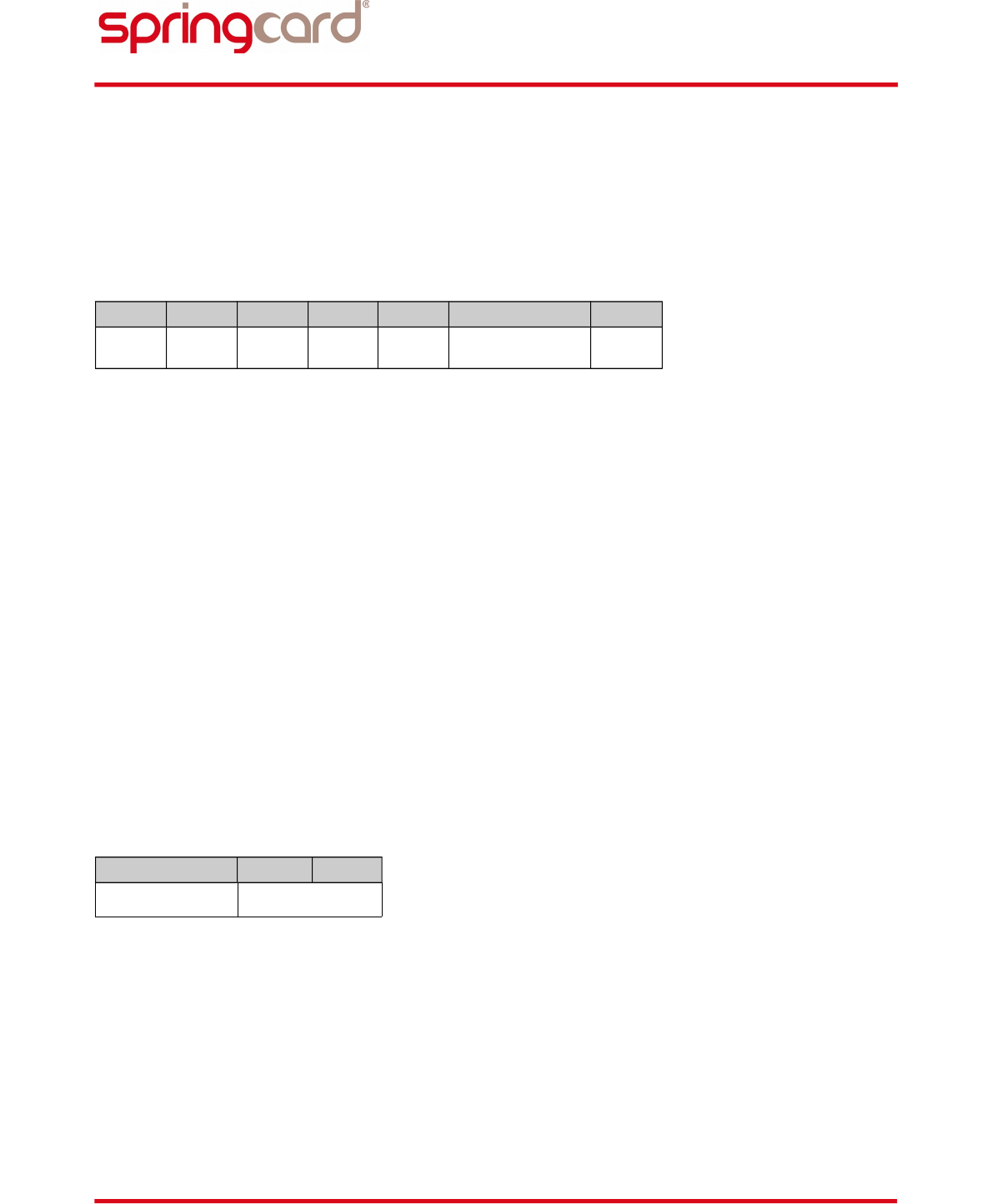
PMD2271-BA
page 54 of 118
SPRINGCARD PC/SC COUPLERS - H663 GROUP - Developer's reference manual
3.4.2. TEST instruction
The TEST instruction has been designed to test the driver and/or the applications, with arbitrary
length of data (in and out).
TEST command APDU
CLA INS P1 P2 Lc Data In Le
hFF hFD See
below
See
below XX XX … XX XX
TEST command parameters
Parameter P1 specifies the length of Data Out the application wants to receive from the H663:
h00: empty Data Out, only SW returned
hFF: 255 bytes of data + SW
All values between h00 and hFF are allowed
6 low-order bits of P2 specify the delay between command and response.
h00: no delay, response comes immediately
h3F: 63 seconds between command and response
All values between 0 and 63 are allowed
2 high-order bits of P2 are RFU and must be set to 0.
TEST response
Data Out SW1 SW2
XX … XX See below
Content of Data Out is not specified, and may contain either “random” or fixed data, depending
on the H663 version and current status.
SPRINGCARD, the SPRINGCARD logo, PRO ACTIVE and the PRO ACTIVE logo are registered trademarks of PRO ACTIVE SAS.
All other brand names, product names, or trademarks belong to their respective holders.
Information in this document is subject to change without notice. Reproduction without written permission of PRO ACTIVE is forbidden.
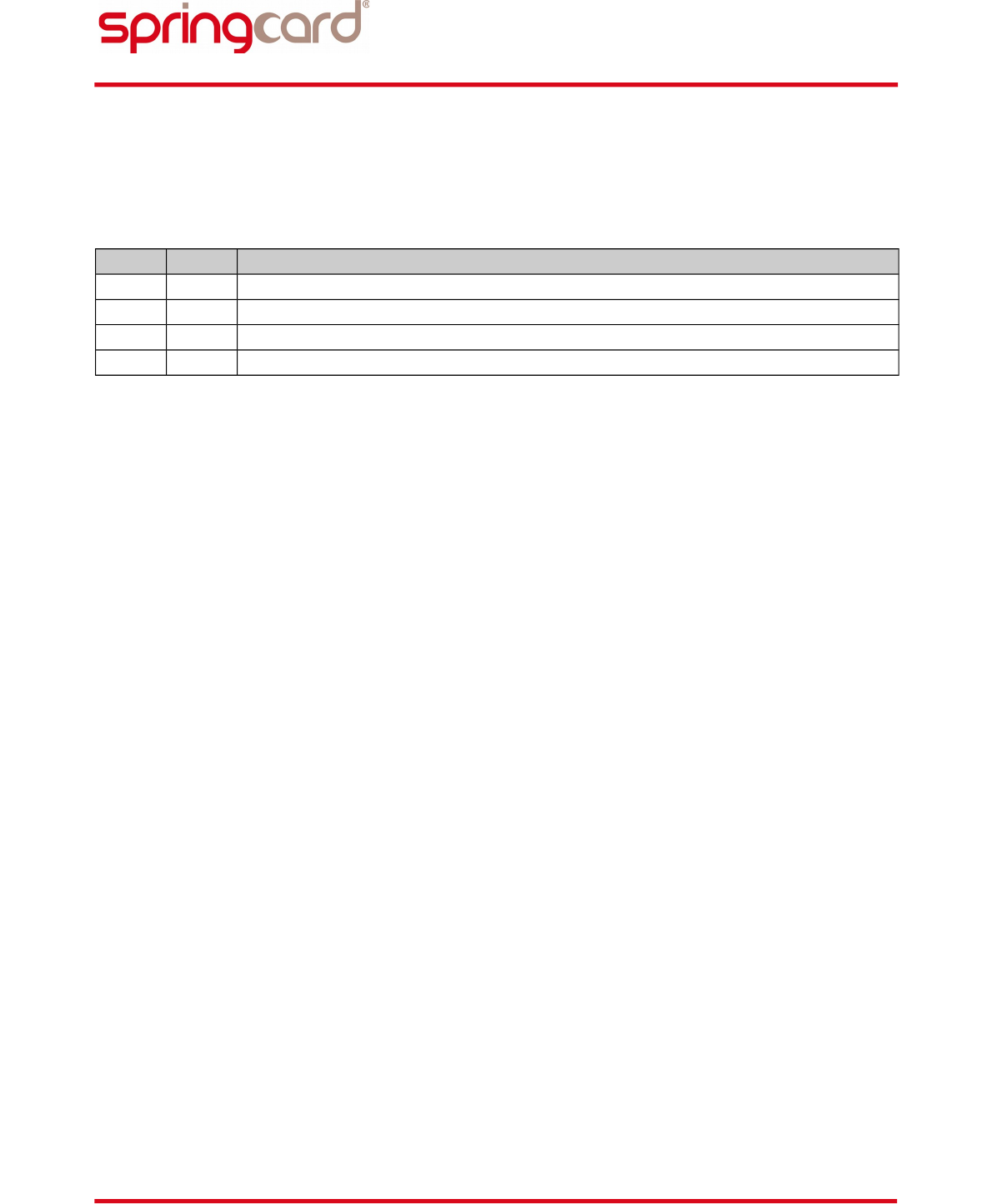
PMD2271-BA
page 55 of 118
SPRINGCARD PC/SC COUPLERS - H663 GROUP - Developer's reference manual
TEST status word
When 2 high-order bits of P2 are 0, the embedded APDU interpreter analyses the format of the
APDU, and return appropriate status word. On the other hand, if at least one of those bits is 1,
status word is fixed whatever the APDU format.
SW1 SW2 Meaning
h90 h00 Success, APDU correctly formatted
h67 h00 APDU is badly formatted (total length incoherent with Lc value)
h6A h82 Le is greater than data length specified in P1
h6C P1 Le is shorter than data length specified in P1
SPRINGCARD, the SPRINGCARD logo, PRO ACTIVE and the PRO ACTIVE logo are registered trademarks of PRO ACTIVE SAS.
All other brand names, product names, or trademarks belong to their respective holders.
Information in this document is subject to change without notice. Reproduction without written permission of PRO ACTIVE is forbidden.
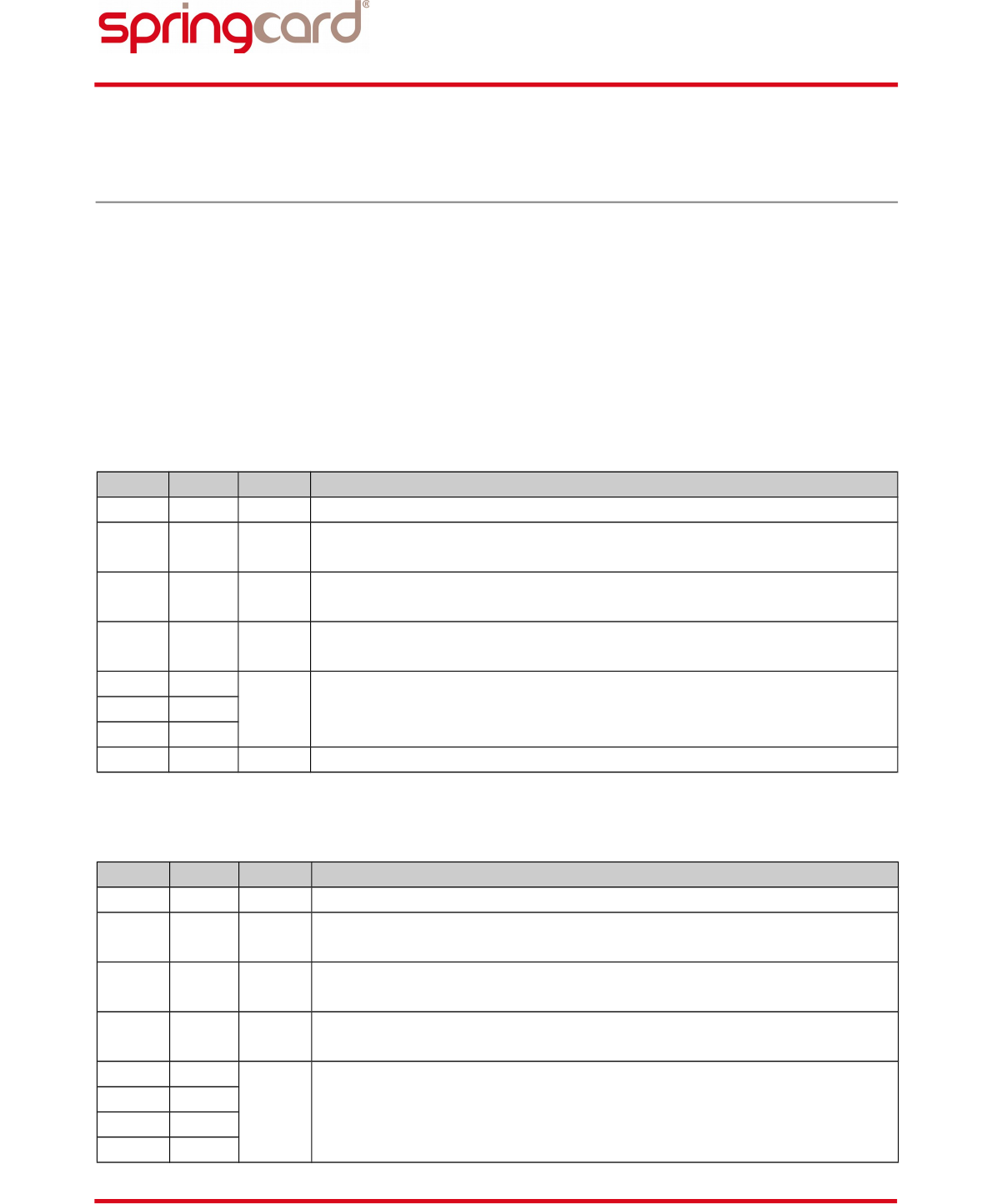
PMD2271-BA
page 56 of 118
SPRINGCARD PC/SC COUPLERS - H663 GROUP - Developer's reference manual
4. WORKING WITH CONTACTLESS CARDS – USEFUL HINTS
4.1. RECOGNIZING AND IDENTIFYING PICC/VICC IN PC/SC ENVIRONMENT
4.1.1. ATR of an ISO 14443-4 compliant smartcard
If the PICC is with 14443 up to level 4 (“T=CL”), the H663 builds a pseudo-ATR using the standard
format defined in PC/SC specification:
a. For ISO 14443-A:
Offset Name Value Meaning (according to 7816-3)
0 TS h3B Direct convention
1 T0 h8… Higher nibble 8 means: no TA1, no TB1, no TC1. TD1 to follow
Lower nibble is the number of historical bytes (0 to 15)
2 TD1 h80 Higher nibble 8 means: no TA2, no TB2, no TC2. TD2 to follow
Lower nibble 0 means: protocol T=0
3 TD2 h01 Higher nibble 8 means: no TA3, no TB3, no TC3, no TD3
Lower nibble 1 means: protocol T=1
4 H1
… Historical bytes from ATS response… …
3+k Hk
4+k TCK XX Checksum (XOR of bytes 1 to 3+k)
b. For ISO 14443-B:
Offset Name Value Meaning (according to 7816-3)
0 TS h3B Direct convention
1 T0 h88 Higher nibble 8 means: no TA1, no TB1, no TC1. TD1 to follow
Lower nibble is the number of historical bytes (8)
2 TD1 h80 Higher nibble 8 means: no TA2, no TB2, no TC2. TD2 to follow
Lower nibble 0 means: protocol T=0
3 TD2 h01 Higher nibble 8 means: no TA3, no TB3, no TC3, no TD3
Lower nibble 1 means: protocol T=1
4 H1
… Application data from ATQB
5 H2
6 H3
7 H4
SPRINGCARD, the SPRINGCARD logo, PRO ACTIVE and the PRO ACTIVE logo are registered trademarks of PRO ACTIVE SAS.
All other brand names, product names, or trademarks belong to their respective holders.
Information in this document is subject to change without notice. Reproduction without written permission of PRO ACTIVE is forbidden.
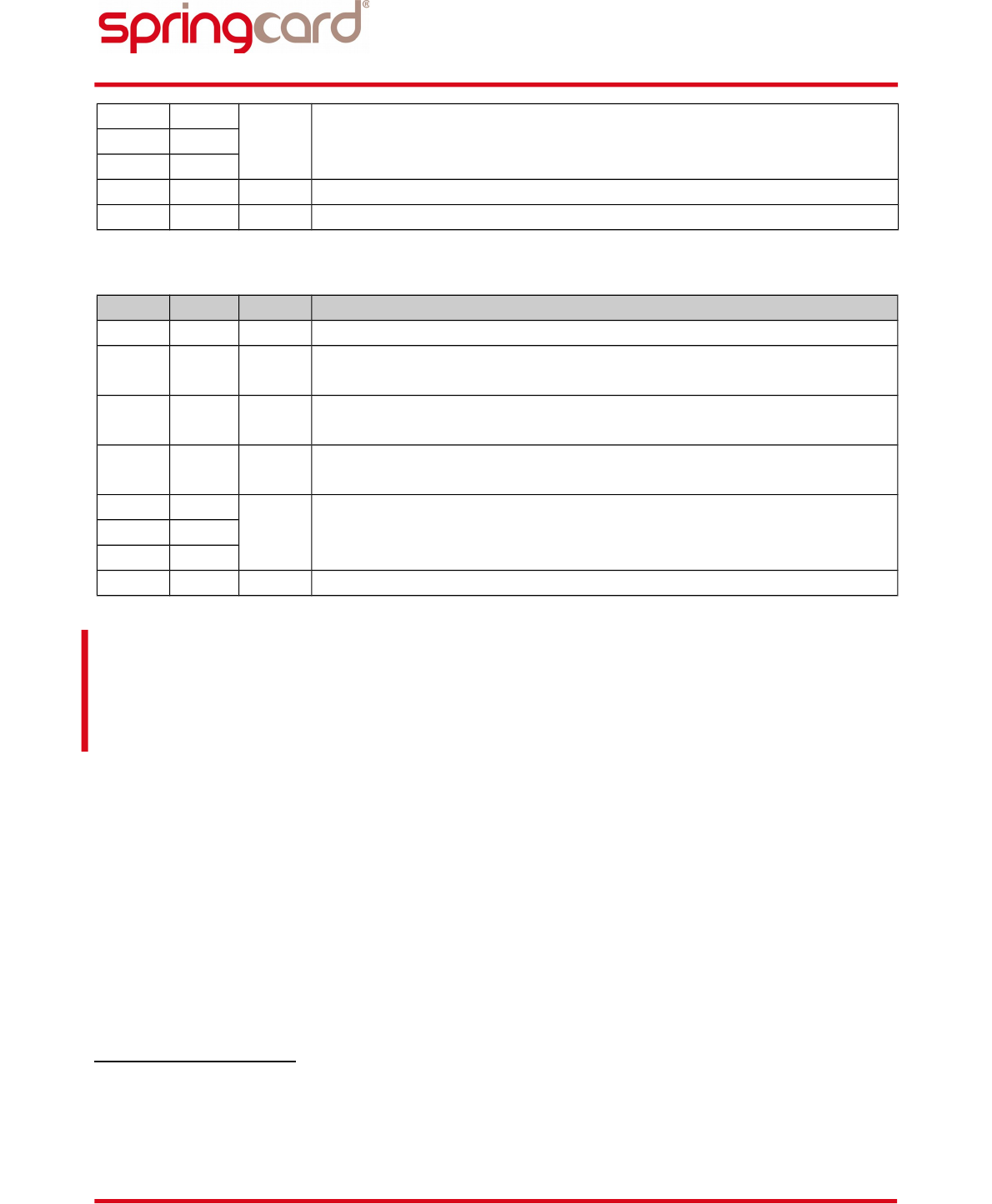
PMD2271-BA
page 57 of 118
SPRINGCARD PC/SC COUPLERS - H663 GROUP - Developer's reference manual
8 H5
… Protocol info byte from ATQB9 H6
10 H7
11 H8 XX MBLI from ATTRIB command
12 TCK XX Checksum (XOR of bytes 1 to 11)
c. For Innovatron (legacy Calypso cards)17:
Offset Name Value Meaning (according to 7816-3)
0 TS h3B Direct convention
1 T0 h8… Higher nibble 8 means: no TA1, no TB1, no TC1. TD1 to follow
Lower nibble is the number of historical bytes (0 to 15)
2 TD1 h80 Higher nibble 8 means: no TA2, no TB2, no TC2. TD2 to follow
Lower nibble 0 means: protocol T=0
3 TD2 h01 Higher nibble 8 means: no TA3, no TB3, no TC3, no TD3
Lower nibble 1 means: protocol T=1
4 H1
…Historical bytes from REPGEN. This is the last part of the card’s T=0
ATR, including its serial number18.
… …
3+k Hk
4+k TCK XX Checksum (XOR of bytes 1 to 3+k)
Most Calypso cards are able to communicate both according to ISO 14443-B or to Innovatron
protocol. The choice between the two protocols is unpredictable.
The same card will have two different ATR (one is ISO 14443-B is selected, the other if Innovatron
protocol is selected). The host application must get and check the card’s serial number19 to make
sure it will not start a new transaction on the same card as earlier.
17 When bit 7 of register hB3 is 0. Otherwise, the “real” card ATR (found in REPGEN) is returned. This ATR reports that the card
supports T=0 only, but the card behaves as it were T=1. This behaviour is not compliant with Microsoft’s CCID driver.
18 As a consequence, all the cards have a different ATR.
19 Provided in the historical bytes of the ATR when the Innovatron protocol is selected, or available through the Calypso “Select
Application” command.
SPRINGCARD, the SPRINGCARD logo, PRO ACTIVE and the PRO ACTIVE logo are registered trademarks of PRO ACTIVE SAS.
All other brand names, product names, or trademarks belong to their respective holders.
Information in this document is subject to change without notice. Reproduction without written permission of PRO ACTIVE is forbidden.

PMD2271-BA
page 58 of 118
SPRINGCARD PC/SC COUPLERS - H663 GROUP - Developer's reference manual
4.1.2. ATR of a wired-logic PICC/VICC
For contactless memory cards and RFID tags (Mifare, CTS, etc.), the H663 builds a pseudo-ATR
using the normalized format described in PC/SC specification:
Offset Name Value
0 TS h3B Direct convention
1 T0 h8F Higher nibble 8 means: no TA1, no TB1, no TC1. TD1 to follow
Lower nibble is the number of historical bytes (15)
2 TD1 h80 Higher nibble 8 means: no TA2, no TB2, no TC2. TD2 to follow
Lower nibble 0 means: protocol T=0
3 TD2 h01 Higher nibble 8 means: no TA3, no TB3, no TC3, no TD3
Lower nibble 1 means: protocol T=1
4 H1 h80
5 H2 h4F Application identifier presence indicator
6 H3 h0C Length to follow (12 bytes)
7 H4 hA0
Registered Application Provider Identifier
A0 00 00 03 06 is for PC/SC workgroup
8 H5 h00
9 H6 h00
10 H7 h03
11 H8 h06
12 H9 PIX.SS Protocol (see 4.1.4)
13 H10 PIX.NN Card name (see 4.1.5)
14 H11
15 H12 00
RFU
16 H13 00
17 H14 00
18 H15 00
19 TCK XX Checksum (XOR of bytes 1 to 18)
SPRINGCARD, the SPRINGCARD logo, PRO ACTIVE and the PRO ACTIVE logo are registered trademarks of PRO ACTIVE SAS.
All other brand names, product names, or trademarks belong to their respective holders.
Information in this document is subject to change without notice. Reproduction without written permission of PRO ACTIVE is forbidden.
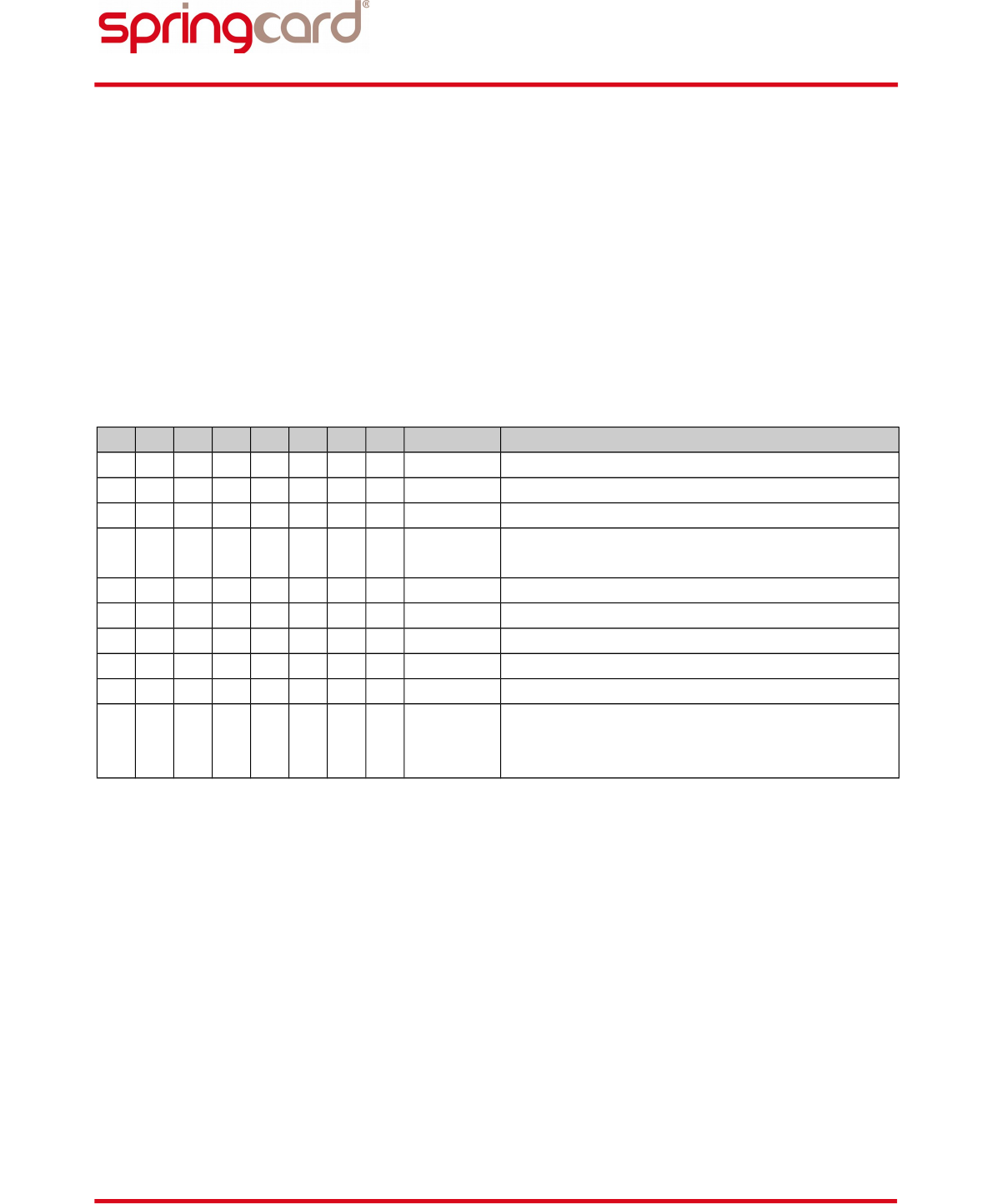
PMD2271-BA
page 59 of 118
SPRINGCARD PC/SC COUPLERS - H663 GROUP - Developer's reference manual
4.1.3. Using the GET DATA instruction
With the GET DATA instruction (documented in § 3.2.1), the host application is able to retrieve
every information needed to identify a PICC:
Serial number (UID or PUPI),
Protocol related values (ATQA and SAKA or ATQB, …).
4.1.4. Contactless protocol
The standard byte (PIX.SS in PC/SC specification) is constructed as follow:
b7 b6 b5 b4 b3 b2 b1 b0 Value Description
0 0 0 0 0 0 0 0 h00 No information given
0 0 0 0 0 0 0 1 h01 ISO 14443 A, level 1
0 0 0 0 0 0 1 0 h02 ISO 14443 A, level 2
0 0 0 0 0 0 1 1 h03 ISO 14443 A, level 3 or 4 (and Mifare)
ISO 18092 @ 106 kbit/s “NFC-A”
0 0 0 0 0 1 0 1 h05 ISO 14443 B, level 1
0 0 0 0 0 1 1 0 h06 ISO 14443 B, level 2
0 0 0 0 0 1 1 1 h07 ISO 14443 B, level 3 or 4
0 0 0 0 1 0 0 1 h09 ICODE 1, EM4134
0 0 0 0 1 0 1 1 h0B ISO 15693
0 0 0 1 0 0 0 1 h11
JIS:X6319-4
Felica cards
ISO 18092 @ 212 or 424 kbit/s “NFC-F”
Note: PIX.SS is defined for both memory and micro-processor based cards, but available in the
ATR for memory cards only. In the other case, use the GET DATA instruction (with parameters
P1,P2=hF1,00) to get the underlying protocol used by the smartcard.
SPRINGCARD, the SPRINGCARD logo, PRO ACTIVE and the PRO ACTIVE logo are registered trademarks of PRO ACTIVE SAS.
All other brand names, product names, or trademarks belong to their respective holders.
Information in this document is subject to change without notice. Reproduction without written permission of PRO ACTIVE is forbidden.

PMD2271-BA
page 60 of 118
SPRINGCARD PC/SC COUPLERS - H663 GROUP - Developer's reference manual
4.1.5. Contactless card name bytes
The name bytes (PIX.NN in PC/SC specification) are specified as follow:
NN Card name From FW
Values specified by PC/SC
h00 h01 NXP Mifare Classic 1k
h00 h02 NXP Mifare Classic 4k
h00 h03 NXP Mifare UltraLight
NFC Forum Type 2 Tag with a capacity <= 64 bytes
h00 h06 ST Micro Electronics SR176
h00 h07 ST Micro Electronics SRI4K, SRIX4K, SRIX512, SRI512, SRT512 1.70
h00 h0A Atmel AT88SC0808CRF
h00 h0B Atmel AT88SC1616CRF
h00 h0C Atmel AT88SC3216CRF
h00 h0D Atmel AT88SC6416CRF
h00 h12 Texas Instruments TAG IT
h00 h13 ST Micro Electronics LRI512
h00 h14 NXP ICODE SLI
h00 h16 Not available in this product (NXP ICODE1)
h00 h21 ST Micro Electronics LRI64
h00 h24 ST Micro Electronics LR12
h00 h25 ST Micro Electronics LRI128
h00 h26 NXP Mifare Mini
h00 h2F Innovision/Broadcom Jewel
h00 h30 Innovision/Broadcom Topaz
NFC Forum Type 1 Tag
h00 h34 Atmel AT88RF04C
h00 h35 NXP ICODE SL2
h00 h36 NXP Mifare Plus 2K SL1 1.81
h00 h37 NXP Mifare Plus 4K SL1 1.81
h00 h38 NXP Mifare Plus 2K SL2 1.81
h00 h39 NXP Mifare Plus 4K SL2 1.81
h00 h3A NXP Mifare UltraLight C, NXP NTAG203
NFC Forum Type 2 Tag with a capacity > 64 bytes
h00 h3A Felica
NFC Forum Type 3 Tag
SPRINGCARD, the SPRINGCARD logo, PRO ACTIVE and the PRO ACTIVE logo are registered trademarks of PRO ACTIVE SAS.
All other brand names, product names, or trademarks belong to their respective holders.
Information in this document is subject to change without notice. Reproduction without written permission of PRO ACTIVE is forbidden.

PMD2271-BA
page 61 of 118
SPRINGCARD PC/SC COUPLERS - H663 GROUP - Developer's reference manual
NN Card name
SpringCard proprietary extension20
hFF hA0 Generic/unknown 14443-A card
hFF hA1 Kovio RF bar-code
hFF hB0 Generic/unknown 14443-B card
hFF hB1 Not available in this product (ASK CTS 256B)
hFF hB2 Not available in this product (ASK CTS 512B)
hFF hB3 Pre-standard ST Micro Electronics SRI 4K
hFF hB4 Pre-standard ST Micro Electronics SRI X512
hFF hB5 Pre-standard ST Micro Electronics SRI 512
hFF hB6 Pre-standard ST Micro Electronics SRT 512
hFF hB7 Inside Contactless PICOTAG/PICOPASS
hFF hB8 Generic Atmel AT88SC / AT88RF card
hFF hC0 Calypso card using the Innovatron protocol
hFF hD0 Generic ISO 15693 from unknown manufacturer
hFF hD1 Generic ISO 15693 from EM Marin (or Legic)
hFF hD2 Generic ISO 15693 from ST Micro Electronics, block number on 8 bits
hFF hD3 Generic ISO 15693 from ST Micro Electronics, block number on 16 bits
hFF hD5 Generic ISO 15693 from Infineon
hFF hD6 EM MicroElectronic Marin EM4134 chip 1.81
hFF hFF Virtual card (test only)
Note: PIX.NN is specified for memory cards only. Even if the GET DATA instruction allows to
retrieve PIX.NN even for micro-processor based cards (smartcards), the returned value is
unspecified and shall not be used to identify the card.
20 The cards in this list are not referenced by PC/SC specification at the date of writing. In case they are added to the specification,
the future firmware versions will have to use the new value. It is therefore advised not to check those values in the applications, as
they are likely to be removed in the future. Set bit 6 of configuration register hB3 (§ 7.4.3) to force PIX.NN = h00 h00 instead of using
those proprietary values.
SPRINGCARD, the SPRINGCARD logo, PRO ACTIVE and the PRO ACTIVE logo are registered trademarks of PRO ACTIVE SAS.
All other brand names, product names, or trademarks belong to their respective holders.
Information in this document is subject to change without notice. Reproduction without written permission of PRO ACTIVE is forbidden.

PMD2271-BA
page 62 of 118
SPRINGCARD PC/SC COUPLERS - H663 GROUP - Developer's reference manual
4.2. ISO 14443-4 PICCS
4.2.1. Desfire first version (0.4)
Since this PICC is not ISO 7816-4 compliant, the Desfire commands must be wrapped in an
ENCAPSULATED instruction, with P1=h00 (§ 3.3.7). The H663 translates the C-APDU into a native
Desfire command, retrieve the native Desfire answer, and translates it into a valid R-APDU.
4.2.2. Desfire EV0 (0.6) and EV1
This PICC is ISO 7816-4 compliant. Native commands are wrapped into ISO 7816-4 APDUs with a
card-specific CLA = h90. Please refer to the card's datasheet for details.
4.2.3. Calypso cards
A Calypso card is ISO 7816-4 compliant. You may work with a contactless Calypso card as if it were
inserted in a contact smartcard coupler.
SPRINGCARD, the SPRINGCARD logo, PRO ACTIVE and the PRO ACTIVE logo are registered trademarks of PRO ACTIVE SAS.
All other brand names, product names, or trademarks belong to their respective holders.
Information in this document is subject to change without notice. Reproduction without written permission of PRO ACTIVE is forbidden.

PMD2271-BA
page 63 of 118
SPRINGCARD PC/SC COUPLERS - H663 GROUP - Developer's reference manual
4.3. WIRED-LOGIC PICCS BASED ON ISO 14443-A
4.3.1. Mifare Classic
The PICCs covered by this chapter are:
Mifare 1k (NXP MF1ICS50, PIX.NN = h0001),
Mifare 4k (NXP MF1ICS70, PIX.NN = h0002),
Mifare Mini (NXP MF1ICS20, PIX.NN = h0026),
Mifare Plus (X or S) when used in level 1 (see § 4.3.2).
Please download the datasheets of the cards at www.nxp.com. Useful information are available at
www.mifare.net.
All these PICCs are divided into 16-byte blocks. The blocks are grouped in sectors. At the end of
every sector a specific block (“sector trailer”) is reserved for security parameters (access keys and
access conditions).
Operating multi-standard PICCs as Mifare Classic
Some ISO 14443-4 compliant smartcards or NFC objects are also able to emulate Mifare Classic
cards, but due to the ISO 14443-4 (T=CL) compliance, the H663 will “hide” their Mifare emulation
mode and make them appear as high-level smartcards.
There are 3 ways to force the H663 to stay at Mifare level:
Send the T=CL DESELECT command to the PICC (SLOT CONTROL instruction with
P1,P2=h20,00),
Reset the RF field and temporarily disable T=CL activation (SLOT CONTROL instruction with
P1,P2=h10,03),
Permanently disable T=CL activation through configuration register hB3.
a. READ BINARY instruction
In the READ BINARY command APDU,
P1 must be h00,
P2 is the address of the first block to be read (0 to 63 for a Mifare 1k, 0 to 255 for a Mifare
4k),
Since the size of every block is 16, Le must be a multiple of 16,
When Le=h00 and the address is aligned on a sector boundary, all the data blocks of the
sector are returned (48 or 240 bytes),
SPRINGCARD, the SPRINGCARD logo, PRO ACTIVE and the PRO ACTIVE logo are registered trademarks of PRO ACTIVE SAS.
All other brand names, product names, or trademarks belong to their respective holders.
Information in this document is subject to change without notice. Reproduction without written permission of PRO ACTIVE is forbidden.

PMD2271-BA
page 64 of 118
SPRINGCARD PC/SC COUPLERS - H663 GROUP - Developer's reference manual
When Le=h00 and the address is not aligned, a single block is returned (16 bytes).
Note that when a sector trailer (security block) is read, the keys are not readable (they are masked
by the PICC).
The READ BINARY instruction can’t cross sector boundaries ; the GENERAL AUTHENTICATE
instruction must be called for each sector immediately before READ BINARY.
Using the MIFARE CLASSIC READ instruction (§ 3.3.5) is easier and may shorten the transaction
time.
b. UPDATE BINARY instruction
In the UPDATE BINARY command APDU,
P1 must be h00,
P2 is the address of the first block to be written (1 to 63 for a Mifare 1k, 1 to 255 for a
Mifare 4k),
Since the size of every block is 16, Lc must be a multiple of 16 (48 bytes for standard sectors, 240
bytes for the largest sectors in Mifare 4k).
The UPDATE BINARY instruction can’t cross sector boundaries ; the GENERAL AUTHENTICATE
instruction must be called for each sector immediately before UPDATE BINARY.
Important disclaimer
Writing sector trailers (security blocks) is possible as long as the sector's current access condition
allows it, but Mifare sector trailers have to follow a specific formatting rule (mix-up of the access
conditions bits) to be valid. Otherwise, the sector becomes permanently unusable.
Before invoking MIFARE CLASSIC WRITE, always double check that you're not writing a sector
trailer. If you really have to do so, make sure the new content is formatted as specified in the
datasheet of the PICC.
Using the MIFARE CLASSIC WRITE instruction (§ 3.3.2) is easier and may shorten the transaction
time.
c. Specific instructions for Mifare Classic
3 specific instructions exist to work with Mifare Classic PICCs:
MIFARE CLASSIC READ, see § 3.3.1,
MIFARE CLASSIC WRITE, see § 3.3.2,
MIFARE CLASSIC VALUE (implementing INCREMENT, DECREMENT and RESTORE followed
by TRANSFER), see § 3.3.3.
SPRINGCARD, the SPRINGCARD logo, PRO ACTIVE and the PRO ACTIVE logo are registered trademarks of PRO ACTIVE SAS.
All other brand names, product names, or trademarks belong to their respective holders.
Information in this document is subject to change without notice. Reproduction without written permission of PRO ACTIVE is forbidden.

PMD2271-BA
page 65 of 118
SPRINGCARD PC/SC COUPLERS - H663 GROUP - Developer's reference manual
4.3.2. Mifare Plus X and Mifare Plus S
Please download the datasheets of the cards at www.nxp.com.
The Mifare Plus implements 4 different security levels. The behaviour of the card changes
dramatically with the selected security level.
SpringCard has developed the PCSC_MIFPLUS software library (available as source code and as
pre-compiled DLL in the SDK) to help working with Mifare Plus cards without going down at the
APDU level and without the need to implement the security scheme by yourself.
For the documentation of this API, go to
http://www.springcard.com/support/apidoc/pcsc_mifplus/index.html
a. Level 0
At level 0, the PICC is ISO 14443-4 (T=CL) compliant. The H663 builds a smartcard ATR according to
§ 4.1.1. The historical bytes of the ATS are included in the ATR and help recognizing the card at
this level.
As the PICC is not ISO 7816-4 compliant, the commands shall be sent wrapped in an
ENCAPSULATED instruction with P1=h00 (§ 3.3.7).
At the end of the personalisation process, the RF field must be reset (so the PICC will restart at
Level 1 or more). Send the SLOT CONTROL instruction with P1,P2=h10,02 to do so (§ 3.3.5)21.
b. Level 1
At level 1, the PICC emulates a Mifare Classic (§ 4.3.1). The H663 builds a memory card ATR
according to § 4.1.1.
The application shall use the MIFARE CLASSIC READ and MIFARE CLASSIC WRITE instructions to
work with the card at this level.
The PICC supports a new AES authentication Function. Use the ENCAPSULATE instruction with
P1=h01 (§ 3.3.7) to implement this function.
In order to increase the security level of the card (going to level 2 or level 3), an ISO 14443-4
(T=CL) session must be manually started, even if the PICC announces that is is not T=CL compliant.
Send the SLOT CONTROL instruction with P1,P2=h20,01 to do so (§ 3.3.5). Afterwards, process as
documented for level 0.
c. Level 2
The level 2 is not available on Mifare Plus S.
21 As a consequence, the card with be reported as REMOVED, then a new CARD INSERT event will be triggered (but with a different
ATR as the security level is different).
SPRINGCARD, the SPRINGCARD logo, PRO ACTIVE and the PRO ACTIVE logo are registered trademarks of PRO ACTIVE SAS.
All other brand names, product names, or trademarks belong to their respective holders.
Information in this document is subject to change without notice. Reproduction without written permission of PRO ACTIVE is forbidden.

PMD2271-BA
page 66 of 118
SPRINGCARD PC/SC COUPLERS - H663 GROUP - Developer's reference manual
Working with the Mifare Plus X at this level is possible thanks to the low level instruction calls
(SLOT CONTROL, ENCAPSULATE) but it is not implemented in the H663 (and not supported by our
software library).
d. Level 3
At level 3, the PICC is ISO 14443-4 (T=CL) compliant. The H663 builds a smartcard ATR according to
§ 4.1.1. The historical bytes of the ATS are included in the ATR and help recognizing the card at
this level.
Since the card is not ISO 7816-4 compliant, the commands shall be sent wrapped in an
ENCAPSULATED instruction, with P1=h00 (§ 3.3.7).
SPRINGCARD, the SPRINGCARD logo, PRO ACTIVE and the PRO ACTIVE logo are registered trademarks of PRO ACTIVE SAS.
All other brand names, product names, or trademarks belong to their respective holders.
Information in this document is subject to change without notice. Reproduction without written permission of PRO ACTIVE is forbidden.

PMD2271-BA
page 67 of 118
SPRINGCARD PC/SC COUPLERS - H663 GROUP - Developer's reference manual
4.3.3. NFC Forum Type 2 Tags – Mifare UltraLight and UltraLight C, NTAG203...
The cards covered by this chapter are:
Mifare UL – NXP MF01CU1 (PIX.NN = h0003),
Mifare UL C – NXP MF01CU2 (PIX.NN = h003A),
Any PICC compliant with the specification of the NFC Forum Type 2 Tag.
Please download the datasheets of the cards at www.nxp.com.
Please visit www.nfcforum.org to get the specification of the Type 2 Tag.
All these cards are divided into 4-byte pages. It is possible to write only 1 page at once, but
reading is generally done 4 pages by 4 pages (16 bytes). A NFC Forum Type 2 Tag could also be
optionally divided into sectors of 256 pages (1024 bytes).
It isn't possible to discover the actual capacity of a compliant PICC at protocol level.
If the PICC is already formatted according to the specification of the NFC Forum Type 2 Tag, the
capacity is stored among other data in the 1st OTP page (CC – capability container bytes).
In any other case, the application may find the number of pages by sending READ BINARY
instruction, incrementing the address, until it fails.
Pay attention that unfortunately some PICCs do not fail but truncate the address; for instance a
PICC with only 16 pages (0 to 15) may return the content of pages 0, 1, 2 and 3 when the address
16 is read. Since pages 0 and 1 store the UID (serial number) of the PICC, compare pages 16, 17 to
pages 0, 1 to see that the end of the memory space has been reached.
a. READ BINARY instruction
In the READ BINARY command APDU,
P1 is the sector number. It must be h00 for PICCs that have only one sector,
P2 is the address of the first page to be read. Please refer to the chip's datasheet to know
how many pages could be addressed.
Since the size of a page is 4 bytes, Le must be multiple of 4. When Le=h00, 4 pages are returned (16
bytes).
It is possible to read the complete data area of a Mifare UL in a single call by setting Le to h40 (64
bytes). For Mifare UL C, the same result is achieved by setting Le to h90 (144 bytes).
SPRINGCARD, the SPRINGCARD logo, PRO ACTIVE and the PRO ACTIVE logo are registered trademarks of PRO ACTIVE SAS.
All other brand names, product names, or trademarks belong to their respective holders.
Information in this document is subject to change without notice. Reproduction without written permission of PRO ACTIVE is forbidden.

PMD2271-BA
page 68 of 118
SPRINGCARD PC/SC COUPLERS - H663 GROUP - Developer's reference manual
b. UPDATE BINARY instruction
In the UPDATE BINARY command APDU,
P1 is the sector number. It must be h00 for PICCs that have only one sector,
P2 is the address of the (single) page to be written. Please refer to the chip's datasheet to
know how many pages could be addressed.
Since the size of a page is 4 bytes, Lc must be 4, exactly.
Some pages may hold
- OTP (one-time-programming) bits,
- and/or lock bits that are intended to make the PICC memory read only.
Do not write on those pages without a good understanding of the consequences.
c. Mifare UltraLight C 3-DES authentication
The Mifare UltraLight C supports a 3-pass Triple-DES authentication feature.
Use the ENCAPSULATE instruction with P1=h01 (§ 3.3.7) to implement this function.
SpringCard has developed the PCSC_MIFULC software library (available as source code and as
pre-compiled DLL in the SDK) to help working with Mifare UltraLight C cards without the need to
implement the security scheme by yourself.
For the documentation of this API, go to
http://www.springcard.com/support/apidoc/pcsc_mifulc/index.html
SPRINGCARD, the SPRINGCARD logo, PRO ACTIVE and the PRO ACTIVE logo are registered trademarks of PRO ACTIVE SAS.
All other brand names, product names, or trademarks belong to their respective holders.
Information in this document is subject to change without notice. Reproduction without written permission of PRO ACTIVE is forbidden.

PMD2271-BA
page 69 of 118
SPRINGCARD PC/SC COUPLERS - H663 GROUP - Developer's reference manual
4.3.4. NFC Forum Type 1 Tags – Innovision/Broadcom chips
Firmware ≥ 1.75
The PICCs covered by this chapter are:
Innovision/Broadcom Topaz (PIX.NN = h002F),
Innovision/Broadcom Jewel (PIX.NN = h0030),
Any PICC compliant with NFC Forum Type 1 Tag specification.
Please visit www.nfcforum.org to get the Type 1 Tag specification.
a. Memory Structures
There are 2 groups of PICCs in this specification:
PICCs with a Static Memory Structure provide 120 bytes of data. They do support only the
RALL, READ, WRITE-E and WRITE-NE functions.
PICCs with a Dynamic Memory Structure provide more than 120 bytes of data. They are
divided into 8-bytes blocks. A segment is a group of 16 blocks (i.e. 128 bytes of data). New
functions are provided to address blocks and segments: READ8, RSEG, WRITE-E8 and
WRITE-NE8.
Those PICCs have 2 hardware information bytes called HR0 and HR1.
HR0 = h11 denotes a Static Memory Structure,
HR0 = h1y, where y ≠ 1, denotes a Dynamic Memory Structure,
Other values for HR0 are RFU, HR1 is ignored.
Prior to read/write PICC's data, the application shall fetch HR0 to know whether the PICC has a
Static or a Dynamic Memory Structure. To do so, the application may either:
Invoke the READ BINARY instruction, specifying it wants to use the PICC's RALL function
and expects 122 bytes of data (FF B0 00 00 7A). HR0 is the first byte in the response.
Invoke the GET DATA instruction, specifying it wants to get the PICC's complete identifier
(FF CA F0 00 00). HR0 is the first byte in the response.
SPRINGCARD, the SPRINGCARD logo, PRO ACTIVE and the PRO ACTIVE logo are registered trademarks of PRO ACTIVE SAS.
All other brand names, product names, or trademarks belong to their respective holders.
Information in this document is subject to change without notice. Reproduction without written permission of PRO ACTIVE is forbidden.

PMD2271-BA
page 70 of 118
SPRINGCARD PC/SC COUPLERS - H663 GROUP - Developer's reference manual
b. READ BINARY instruction
LEP1 P2 PICC function Description
Both Static and Dynamic Structures
h00
h78
0
120 h00 h00 RALL
The coupler returns the 120 bytes of data
returned by the PICC in response to RALL.
The HR0 and HR1 bytes are dropped.
h7A 122 h00 h00 RALL
The coupler returns the complete frame
returned by the PICC in response to RALL, i.e.
HR0 and HR1 followed by 120 bytes of data.
h01 1
h00, h00
to
h00, h7F
READ
P2 specify the byte address within the card
from 0 to 127.
One byte is returned.
Dynamic Memory Structure only
h80 128
h00, h00
h00, h80
h01, h00
...
RSEG
P1, P2 specify the byte address within the
card.
A complete segment (128 bytes of data) is
returned. Therefore, P1, P2 must be aligned to
a segment boundary (≡ 0 mod 128).
h08 8
h00, h00
h00, h08
h00, h10
...
READ8
P1, P2 specify the byte address within the
card.
A complete block (8 bytes of data) is returned.
Therefore, P1, P2 must be aligned to a block
boundary (≡ 0 mod 8).
Using the RALL or RSEG functions is a lot faster than using READ/READ8 in a loop.
SPRINGCARD, the SPRINGCARD logo, PRO ACTIVE and the PRO ACTIVE logo are registered trademarks of PRO ACTIVE SAS.
All other brand names, product names, or trademarks belong to their respective holders.
Information in this document is subject to change without notice. Reproduction without written permission of PRO ACTIVE is forbidden.

PMD2271-BA
page 71 of 118
SPRINGCARD PC/SC COUPLERS - H663 GROUP - Developer's reference manual
c. UPDATE BINARY instruction
LCP1 P2 PICC function Description
Both Static and Dynamic Structures
h01 1
h00, h00
to
h00, h7F
WRITE-E The coupler writes 1 byte of data into the Tag.
P2 specify the byte address (from 0 to 127)
h01 1
h80, h00
to
h80, h7F
WRITE-NE
The coupler updates 1 byte of data to the Tag.
The actual operation is a XOR between the
current content of the card and the specified
value.
P2 specify the byte address (from 0 to 127)
Dynamic Memory Structure only
h01 1
h00, h00
h00, h08
h00, h10
...
WRITE-E8
The coupler writes 8 byte of data into the Tag.
P1, P2 specify the byte address within the
card.
Therefore, P1, P2 must be aligned to a block
boundary (≡ 0 mod 8).
h01 1
h80, h00
h80, h08
h80, h10
...
WRITE-NE8
The coupler updates 8 bytes of data to the Tag.
The actual operation is a XOR between the
current content of the card and the specified
value.
P10..6, P2 specify the byte address within the
card. Therefore, P10..6, P2 must be aligned to a
block boundary (≡ 0 mod 8).
Some blocks holds OTP (one-time-programming) bits, and/or lock bits that are intended to make
the PICC memory read only. Do not write on those bytes without a good understanding of the
consequences.
SPRINGCARD, the SPRINGCARD logo, PRO ACTIVE and the PRO ACTIVE logo are registered trademarks of PRO ACTIVE SAS.
All other brand names, product names, or trademarks belong to their respective holders.
Information in this document is subject to change without notice. Reproduction without written permission of PRO ACTIVE is forbidden.

PMD2271-BA
page 72 of 118
SPRINGCARD PC/SC COUPLERS - H663 GROUP - Developer's reference manual
4.4. WIRED-LOGIC PICCS BASED ON ISO 14443-B
4.4.1. ST Micro Electronics SR176
These PICCs are identified by PIX.NN = h0006.
They are divided into 2-byte blocks.
a. READ BINARY instruction
In the READ BINARY command APDU,
P1 must be h00,
P2 is the address of the first block to be read (0 to 15),
Since the size of every block is 2, Le must be multiple of 2 (up to 32 bytes),
When Le=h00, a single block is returned (2 bytes).
b. UPDATE BINARY instruction
In the UPDATE BINARY command APDU,
P1 must be h00,
P2 is the address of the block to be written,
Since the size of every block is 2, Lc must be 2, exactly.
Some blocks play a particular role in the configuration of the PICC. Do not write on those blocks
without a good understanding of the consequences.
SPRINGCARD, the SPRINGCARD logo, PRO ACTIVE and the PRO ACTIVE logo are registered trademarks of PRO ACTIVE SAS.
All other brand names, product names, or trademarks belong to their respective holders.
Information in this document is subject to change without notice. Reproduction without written permission of PRO ACTIVE is forbidden.

PMD2271-BA
page 73 of 118
SPRINGCARD PC/SC COUPLERS - H663 GROUP - Developer's reference manual
4.4.2. ST Micro Electronics SRI4K, SRIX4K, SRI512, SRX512, SRT512
These PICCs are identified by PIX.NN = h0007.
They are divided into 4-byte blocks.
a. READ BINARY instruction
In the READ BINARY command APDU,
P1 must be h00,
P2 is the address of the first block to be read,
Since the size of every block is 2, Le must be multiple of 4,
When Le=h00, a single block is returned (4 bytes).
b. UPDATE BINARY instruction
In the UPDATE BINARY command APDU,
P1 must be h00,
P2 is the address of the block to be written,
Since the size of every block is 4, Lc must be 4, exactly.
Some blocks play a particular role in the configuration of the PICC. Do not write on those blocks
without a good understanding of the consequences.
SPRINGCARD, the SPRINGCARD logo, PRO ACTIVE and the PRO ACTIVE logo are registered trademarks of PRO ACTIVE SAS.
All other brand names, product names, or trademarks belong to their respective holders.
Information in this document is subject to change without notice. Reproduction without written permission of PRO ACTIVE is forbidden.

PMD2271-BA
page 74 of 118
SPRINGCARD PC/SC COUPLERS - H663 GROUP - Developer's reference manual
4.4.3. Inside Contactless PicoPass, ISO 14443-2 mode
This part applies to chips named either “PicoPass or PicoTag” when the ISO 14443-3 compliance is
NOT enabled in the card (see § 4.4.4 in the other case).
Those PICCs exist in two sizes (2K 256 B, 16K 2 kB), and in non-secure (2K, 16K) or secure
(2KS, 16KS) versions. They are divided into 8-byte blocks.
They are currently identified by PIX.NN = hFFB7 and PIX.SS = h06 (ISO 14443-B level 2). Pay
attention that this may change in future versions since PC/SC has registered new PIX.NN for these
PICCs.
The H663 may read/write the non-secure chips only (2K, 16K). The behaviour with the secure
chips is undefined.
a. READ BINARY instruction
In the READ BINARY command APDU,
P1 must be h00,
P2 is the address of the first block to be read (2K: 0 to 31; 16K: 0 to 255),
Since the size of every block is 8, Le must be multiple of 8,
When Le=h00, a single block is returned (8 bytes).
b. UPDATE BINARY instruction
In the UPDATE BINARY command APDU,
P1 must be h00,
P2 is the address of the block to be written (2K: 0 to 31; 16K: 0 to 255),
Since the size of every block is 8, Lc must be 8, exactly.
Some blocks play a particular role in the configuration of the PICC. Do not write on those blocks
without a good understanding of the consequences.
c. Page select
The Inside specific Page select function is not implemented in the H663. Use the ENCAPSULATE
instruction to send it directly to the PICC.
SPRINGCARD, the SPRINGCARD logo, PRO ACTIVE and the PRO ACTIVE logo are registered trademarks of PRO ACTIVE SAS.
All other brand names, product names, or trademarks belong to their respective holders.
Information in this document is subject to change without notice. Reproduction without written permission of PRO ACTIVE is forbidden.

PMD2271-BA
page 75 of 118
SPRINGCARD PC/SC COUPLERS - H663 GROUP - Developer's reference manual
4.4.4. Inside Contactless PicoPass, ISO 14443-3 mode
This part applies to chips named either “PicoPass or PicoTag” when the ISO 14443-3 compliance IS
enabled in the card (see § 4.4.3 in the other case).
Those PICCs exist in two sizes (2K 256 B, 16K 2 kB), and in non-secure (2K, 16K) or secure
(2KS, 16KS) versions. They are divided into 8-byte blocks.
They are currently identified by PIX.NN = hFFB7 and PIX.SS = h07 (ISO 14443-B level 3 or 4). Pay
attention that this may change in future versions since PC/SC has registered new PIX.NN for these
PICCs.
The H663 may read/write the non-secure chips only (2K, 16K). The behaviour with the secure
chips is undefined.
a. READ BINARY instruction
In the READ BINARY command APDU,
P1 must be h00,
P2 is the address of the first block to be read (2K: 0 to 31; 16K: 0 to 255),
Since the size of every block is 8, Le must be multiple of 8,
When Le=h00, a single block is returned (8 bytes).
b. UPDATE BINARY instruction
In the UPDATE BINARY command APDU,
P1 must be h00,
P2 is the address of the block to be written (2K: 0 to 31; 16K: 0 to 255),
Since the size of every block is 8, Lc must be 8, exactly.
Some blocks play a particular role in the configuration of the PICC. Do not write on those blocks
without a good understanding of the consequences.
SPRINGCARD, the SPRINGCARD logo, PRO ACTIVE and the PRO ACTIVE logo are registered trademarks of PRO ACTIVE SAS.
All other brand names, product names, or trademarks belong to their respective holders.
Information in this document is subject to change without notice. Reproduction without written permission of PRO ACTIVE is forbidden.

PMD2271-BA
page 76 of 118
SPRINGCARD PC/SC COUPLERS - H663 GROUP - Developer's reference manual
4.4.5. Atmel CryptoRF
The PICCs covered by this chapter are:
AT88SC0808CRF (PIX.NN = h000A),
AT88SC1616CRF (PIX.NN = h000B),
AT88SC3216CRF (PIX.NN = h000C),
AT88SC6416CRF (PIX.NN = h000D),
AT88SCRF04C (PIX.NN = h0034).
The H663 implements the read and write functions in non-authenticated mode. Advanced
functions and authenticated communication has to be implemented by the application within an
ENCAPSULATE instruction.
The coupler always activates this PICC with CID=h01. Use this CID to build the actual command to
be sent through the ENCAPSULATE instruction.
a. READ BINARY instruction
In the READ BINARY command APDU,
P1,P2 is the first address to be read,
Le is the length to be read (1 to 32 bytes).
Note: the READ BINARY instruction maps to the “Read User Zone” low-level command. The “Read
System Zone” command is not implemented in the H663, and therefore must be encapsulated.
b. UPDATE BINARY instruction
In the UPDATE BINARY command APDU,
P1,P2 is the first address to be written,
Lc is the length to be written (1 to 32 bytes).
Note: the UPDATE BINARY instruction maps to the “Write User Zone” low-level command. The
“Write System Zone” command is not implemented in the H663, and therefore must be
encapsulated.
SPRINGCARD, the SPRINGCARD logo, PRO ACTIVE and the PRO ACTIVE logo are registered trademarks of PRO ACTIVE SAS.
All other brand names, product names, or trademarks belong to their respective holders.
Information in this document is subject to change without notice. Reproduction without written permission of PRO ACTIVE is forbidden.

PMD2271-BA
page 77 of 118
SPRINGCARD PC/SC COUPLERS - H663 GROUP - Developer's reference manual
4.5. ISO 15693 VICCS
4.5.1. ISO 15693-3 read/write commands
The size of the blocks depend on the chip. Known sizes are
1 byte for ST Micro Electronics LRI64 (PIX.NN = h0021),
4 bytes for NXP ICODE-SLI (PIX.NN = h0014) and Texas Instrument TagIT chips (PIX.NN =
h0012) and other ST Micro Electronics chips,
8 bytes for EM Marin chips (PIX.NN = hFFD1).
Please read the documentation of the VICC you’re working with to know the actual size of its
blocks, and the number of existing blocks.
Some VICCs feature special blocks called either OTP (one-time-programming), WORM (write one,
read many) that can't be overwritten nor erased after a first write operation. Do not write on
those blocks without a good understanding of the consequences.
a. READ BINARY instruction
In the READ BINARY command APDU,
P1 must be h00,
P2 is the address of the first block to be read; please read documentation of your VICC to
know its number of blocks,
Le must be a multiple of the size of the blocks,
When Le=h00, a single block is returned (length depending on the VICC).
Note: ISO 15693 defines 2 functions to read date: READ SINGLE BLOCK and READ MULTIPLE
BLOCKS. The coupler's READ BINARY instruction tries both of them until one succeed.
b. UPDATE BINARY instruction
In the UPDATE BINARY command APDU,
P1 must be h00,
P2 is the address of the block to be written, please read documentation of your VICC to
know its number of blocks,
Lc must be the size of the block, exactly.
Note: ISO 15693 defines 2 functions to read date: WRITE SINGLE BLOCK and WRITE MULTIPLE
BLOCKS. The coupler's UPDATE BINARY instruction tries both of them until one succeed.
SPRINGCARD, the SPRINGCARD logo, PRO ACTIVE and the PRO ACTIVE logo are registered trademarks of PRO ACTIVE SAS.
All other brand names, product names, or trademarks belong to their respective holders.
Information in this document is subject to change without notice. Reproduction without written permission of PRO ACTIVE is forbidden.
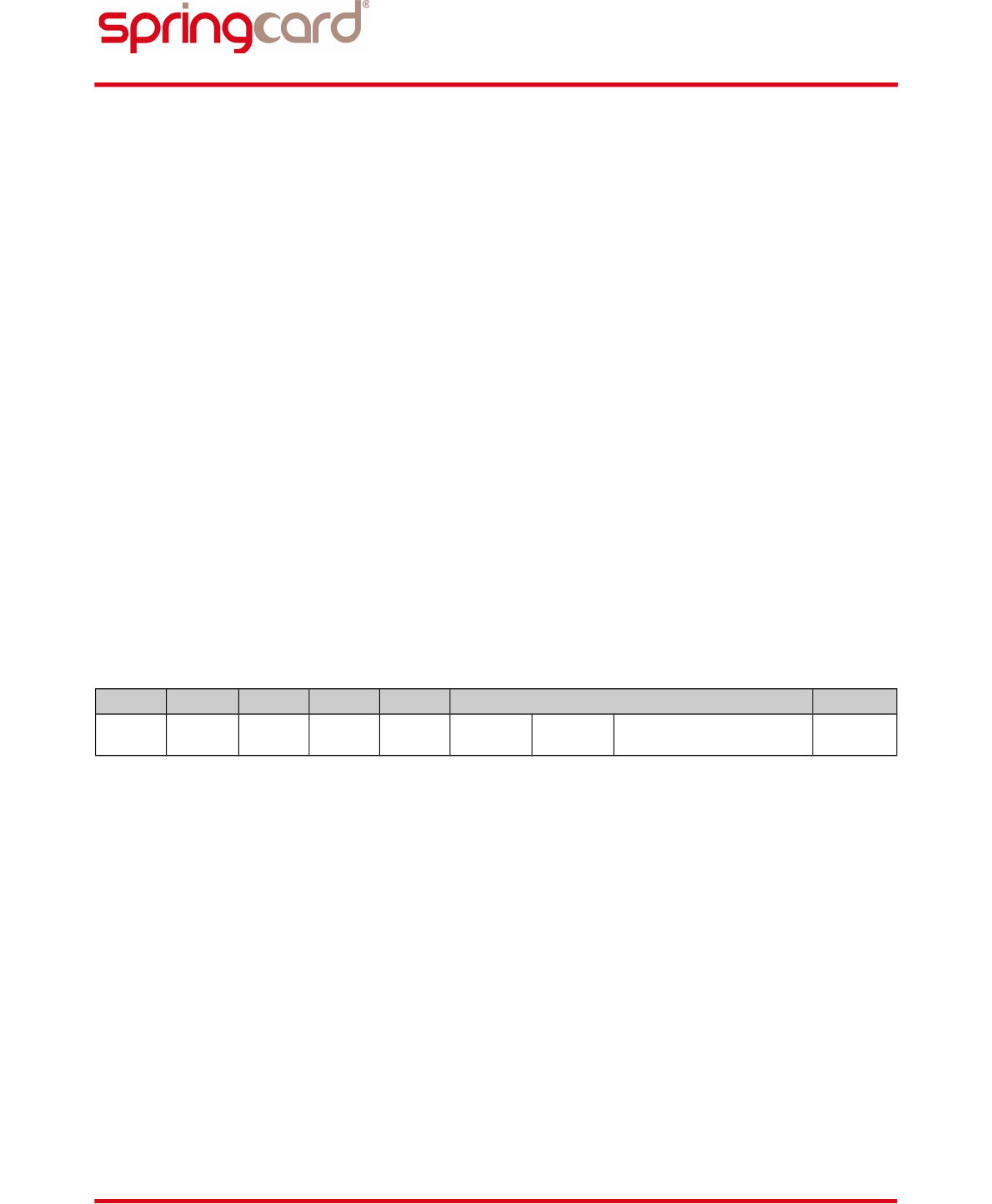
PMD2271-BA
page 78 of 118
SPRINGCARD PC/SC COUPLERS - H663 GROUP - Developer's reference manual
4.5.2. Read/write commands for ST Micro Electronics chips with a 2-B block address
ST Micro Electronics' M24LR16E (PIX.NN = hFFD3) implements an extended version of ISO 15693's
commands, where the address are on 2 bytes instead of one.
Proceed as with other ISO 15693 chips with this difference: in READ BINARY and UPDATE BINARY
instructions, P1 is the high-order byte of the address and could be non-zero.
4.5.3. Complete ISO 15693 command set
The ISO 15693 standard defines numerous commands with or without an 'option' flag, and leaves
the chip manufacturers free to implement virtually any custom or proprietary commands.
Starting with firmware version 1.81, the basic commands, in their basic implementation, are
available through the RFID MEMORY CONTROL instruction (§ 3.3.4), but it remain impossible to
implement all commands and all variations in a reader.
The ENCAPSULATE instruction (INS = hFE, see § 3.3.7) for ISO 15693 has therefore been
introduced; this instruction allows to send any arbitrary command to a 15693 chip.
Since the H663 operates the ISO 15693 chip in addressed mode (the VICC is never put into quiet
state), the chip's UID shall be provided within every command frame. The insertion of the UID is
performed automatically by the ENCAPSULATE instruction when parameter P1 is set to h05.
The APDU shall be build as follow:
CLA INS P1 P2 Lc Data In Le
hFF hFE h05 h00 XX Command
flags
Command
code
Command data
(optional) h00
Note: Le could be omitted.
SPRINGCARD, the SPRINGCARD logo, PRO ACTIVE and the PRO ACTIVE logo are registered trademarks of PRO ACTIVE SAS.
All other brand names, product names, or trademarks belong to their respective holders.
Information in this document is subject to change without notice. Reproduction without written permission of PRO ACTIVE is forbidden.

PMD2271-BA
page 79 of 118
SPRINGCARD PC/SC COUPLERS - H663 GROUP - Developer's reference manual
Allowed values for the 'command flags' byte
Bit Value Description
7 RFU 0
6 Option 0/1 Meaning is defined by the command description. Please refer
to the ISO 15693:3 standard and/or to the datasheet of the
VICC for details
5 Address 1 The UID of the VICC is included in the command frame
4 Select 0 Not using the VICC quiet state
3 Protocol
extension
0/1 Must be 0 for standard commands
Some VICC may implement vendor-specific commands that
require to have this bit set to 1
2 Inventory 0 It is not allowed to invoke the INVENTORY command through
an ENCAPSULATE APDU
1 Data rate 1 High data rate shall be used
0 Sub carrier 0 A single sub-carrier shall be used
As a summary, typical values for the 'command flags' byte are:
h22 when the option flag is not set
h62 when the option flag is required by the PICC or the command
4.5.4. Implementation of basic ISO 15693 commands
Starting with firmware version 1.81, the below commands are available through the RFID
MEMORY CONTROL instruction (§ 3.3.4)
a. Read single block
ISO 15693 command code: h20
The APDU is
FF FE 05 00 03 22
20
<block number>
b. Write single block
ISO 15693 command code: h21
The APDU is
FF FE 05 00
<3 + data length >
22
21
<block number> <...data...>
The length of the data must match the size of the block. Please refer to the VICC's datasheet to
know the size of its block.
SPRINGCARD, the SPRINGCARD logo, PRO ACTIVE and the PRO ACTIVE logo are registered trademarks of PRO ACTIVE SAS.
All other brand names, product names, or trademarks belong to their respective holders.
Information in this document is subject to change without notice. Reproduction without written permission of PRO ACTIVE is forbidden.

PMD2271-BA
page 80 of 118
SPRINGCARD PC/SC COUPLERS - H663 GROUP - Developer's reference manual
c. Lock block
ISO 15693 command code: h22
The APDU is
FF FE 05 00 03 22
22
<block number>
Locking a block makes it permanently read-only. This operation can't be cancelled. Do not
perform this operation without a good understanding of the consequence.
d. Write AFI
ISO 15693 command code: h27
The APDU is
FF FE 05 00 03 22 27
<new AFI>
e. Lock AFI
ISO 15693 command code: h28
The APDU is
FF FE 05 00 02 22 28
Locking the AFI can't be cancelled. Do not perform this operation without a good understanding
of the consequence.
f. Write DSFID
ISO 15693 command code: h29
The APDU is
FF FE 05 00 03 22 29
<new DSFID>
g. Lock DSFID
ISO 15693 command code: h2A
The APDU is
FF FE 05 00 02 22 2A
Locking the DSFID can't be cancelled. Do not perform this operation without a good
understanding of the consequence.
h. Get system information
ISO 15693 command code: h2B
The APDU is
FF FE 05 00 02 22 2B
SPRINGCARD, the SPRINGCARD logo, PRO ACTIVE and the PRO ACTIVE logo are registered trademarks of PRO ACTIVE SAS.
All other brand names, product names, or trademarks belong to their respective holders.
Information in this document is subject to change without notice. Reproduction without written permission of PRO ACTIVE is forbidden.

PMD2271-BA
page 81 of 118
SPRINGCARD PC/SC COUPLERS - H663 GROUP - Developer's reference manual
Note: the H663 always sends the Get system information command to the VICC, as part of the
discovery process. Invoke the GET DATA instruction (§ 3.2.1) to retrieve the value already returned
by the VICC to the H663.
SPRINGCARD, the SPRINGCARD logo, PRO ACTIVE and the PRO ACTIVE logo are registered trademarks of PRO ACTIVE SAS.
All other brand names, product names, or trademarks belong to their respective holders.
Information in this document is subject to change without notice. Reproduction without written permission of PRO ACTIVE is forbidden.

PMD2271-BA
page 82 of 118
SPRINGCARD PC/SC COUPLERS - H663 GROUP - Developer's reference manual
4.6. OTHER NON-ISO PICCS
4.6.1. NFC Forum Type 3 Tags / Felica
The PICCs covered by this chapter are:
Felica Lite, Felica Lite-S (PIX.NN = h003B),
Any PICC compliant with the specification of the NFC Forum Type 3 Tag.
Please visit www.nfcforum.org to get the Type 3 Tag specification.
a. READ BINARY instruction
In the READ BINARY command APDU,
P1 must be h00,
P2 is the address of the first block to read.
Since the size of a block is 16 bytes, Le must be multiple of 16 (h10). When Le=h00, a single block is
returned (16 bytes).
It is possible to read up to 8 blocks at once.
The READ BINARY instruction is translated into the Felica “CHECK” command, using the current
SERVICE CODE for READ BINARY value as the “Service Code” parameter to the command. The
default value for this parameter is h000B. See § 3.3.6 if you need to change value.
b. UPDATE BINARY instruction (single byte)
In the UPDATE BINARY command APDU,
P1 must be h00,
P2 is the address of the (single) block to be written.
Since the size of a block is 16 bytes, Lc must be 16 (h10), exactly.
The UPDATE BINARY instruction is translated into the Felica “UPDATE” command, using the
current SERVICE CODE for UPDATE BINARY value as the “Service Code” parameter to the
command. The default value for this parameter is h0009. See § 3.3.6 if you need to change value.
SPRINGCARD, the SPRINGCARD logo, PRO ACTIVE and the PRO ACTIVE logo are registered trademarks of PRO ACTIVE SAS.
All other brand names, product names, or trademarks belong to their respective holders.
Information in this document is subject to change without notice. Reproduction without written permission of PRO ACTIVE is forbidden.

PMD2271-BA
page 83 of 118
SPRINGCARD PC/SC COUPLERS - H663 GROUP - Developer's reference manual
4.7. OTHER NON-ISO VICCS
4.7.1. EM4134
These VICCs use the ISO 15693 bit modulation, but a vendor-specific frame format and command
set. They are recognized by PIX.NN = hFF D6. They are divided into 16 words, each word being 32-
bit (4-Byte) wide.
a. READ BINARY instruction
In the READ BINARY command APDU,
P1 must be h00,
P2 is the address of the first word to read (0 to 15).
Since the size of a word is 4 bytes, Le must be multiple of 4 (h04). When Le=h00, a single word is
returned (4 bytes).
It is possible to read up the complete card's content (16 words) at once.
b. UPDATE BINARY instruction
In the UPDATE BINARY command APDU,
P1 must be h00,
P2 is the address of the word to be written.
Since the size of a word is 4 bytes, Lc must be 4 (h04), exactly.
c. Lock
Locking a word is implemented through the RFID MEMORY CONTROL instruction, using the Lock
Block function code (§ 3.3.4.c).
SPRINGCARD, the SPRINGCARD logo, PRO ACTIVE and the PRO ACTIVE logo are registered trademarks of PRO ACTIVE SAS.
All other brand names, product names, or trademarks belong to their respective holders.
Information in this document is subject to change without notice. Reproduction without written permission of PRO ACTIVE is forbidden.
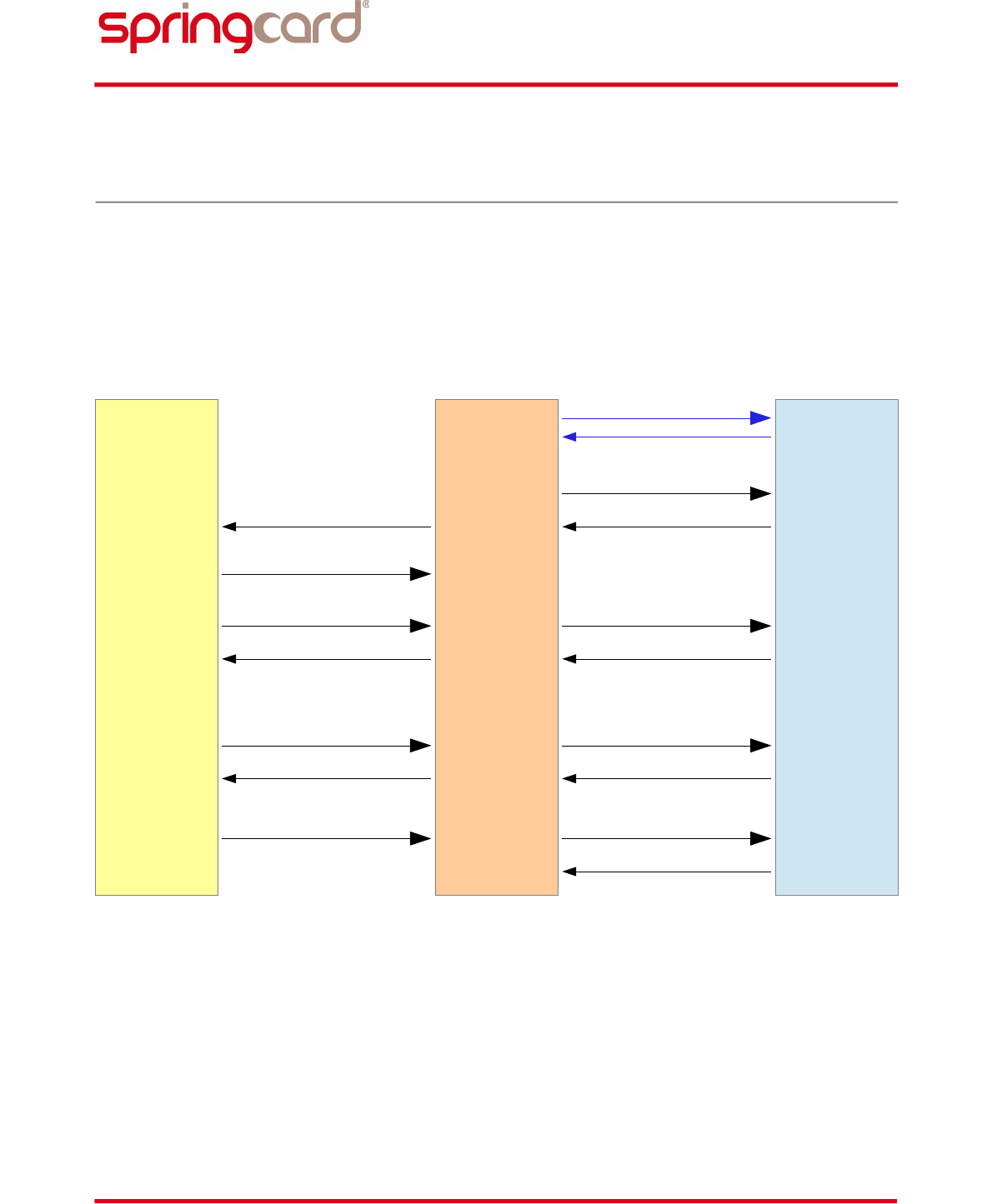
PMD2271-BA
page 84 of 118
SPRINGCARD PC/SC COUPLERS - H663 GROUP - Developer's reference manual
5. USING THE H663 WITH A NFCIP-1 TARGET
5.1. INTRODUCTION
The H663 is a NFC Initiator. It could activate a remote NFC Target (only the passive communication
scheme is available).
The H663 implements the ISO 18092 “NFCIP-1” Transport Protocol, also named NFC-DEP by the
NFC Forum.
* The PDU must be ENCAPSULATEd if it doesn't meet ISO 7816-4 constraints.
5.1.1. Functions performed by the coupler
The H663 handles the NFC Transport Protocol internally:
•Transmission of ATR_REQ when a potential NFC Target has been detected, handing of
ATR_RES,
•Initial exchange of parameters (PSL_RES / PSL_RES) if needed,
•Fragmentation of DEP_REQ, chaining of DEP_RES,
SPRINGCARD, the SPRINGCARD logo, PRO ACTIVE and the PRO ACTIVE logo are registered trademarks of PRO ACTIVE SAS.
All other brand names, product names, or trademarks belong to their respective holders.
Information in this document is subject to change without notice. Reproduction without written permission of PRO ACTIVE is forbidden.
PC
application
H663 ISO
18092
target
(A or F)
Polling + anticollision
(SENS-A, SENS-F)
Enter NFC-DEP
(ATR_REQ)
(ATR_RES)
Card insert event
(SCardWaitStatusChange)
Connect to the target
(SCardConnect)
Send PDU
(ScardTransmit FF FE … *)
PDU from initiator
(DEP_REQ)
PDU from target
(DEP_RES)
Recv PDU
(ScardTransmit success)
Send PDU
(ScardTransmit FF FE … *)
PDU from initiator
(DEP_REQ)
PDU from target
(DEP_RES)
Recv PDU
(ScardTransmit success)
(...) (...)
Disconnect from the target
(SCardDisconnect)
Leave NFC-DEP
(DSL_REQ)
(DSL_RES)
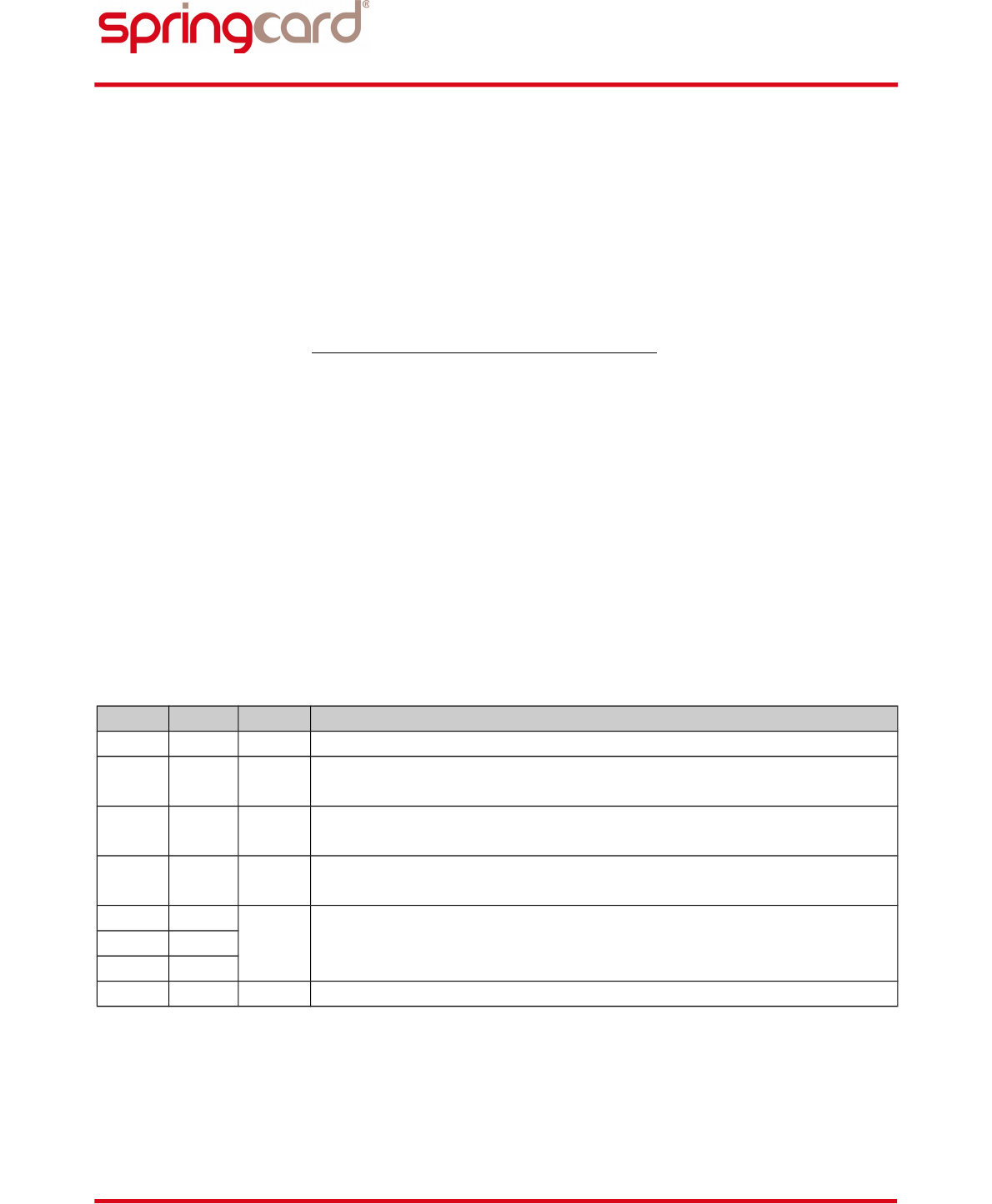
PMD2271-BA
page 85 of 118
SPRINGCARD PC/SC COUPLERS - H663 GROUP - Developer's reference manual
•Detection of transmission errors and recovery procedure,
•Detection of Target removal.
5.1.2. Functions to be implemented on the PC
In the NFC Forum's architecture, NFC-DEP (ISO 18092) is seen as the low level transmission layer
(“MAC”) of an upper-level connection-oriented protocol called LLCP.
As the H663 only implements ISO 18092, upper-level protocols and applications (for instance, LLCP
and SNEP on top of LLCP) must be implemented by a PC application. SpringCard SDK for PC/SC +
NFC provides various samples to do so. Please download this SDK from our web site.
Anyway, as support for LLCP must be claimed by the NFC initiator in its ATR_REQ, the H663 has
configurable GI bytes, the default being the following value, compliant with LLCP:
46 66 6D 01 01 11 03 02 00 13 04 01 96
To change the GI bytes, typically to disable LLCP, refer to § 5.3.1
5.2. MAPPING OF THE NFC FUNCTIONS INTO PC/SC FUNCTIONS
5.2.1. ATR of an ISO 18092 target
The H663 builds a pseudo-ATR using the standard format defined in PC/SC specification:
Offset Name Value Meaning (according to 7816-3)
0 TS h3B Direct convention
1 T0 h8… Higher nibble 8 means: no TA1, no TB1, no TC1. TD1 to follow
Lower nibble is the number of historical bytes (0 to 15)
2 TD1 h80 Higher nibble 8 means: no TA2, no TB2, no TC2. TD2 to follow
Lower nibble 0 means: protocol T=0
3 TD2 h01 Higher nibble 8 means: no TA3, no TB3, no TC3, no TD3
Lower nibble 1 means: protocol T=1
4 H1
… GT bytes from ATR_RES… …
3+k Hk
4+k TCK XX Checksum (XOR of bytes 1 to 3+k)
The target is LLCP compliant if ifs GT bytes start with
46 66 6D
SPRINGCARD, the SPRINGCARD logo, PRO ACTIVE and the PRO ACTIVE logo are registered trademarks of PRO ACTIVE SAS.
All other brand names, product names, or trademarks belong to their respective holders.
Information in this document is subject to change without notice. Reproduction without written permission of PRO ACTIVE is forbidden.
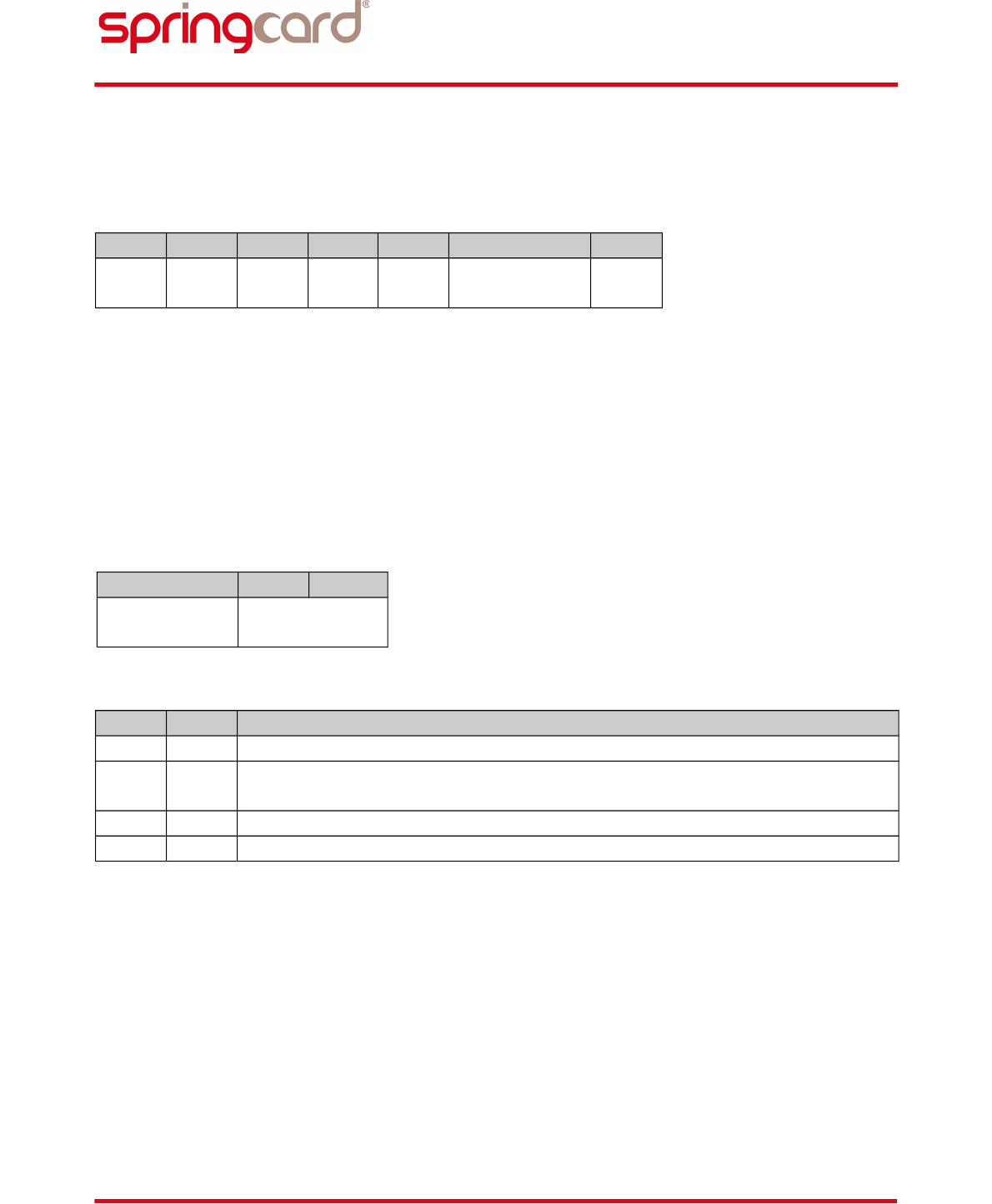
PMD2271-BA
page 86 of 118
SPRINGCARD PC/SC COUPLERS - H663 GROUP - Developer's reference manual
5.2.2. Using SCardTransmit (ENCAPSULATE) to exchange PDUs
ENCAPSULATE command APDU = DEP_REQ
CLA INS P1 P2 Lc Data In Le
hFF hFE h00 h00 XX Transport data
bytes h00
Up to 255 bytes of Transport data can be transmitted this way.
The H663 adds the PFB (and the DID if required) and transmits a valid block. If the target's receive
buffer is shorter than the actual size of the transport PDU, chained blocks are automatically. NAD
is not supported.
During the reception of chained block, the H663 re-assembles them and returns a single response.
Up to 256 bytes of Transport data can be received.
ENCAPSULATE response = DEP_RES
Data Out SW1 SW2
Transport data
bytes See below
ENCAPSULATE status word
SW1 SW2 Meaning
h90 h00 Success
h6F XX Error reported by the contactless interface. See chapter 6 for the list of possible
values and their meaning.
h62 h82 Le is greater than actual response from target
h6C XX Le is shorter than actual response from target
5.3. ADVANCED FEATURES
5.3.1. Changing the GI bytes in the ATR_REQ
The General Bytes to be transmitted in the H663's ATR_REQ (GI bytes) are stored in register hE1.
SPRINGCARD, the SPRINGCARD logo, PRO ACTIVE and the PRO ACTIVE logo are registered trademarks of PRO ACTIVE SAS.
All other brand names, product names, or trademarks belong to their respective holders.
Information in this document is subject to change without notice. Reproduction without written permission of PRO ACTIVE is forbidden.

PMD2271-BA
page 87 of 118
SPRINGCARD PC/SC COUPLERS - H663 GROUP - Developer's reference manual
If this register remains empty, the default value is:
46 66 6D LLCP magic number
01 01 11 LLCP version 1.1
03 02 00 13 Services = LLC Link Management + SNEP (NDEF exchange protocol)
04 01 96 Link time-out = 1.5 seconds
Use the PUSH REGISTER command (§ 6.3.7) to set the new General Bytes before putting a new
NFC target in front of the H663's antenna.
Alternatively, use the WRITE REGISTER command (§ 6.3.6) if you want the new configuration to be
permanent. Pay attention that the non-volatile memory has a limited write endurance.
SPRINGCARD, the SPRINGCARD logo, PRO ACTIVE and the PRO ACTIVE logo are registered trademarks of PRO ACTIVE SAS.
All other brand names, product names, or trademarks belong to their respective holders.
Information in this document is subject to change without notice. Reproduction without written permission of PRO ACTIVE is forbidden.

PMD2271-BA
page 88 of 118
SPRINGCARD PC/SC COUPLERS - H663 GROUP - Developer's reference manual
6. DIRECT CONTROL OF THE H663
6.1. BASIS
In PC/SC architecture, the SCardControl function implements the dialogue between an application
and the coupler, even when there’s no card in the slot.
Access to the coupler must be gained using SCardConnect, specifying SCARD_SHARE_DIRECT as
coupler sharing mode.
Not all PC/SC drivers allow the application to gain direct access to the coupler. If you're using
SpringCard SDD480 PC/SC driver for Windows, there's nothing specific to do, but for other
drivers, a specific configuration of the driver has to be performed. Please refer to chapter 9: Annex
B – activating SCardControl with the different drivers.
6.2. IMPLEMENTATION DETAILS
6.2.1. Sample code
#include <winscard.h>
// dwControlCode for SpringCard SDD480 driver
#define IOCTL_SC_PCSC_ESCAPE SCARD_CTL_CODE(2048)
// dwControlCode for Microsoft CCID drivers
#define IOCTL_MS_PCSC_ESCAPE SCARD_CTL_CODE(3050)
// This function is a wrapper around SCardControl
// It creates its own PC/SC context for convenience, but you
// may remain into a previously open context
// Note: Use SCardListReaders to get reader_name
LONG reader_control(const char *reader_name,
const BYTE in_buffer[],
DWORD in_length,
BYTE out_buffer[],
DWORD max_out_length,
DWORD *got_out_length)
{
SCARDCONTEXT hContext;
SCARDHANDLE hCard;
LONG rc;
DWORD dwProtocol;
rc = SCardEstablishContext(SCARD_SCOPE_SYSTEM,
NULL,
NULL,
&hContext);
if (rc != SCARD_S_SUCCESS)
return rc;
SPRINGCARD, the SPRINGCARD logo, PRO ACTIVE and the PRO ACTIVE logo are registered trademarks of PRO ACTIVE SAS.
All other brand names, product names, or trademarks belong to their respective holders.
Information in this document is subject to change without notice. Reproduction without written permission of PRO ACTIVE is forbidden.

PMD2271-BA
page 89 of 118
SPRINGCARD PC/SC COUPLERS - H663 GROUP - Developer's reference manual
// get a direct connection to the reader
// this must succeed even when there’s no card
rc = SCardConnect(hContext,
reader_name,
SCARD_SHARE_DIRECT,
0,
&hCard,
&dwProtocol);
if (rc != SCARD_S_SUCCESS)
{
SCardReleaseContext(hContext);
return rc;
}
// direct control through SCardControl
// dwControlCode for SpringCard SDD480 driver
rc = SCardControl(hCard,
IOCTL_SC_PCSC_ESCAPE,
in_buffer,
in_length,
out_buffer,
max_out_length,
got_out_length);
if ((rc == ERROR_INVALID_FUNCTION)
|| (rc == ERROR_NOT_SUPPORTED)
|| (rc == RPC_X_BAD_STUB_DATA))
{
// direct control through SCardControl
// dwControlCode for Microsoft CCID drivers
rc = SCardControl(hCard,
IOCTL_MS_PCSC_ESCAPE,
in_buffer,
in_length,
out_buffer,
max_out_length,
got_out_length);
}
// close the connection
// the dwDisposition parameter is coherent with the fact
// that we didn’t do anything with the card (or that there’s
// no card in the reader)
SCardDisconnect(hCard, SCARD_LEAVE_CARD);
SCardReleaseContext(hContext);
return rc;
}
SPRINGCARD, the SPRINGCARD logo, PRO ACTIVE and the PRO ACTIVE logo are registered trademarks of PRO ACTIVE SAS.
All other brand names, product names, or trademarks belong to their respective holders.
Information in this document is subject to change without notice. Reproduction without written permission of PRO ACTIVE is forbidden.

PMD2271-BA
page 90 of 118
SPRINGCARD PC/SC COUPLERS - H663 GROUP - Developer's reference manual
6.2.2. Link to SpringProx legacy protocol
Sending an escape sequence through SCardControl (with appropriate value for dwControlCode) is
exactly the same as sending a “legacy command” to a SpringCard coupler running in legacy mode.
The detailed reference of all the command supported by our readers is available in SpringCard
CSB4, K531, K632 or K663 development kits. The paragraphs below depict only a subset of the
whole function list, but the functions listed here are the most useful in the PC/SC context.
6.2.3. Format of response, return codes
When the dialogue with the H663 has been performed successfully, SCardControl returns
SCARD_S_SUCCESS, and at least one byte is returned in out_buffer (at position 0).
The value of this byte is the actual coupler's status code: h00 on success, a non-zero value upon
error. The complete list of the H663’s error codes is given in chapter 8: Annex A – Specific error
codes.
When there’s some data available, the data is returned at position 1 in out_buffer.
6.2.4. Redirection to the Embedded APDU Interpreter
SCardControl buffers starting by hFF (CLA byte of the Embedded APDU Interpreter) as processed as
if they were received in a SCardTransmit stream.
SPRINGCARD, the SPRINGCARD logo, PRO ACTIVE and the PRO ACTIVE logo are registered trademarks of PRO ACTIVE SAS.
All other brand names, product names, or trademarks belong to their respective holders.
Information in this document is subject to change without notice. Reproduction without written permission of PRO ACTIVE is forbidden.
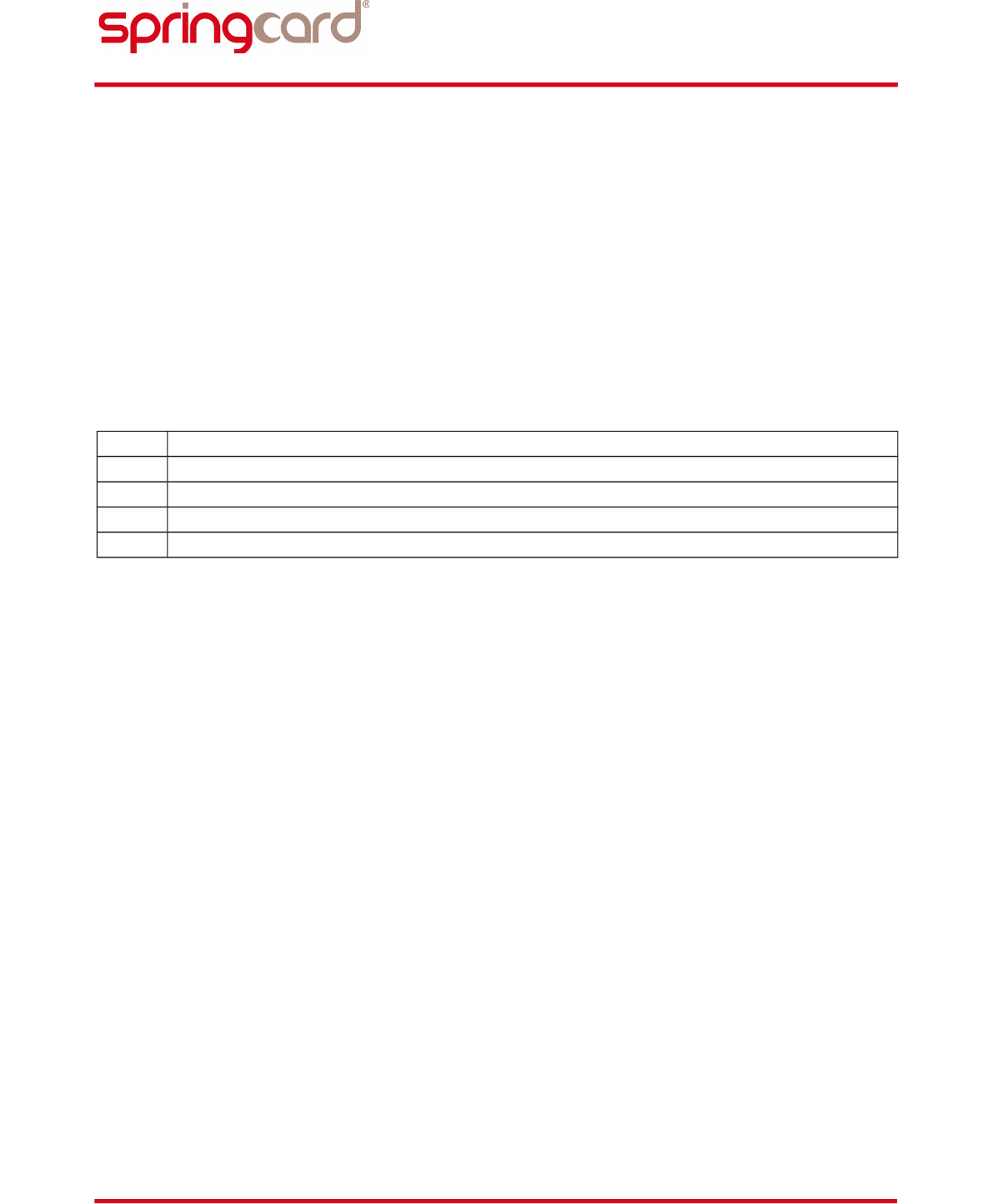
PMD2271-BA
page 91 of 118
SPRINGCARD PC/SC COUPLERS - H663 GROUP - Developer's reference manual
6.3. LIST OF AVAILABLE CONTROL SEQUENCES
6.3.1. Action on the LEDs
a. Setting the coupler's LEDs manually
For a coupler with only red and green LEDs, send the sequence:
58 1E <red> <green>
For a coupler with red, green and yellow / blue LEDs, send the sequence:
58 1E <red> <green> <yellow/blue>
Choose values for red, green and yellow/blue in this table:
h00 LED is switched OFF
h01 LED is switched ON
h02 LED blinks slowly
h04 LED blinks quickly
h05 LED performs the “heart-beat” sequence
Once such a command has been sent to the H663, the firmware no longer manages the LEDs
automatically: the LEDs remain permanently in the last state specified by the application.
Use the above command to make the firmware drive the LEDs automatically again.
b. Going back to default (LEDs managed by the coupler's firmware)
Send the sequence
58 1E
To go back to default mode.
SPRINGCARD, the SPRINGCARD logo, PRO ACTIVE and the PRO ACTIVE logo are registered trademarks of PRO ACTIVE SAS.
All other brand names, product names, or trademarks belong to their respective holders.
Information in this document is subject to change without notice. Reproduction without written permission of PRO ACTIVE is forbidden.

PMD2271-BA
page 92 of 118
SPRINGCARD PC/SC COUPLERS - H663 GROUP - Developer's reference manual
6.3.2. Action on the buzzer
a. Starting/stopping the buzzer
Some hardware feature a single tone beeper. To start the buzzer, send the sequence:
58 1C
<duration MSB>
<duration LSB>
Where duration specifies the length of the tone, in milliseconds (max is 60000ms).
Set duration to 0 if you need to stop the buzzer before the duration started in a previous call.
Once such a command has been sent to the H663, the firmware no longer manages the buzzer
automatically.
Use the above command to make the firmware drive the buzzer automatically again.
b. Going back to default (buzzer managed by the coupler's firmware)
Send the sequence
58 1C
To go back to default mode.
SPRINGCARD, the SPRINGCARD logo, PRO ACTIVE and the PRO ACTIVE logo are registered trademarks of PRO ACTIVE SAS.
All other brand names, product names, or trademarks belong to their respective holders.
Information in this document is subject to change without notice. Reproduction without written permission of PRO ACTIVE is forbidden.
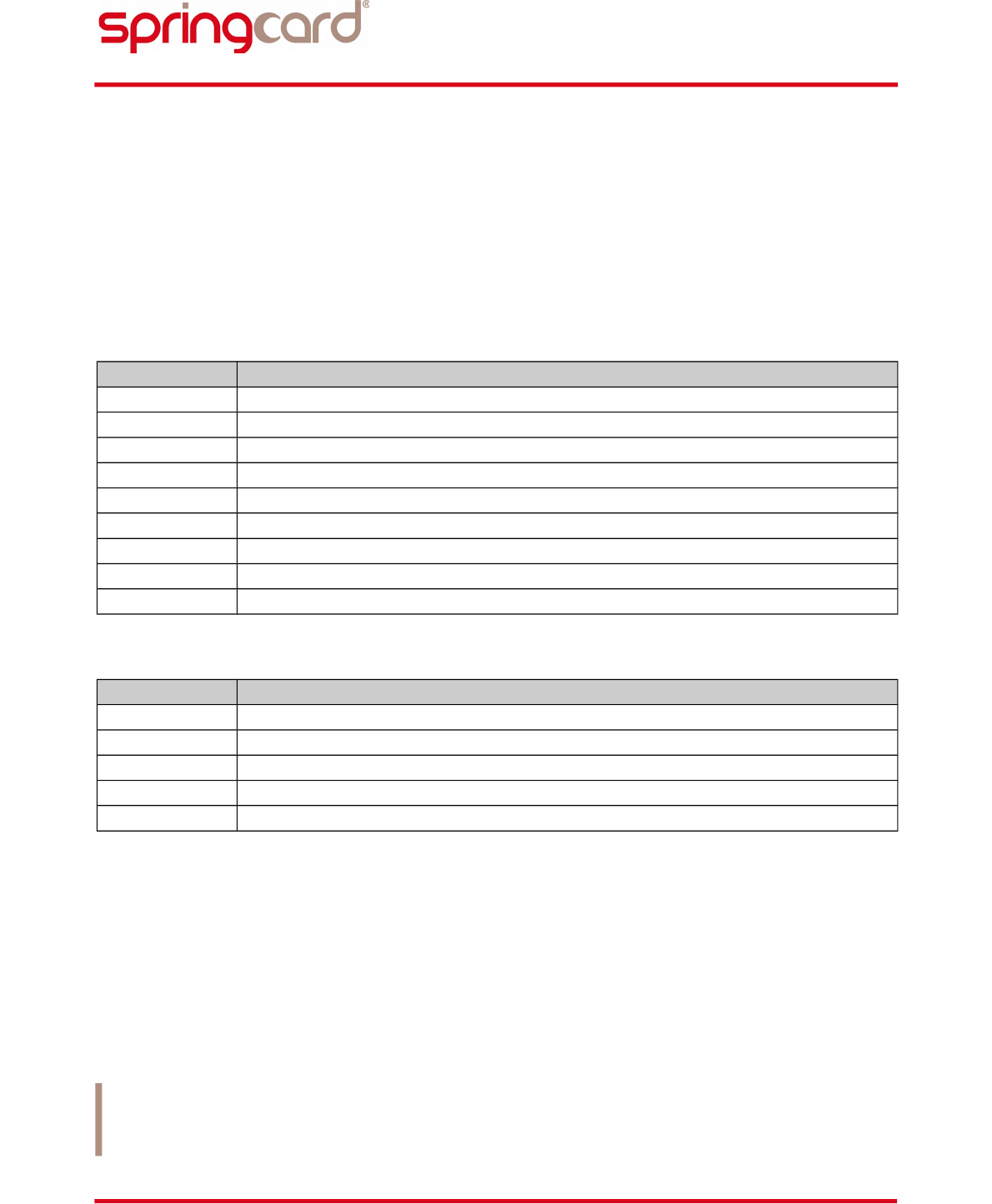
PMD2271-BA
page 93 of 118
SPRINGCARD PC/SC COUPLERS - H663 GROUP - Developer's reference manual
6.3.3. Obtaining information on coupler and slots
The sequences below are useful to retrieve textual information such as product name, slot name,
etc. The numerical information (such as version, serial number) are returned as hexadecimal
strings.
Remember that the returned value (if some) is prefixed by the status code (h00 on success).
a. Coupler “product-wide” information
Sequence Will return…
58 20 01 Vendor name (“SpringCard”)
58 20 02 Product name
58 20 03 Product serial number (in ASCII)
58 20 04 USB vendor ID and product ID (in ASCII)
58 20 05 Product version (in ASCII)
58 20 80 Number of slots (raw value on 1 byte)
58 20 83 Product serial number (raw value on 4 bytes)
58 20 84 USB vendor ID and product ID (raw value on 4 bytes)
58 20 85 Product version (raw value on 3 bytes: major/minor/build)
b. Slot related information
Sequence Will return…
58 21 Name of the current slot
58 21 00 Name of slot 0
58 21 01 Name of slot 1
...
58 21 NN Name of slot N
Slot naming obey to the following rule:
The contactless slot is named “Contactless”,
When a contact smartcard slot is present, its name is “Contact”,
When only one SIM/SAM slot is present, its name is either “SAM A” or “SAM” depending
on the configuration set in factory,
When more than one SIM/SAM slots are present, they are named “SIM/SAM A”, “SIM/SAM
B”, “SIM/SAM C” and “SIM/SAM D”.
SpringCard CCID driver for Windows (ref. SDD480) uses those names to construct the list that is
returned to SCardListReaders. Other drivers are likely to implement a different naming
convention.
SPRINGCARD, the SPRINGCARD logo, PRO ACTIVE and the PRO ACTIVE logo are registered trademarks of PRO ACTIVE SAS.
All other brand names, product names, or trademarks belong to their respective holders.
Information in this document is subject to change without notice. Reproduction without written permission of PRO ACTIVE is forbidden.
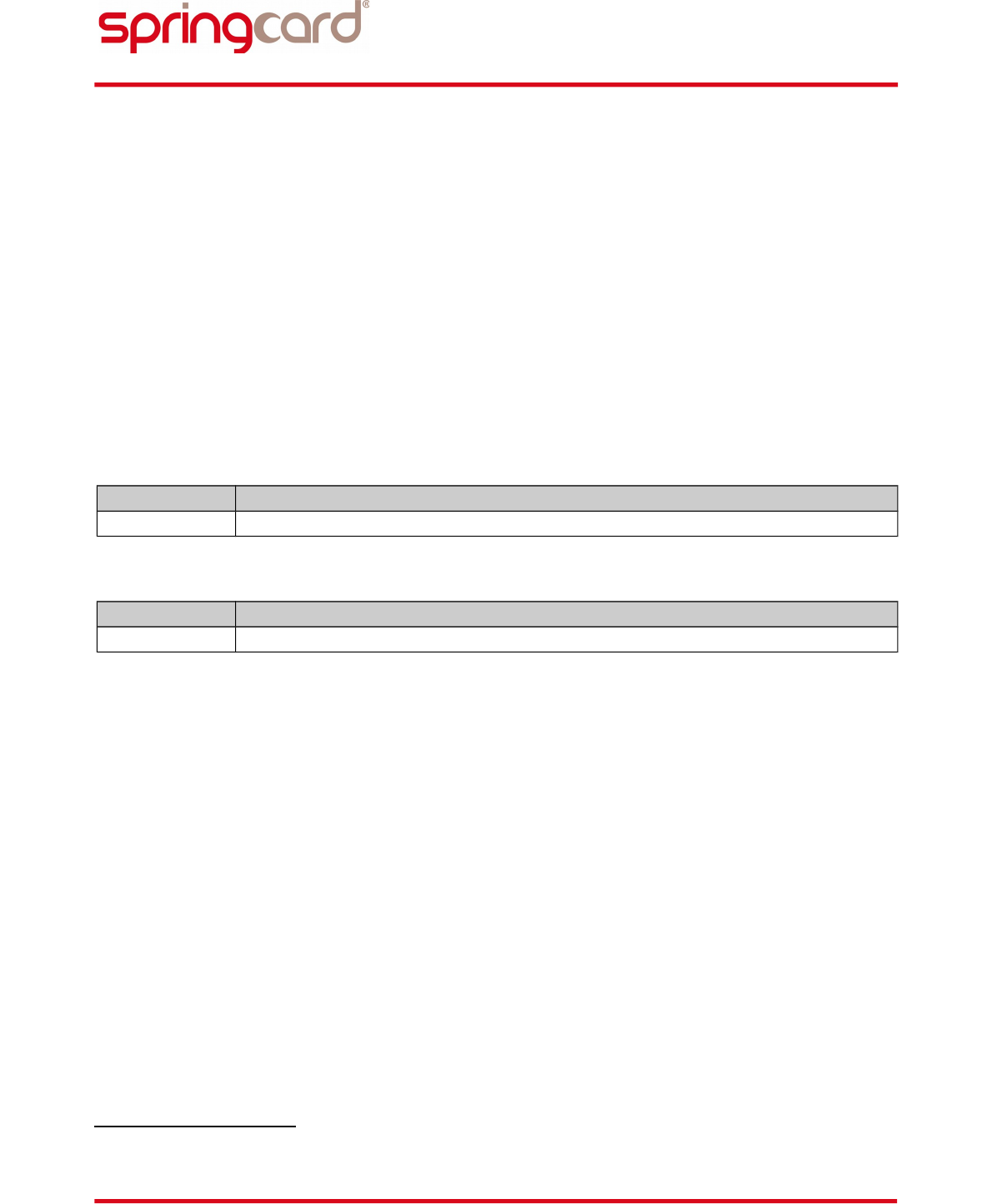
PMD2271-BA
page 94 of 118
SPRINGCARD PC/SC COUPLERS - H663 GROUP - Developer's reference manual
6.3.4. Stopping / starting a slot
When a slot is stopped, the H663
powers down the smartcard in the slot (if some),
disable the slot22,
send the “card removed” event if there was a card in the slot.
When a slot is started again, the H663
enable the slot23,
try to power up the smartcard in the slot (if some),
if a card has been found, send the “card inserted” event.
a. Stopping a slot
Sequence Action
58 22 Stop current slot
b. Starting a slot
Sequence Action
58 23 Start current slot
22 On contactless slot, the antenna RF field is switched OFF
23 On contactless slot, the antenna RF field is switched ON
SPRINGCARD, the SPRINGCARD logo, PRO ACTIVE and the PRO ACTIVE logo are registered trademarks of PRO ACTIVE SAS.
All other brand names, product names, or trademarks belong to their respective holders.
Information in this document is subject to change without notice. Reproduction without written permission of PRO ACTIVE is forbidden.
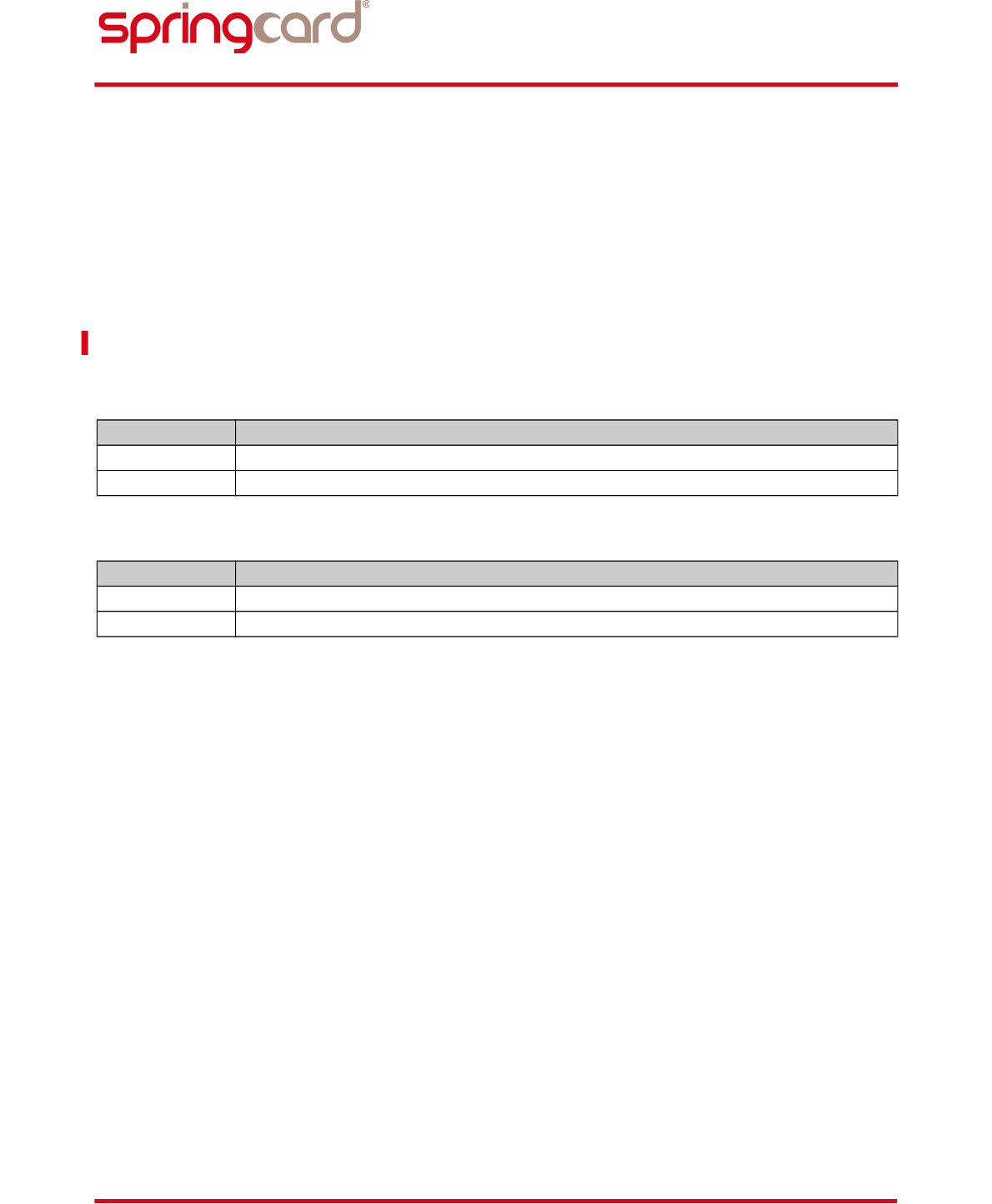
PMD2271-BA
page 95 of 118
SPRINGCARD PC/SC COUPLERS - H663 GROUP - Developer's reference manual
6.3.5. Forced insert/remove sequences
Use these sequences to emulate card insertion or removal. This is useful for hardware where no
“card presence” switch is available.
Pay attention that if no card is actually present when the Card insertion is performed, the H663
will be busy a long time (for nothing), before eventually giving up and reporting the “card mute”
status.
DO NOT use this feature unless explicitly advised by SpringCard's support team.
a. Card insertion
Sequence Action
58 40 01 01 Simulate a card insertion in the 1st card slot (ID-1 slot if existing)
58 40 01 Simulate a card insertion in the current slot
b. Card remove
Sequence Action
58 40 01 00 Simulate a card removal from the 1st card slot (ID-1 slot if existing)
58 40 00 Simulate a card removal from the current slot
SPRINGCARD, the SPRINGCARD logo, PRO ACTIVE and the PRO ACTIVE logo are registered trademarks of PRO ACTIVE SAS.
All other brand names, product names, or trademarks belong to their respective holders.
Information in this document is subject to change without notice. Reproduction without written permission of PRO ACTIVE is forbidden.

PMD2271-BA
page 96 of 118
SPRINGCARD PC/SC COUPLERS - H663 GROUP - Developer's reference manual
6.3.6. Reading/writing H663's configuration registers
The H663 features a non-volatile memory to store configuration registers.
See chapter 7 for the list of these registers, and their allowed values.
a. Reading coupler’s registers
To read the value of the configuration register at <index>, send the sequence:
58 0E <index>
Remember that the returned value (if some) is prefixed by the status code (h00 on success, h16 if
the value is not defined in the non-volatile memory).
b. Writing coupler’s registers
To define the value of the configuration register at <index>, send the sequence:
58 0D <index> <…data…>
Send an empty <data> (zero-length) to erase the current value. In this case, default value will be
used.
The non-volatile memory has a limited write/erase endurance.
Writing a different value in a configuration register more than 100 times may permanently
damage your product.
The configuration is loaded upon reset. To apply a new configuration, you must reset the H663
(or cycle power).
Alternatively, you may load temporary configuration settings as explained in the next paragraph.
SPRINGCARD, the SPRINGCARD logo, PRO ACTIVE and the PRO ACTIVE logo are registered trademarks of PRO ACTIVE SAS.
All other brand names, product names, or trademarks belong to their respective holders.
Information in this document is subject to change without notice. Reproduction without written permission of PRO ACTIVE is forbidden.

PMD2271-BA
page 97 of 118
SPRINGCARD PC/SC COUPLERS - H663 GROUP - Developer's reference manual
6.3.7. Pushing a new temporary configuration
To overrule temporarily the value of the configuration register at <index>, send the sequence:
58 8D <index> <…data…>
Send an empty <data> (zero-length) to reload the default value.
This value will be applied immediately, but on next reset the H663 will reload its configuration
registers from the non-volatile memory.
SPRINGCARD, the SPRINGCARD logo, PRO ACTIVE and the PRO ACTIVE logo are registered trademarks of PRO ACTIVE SAS.
All other brand names, product names, or trademarks belong to their respective holders.
Information in this document is subject to change without notice. Reproduction without written permission of PRO ACTIVE is forbidden.

PMD2271-BA
page 98 of 118
SPRINGCARD PC/SC COUPLERS - H663 GROUP - Developer's reference manual
7. CONFIGURATION REGISTERS
The H663 features a non-volatile memory to store its configuration.
The memory is divided into “registers”. Every register is identified by its address (a 1-B value) and
is documented in this chapter.
Warning 1
Some registers are not listed in this chapter, yet they may have been defined in factory, or should
use the default value for correct operation. Do not write or erase any register that is not listed in
this chapter.
Warning 2
The non-volatile memory has a limited write/erase endurance.
Writing a different value in a configuration register more than 100 times may permanently
damage your product.
7.1. EDITING COUPLER'S CONFIGURATION
7.1.1. By software
The coupler's configuration registers are made available through a SCardControl function call.
Refer to § 6.3.6 for details.
The configuration is loaded upon reset. To apply the new configuration, the software shall
prompt the user to reset or unplug/plug the H663.
7.1.2. Using SpringCard MultiConf software
SpringCard has developed a versatile configuration software24 that covers most products,
including the H663 and all readers in the H663 family.
Download SpringCard MultiConf at http://www.springcard.com/en/download/find/file/sn14007
24 Available for the Windows platform only.
SPRINGCARD, the SPRINGCARD logo, PRO ACTIVE and the PRO ACTIVE logo are registered trademarks of PRO ACTIVE SAS.
All other brand names, product names, or trademarks belong to their respective holders.
Information in this document is subject to change without notice. Reproduction without written permission of PRO ACTIVE is forbidden.

PMD2271-BA
page 99 of 118
SPRINGCARD PC/SC COUPLERS - H663 GROUP - Developer's reference manual
7.2. LIST OF THE CONFIGURATION REGISTERS AVAILABLE TO THE END-USER OR INTEGRATOR
Address Section Name See §
hB0 Contactless Enabled protocols 7.5.1
hB2 PC/SC CLA of the APDU interpreter 7.4.2
hB3 PC/SC RF behaviour in PC/SC mode 7.4.3
hB4 Contactless Parameters for polling 7.5.2
hC3 7816 Options for the smartcard slots 7.8.1
hC4 Contactless Allowed baudrates in T=CL 7.5.4
hC5 Contactless Options for T=CL 7.5.5
hC8 Contactless Number of antennas + automatic stop 7.5.6
hC9 Contactless Options for polling 7.5.3
hCA Core Configuration of the LEDs 7.3.1
hCB Core Options for the LEDs and GPIOs 7.3.2
hCC Core Behaviour of the LEDs and buzzer 7.3.3
hCF Felica Service Codes for Felica read/write 7.6.1
hE1 NFC P2P Global Bytes bytes in ATR_REQ 7.7.1
Do not write or erase any register that is not listed in this chapter.
SPRINGCARD, the SPRINGCARD logo, PRO ACTIVE and the PRO ACTIVE logo are registered trademarks of PRO ACTIVE SAS.
All other brand names, product names, or trademarks belong to their respective holders.
Information in this document is subject to change without notice. Reproduction without written permission of PRO ACTIVE is forbidden.

PMD2271-BA
page 100 of 118
SPRINGCARD PC/SC COUPLERS - H663 GROUP - Developer's reference manual
7.3. CORE CONFIGURATION
7.3.1. Configuration of the LEDs
Address: hCA – Size: 2 bytes
Bit Action if set Note
msb 15 - 12 LED 1
h0: colour is undefined
h1: colour is red
h2: colour is green
h3: colour is yellow
h4: colour is blue
11 - 8 LED 2
h0: colour is undefined
h1: colour is red
h2: colour is green
h3: colour is yellow
h4: colour is blue
7 - 4 LED 3
h0: colour is undefined
h1: colour is red
h2: colour is green
h3: colour is yellow
h4: colour is blue
lsb 3 - 0 LED 4
h0: colour is undefined
h1: colour is red
h2: colour is green
h3: colour is yellow
h4: colour is blue
Default value: h0000
SPRINGCARD, the SPRINGCARD logo, PRO ACTIVE and the PRO ACTIVE logo are registered trademarks of PRO ACTIVE SAS.
All other brand names, product names, or trademarks belong to their respective holders.
Information in this document is subject to change without notice. Reproduction without written permission of PRO ACTIVE is forbidden.
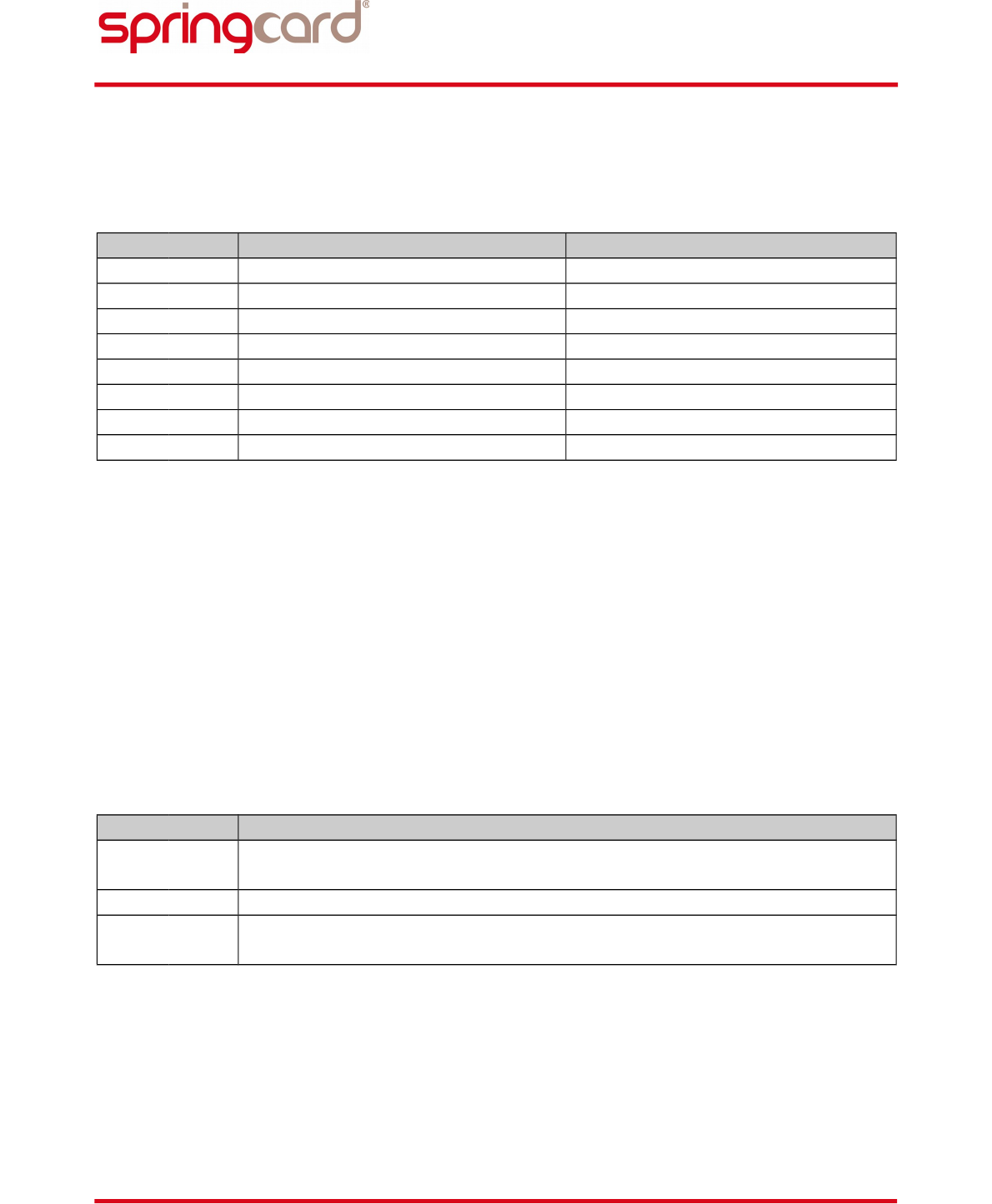
PMD2271-BA
page 101 of 118
SPRINGCARD PC/SC COUPLERS - H663 GROUP - Developer's reference manual
7.3.2. Options for the LEDs and GPIOs
Address: hC9 – Size: 1 byte1
Bit Action if set Note
msb 7 Use PWM for buzzer
6 RFU
5 RFU
4 RFU
3 Invert logic for LED 4
2 Invert logic for LED 3
1 Invert logic for LED 2
lsb 0 Invert logic for LED 1
Default value: h00
7.3.3. Behaviour of the LEDs and buzzer
If the coupler has some LEDs, the coupler shows its state (card present, card absent, error) by its
LEDs. You may disable this feature by setting bit 7 of this register to 1 (the application is still able
to control the LEDs as documented in § 6.3.1.a and 3.4.1.a).
If the coupler has a buzzer, the buzzer sounds every time a PICC is activated. The 6 low-order bytes
of this register define the duration or this beep, in 10ms interval. To disable the automatic beep
on card arrival, set this value to 0 (the application is still able to control the buzzer as documented
in § 6.3.2 and 3.4.1.b).
Address: hCC – Size: 1 byte
Bit Values / Meaning
msb 7 1 : the H663 does signal its state on the LEDs
0 : the H663 doesn't signal its state on the LEDs
6 RFU, must be 0
lsb 5 Duration of the automatic beep on card arrival, x 10ms (0 to 630ms)
Set to h00 to disable the automatic beep
Default value: h88 (80ms beep on PICC arrival + state on LEDs)
SPRINGCARD, the SPRINGCARD logo, PRO ACTIVE and the PRO ACTIVE logo are registered trademarks of PRO ACTIVE SAS.
All other brand names, product names, or trademarks belong to their respective holders.
Information in this document is subject to change without notice. Reproduction without written permission of PRO ACTIVE is forbidden.

PMD2271-BA
page 102 of 118
SPRINGCARD PC/SC COUPLERS - H663 GROUP - Developer's reference manual
7.4. PC/SC CONFIGURATION
7.4.1. Slot naming and startup mode
Address: hB1 – Size: 1 byte
Bit Action if set Note
msb 7 Force a letter in the name of the SAM
slots
Even if there's only one slot, it will be
named “SAM A”
6 Force a letter in the name of the ID-1
slots
Even if there's only one slot, it will be
named “Contact A”
5 RFU
4 Prefix the slot name using the product's
serial number (in hex)
This is useful for computers with
numerous products attached
3 Start with SAM slot(s) OFF All the SAM slot(s) will not run until
resumed by a Control command
2 Start with Contact slot OFF The Contact slot will not run until
resumed by a Control command
1 Start with Contactless slot OFF The Contactless slot will not run until
resumed by a Control command
msb 0 No contactless slot The Contactless slot will not be
enumerated (and will never run)
Default value: h00
7.4.2. CLA byte of APDU interpreter
This register defines the CLA (class) byte affected to the APDU interpreter (see § 3.1.1).
To disable the APDU interpreter, define this register to h00.
Address: hB2 – Size: 1 byte
Default value: hFF
SPRINGCARD, the SPRINGCARD logo, PRO ACTIVE and the PRO ACTIVE logo are registered trademarks of PRO ACTIVE SAS.
All other brand names, product names, or trademarks belong to their respective holders.
Information in this document is subject to change without notice. Reproduction without written permission of PRO ACTIVE is forbidden.

PMD2271-BA
page 103 of 118
SPRINGCARD PC/SC COUPLERS - H663 GROUP - Developer's reference manual
7.4.3. Behaviour of the contactless slot in PC/SC mode
This register defines the behaviour of the H663's contactless slot in PC/SC mode.
Address: hB3 – Size: 1 byte
Bit Action if set Note
msb 7 Innovatron: return the “real” T=0 ATR
(as supplied in REPGEN) instead of
building a pseudo ATR
Setting this bit breaks the compatibility
with MS CCID driver, because the card
is connected in T=1 where its ATR
claims it is T=0 only
6 Use only standard values for PIX.NN in
the ATR
Numerous contactless PICCs/VICCs
have not been registered by their
vendor in the PC/SC specification to
get a standard PIX.NN.
SpringCard has defined vendor-specific
values for those cards (see 4.1.5).
If this bit is set, these non-standard
values will not be used, and PIX.NN will
be fixed to h0000 for all PICCs/VICCs
that are not in the standard.
5 Disable the pause in RF field after the
PICC/VICC has been removed
When the PICC/VICC stops responding,
the H663 pauses its RF field for 10 to
20ms. Setting this bit disable this
behaviour.
4 Disable the pause in RF field after the
PICC/VICC during the polling
During the polling sequence, the H663
pauses its RF field for 10 to 20ms
between the polling loops. Setting this
bit disable this behaviour.
3 No NFC-DEP activation over Felica
(ISO 18092 @ 212 or 424 kbit/s)
2 No NFC-DEP activation over ISO
14443-A (ISO 18092 @ 106 kbit/s)
1 No T=CL (ISO-DEP) activation over ISO
14443-B
Send SLOT CONTROL P1,P2=h20,01 to
activate the PICC manually
lsb 0 No T=CL (ISO-DEP) activation over ISO
14443-A
Send SLOT CONTROL P1,P2=h20,02 to
activate the PICC manually
Default value: h00 (T=CL active over 14443 A and B, NFC-DEP active over 14443 A and Felica)
SPRINGCARD, the SPRINGCARD logo, PRO ACTIVE and the PRO ACTIVE logo are registered trademarks of PRO ACTIVE SAS.
All other brand names, product names, or trademarks belong to their respective holders.
Information in this document is subject to change without notice. Reproduction without written permission of PRO ACTIVE is forbidden.

PMD2271-BA
page 104 of 118
SPRINGCARD PC/SC COUPLERS - H663 GROUP - Developer's reference manual
7.5. CONTACTLESS CONFIGURATION
7.5.1. Enabled protocols
This register defines the list of protocols the H663 will look for during its polling loop. Any
PICC/VICC compliant with one of the active protocols will be “seen”, and the others ignored.
Address: hB0 – Size: 2 bytes (MSB first)
Bit Active. protocol (if set) Version
msb 15 RFU
14 RFU
13 RFU
12 JIS:X6319-4 (Felica)
ISO 18092 @ 212 kbit/s and 424 kbit/s
NFC Forum Type 3 Tags
11 Kovio RF barcode
10 NFC Forum Type 1 Tags (Innovision/Broadcom chips)
9RFU
8 EM 4134 ≥ 1.81
7 Innovatron
(legacy Calypso cards – sometimes called 14443-B’)
6RFU
5 ST Micro Electronics SRxxx
4 Inside Contactless PicoPass (also HID iClass)
3RFU
2 ISO 15693
1 ISO 14443-B
NFC Forum Type 4-B Tags
lsb 0 ISO 14443-A
ISO 18092 @ 106kbit/s
NFC Forum Type 2 and Type 4-A Tags
Default value: hF7FF (all supported protocols but Kovio RF barcode are activated)
SPRINGCARD, the SPRINGCARD logo, PRO ACTIVE and the PRO ACTIVE logo are registered trademarks of PRO ACTIVE SAS.
All other brand names, product names, or trademarks belong to their respective holders.
Information in this document is subject to change without notice. Reproduction without written permission of PRO ACTIVE is forbidden.

PMD2271-BA
page 105 of 118
SPRINGCARD PC/SC COUPLERS - H663 GROUP - Developer's reference manual
7.5.2. Parameters for polling
This register defines the parameters used by the H663 for the PICC/VICC polling.
Address: hB4 – Size: 5 bytes
Byte Data Default
value
Remark
0 AFI for ISO 14443-B h00 Specify the Application Family Identifier to be used
during ISO 14443-B polling.
h00 means that all PICCs shall answer.
1 AFI for ISO 15693 h00 Specify the Application Family Identifier to be used
during ISO 15693 polling.
h00 means that all VICCs shall answer.
2 - 3 SC for JIS:X6319-4
and ISO 18092 @ 212
and 424 kbit/s
hFFFF Specify the System Code to used during Felica polling
(SENSF_REQ). The value is stored MSB first.
hFFFF means that all targets shall answer.
4 RC for JIS:X6319-4
and ISO 18092 @ 212
and 424 kbit/s
h00 Specify the Request Code to used during Felica polling
(SENSF_REQ).
This value shall be h00 to accept both NFC Type 3 Tags and NFC
devices running in P2P mode (NFC-DEP), or h01 to accept only NFC
Type 3 Tags
SPRINGCARD, the SPRINGCARD logo, PRO ACTIVE and the PRO ACTIVE logo are registered trademarks of PRO ACTIVE SAS.
All other brand names, product names, or trademarks belong to their respective holders.
Information in this document is subject to change without notice. Reproduction without written permission of PRO ACTIVE is forbidden.

PMD2271-BA
page 106 of 118
SPRINGCARD PC/SC COUPLERS - H663 GROUP - Developer's reference manual
7.5.3. Options for polling
Use this register to configure the extended ATQB support for ISO 14443-B cards, and to disable
JIS:X6319-4 / ISO 18092 @ 424 kbit/s.
Address: hC9 – Size: 1 byte
Bit Action if set Note
msb 7 RFU
6 RFU
5 RFU
4 Activate extended ATQB If this bit is set, the H663 will ask for an
extended ATQB from ISO 14443-B.
Not all cards do support this feature.
3 Disable JIS:X6319-4 / ISO 18092 @
424 kbit/s
If this bit is set, the H663 will
communicate with Felica cards and
NFC P2P targets up to 212 kbit/s only
2 RFU
1 RFU
lsb 0 RFU
Default value: h00 (normal ATQB, allow 424kbit/s for JIS:X6319-4)
SPRINGCARD, the SPRINGCARD logo, PRO ACTIVE and the PRO ACTIVE logo are registered trademarks of PRO ACTIVE SAS.
All other brand names, product names, or trademarks belong to their respective holders.
Information in this document is subject to change without notice. Reproduction without written permission of PRO ACTIVE is forbidden.
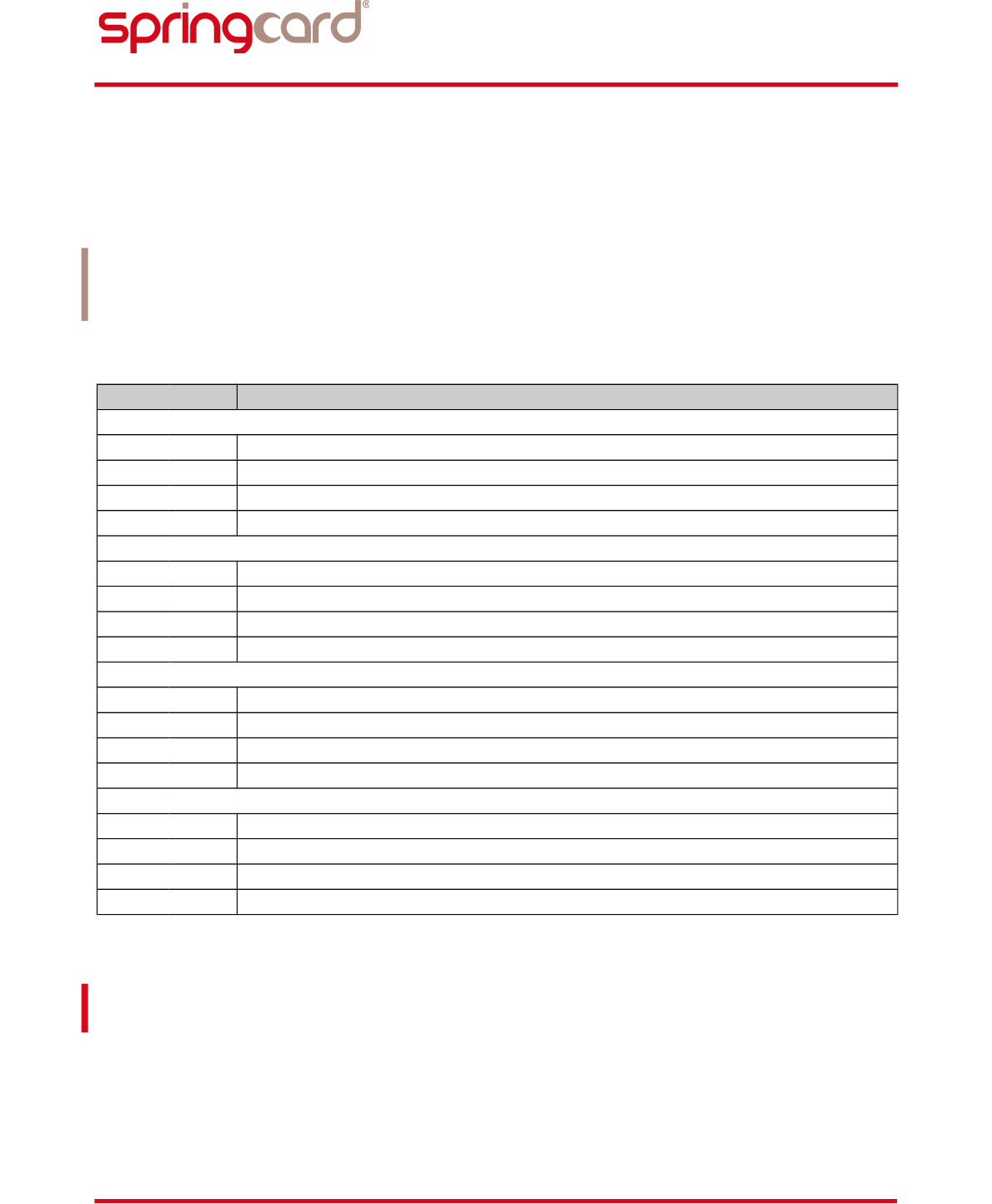
PMD2271-BA
page 107 of 118
SPRINGCARD PC/SC COUPLERS - H663 GROUP - Developer's reference manual
7.5.4. Allowed baudrates in T=CL (ISO 14443-4)
Use this register to let the H663 negotiate a baudrate greater than 106 kbit/s with ISO 14443-4
PICCs (DSI, DRI defined in PPS for ISO 14443 A, in ATTRIB for ISO 14443 B).
The H663 is theoretically able to communicate with PICCs at 848 kbit/s in both directions, but the
actual maximum speed depends heavily on the characteristics of the PICC, and on the coupler’s
actual antenna and environment.
Address: hC4 – Size: 2 bytes (MSB first)
Bit Meaning (if set)
ISO 14443-A DS
msb 15 RFU, must be 0
14 Allow ISO 14443 A PICC H663 @ 848 kbit/s (DSI = 3 in PPS)
13 Allow ISO 14443 A PICC H663 @ 424 kbit/s (DSI = 2 in PPS)
12 Allow ISO 14443 A PICC H663 @ 212 kbit/s (DSI = 1 in PPS)
ISO 14443-A DR
11 RFU, must be 0
10 Allow ISO 14443 A H663 PICC @ 848 kbit/s (DRI = 3 in PPS)
9 Allow ISO 14443 A H663 PICC @ 424 kbit/s (DRI = 2 in PPS)
8 Allow ISO 14443 A H663 PICC @ 212 kbit/s (DRI = 1 in PPS)
ISO 14443-B DS
7 RFU, must be 0
6 Allow ISO 14443 B PICC H663 @ 848 kbit/s (DSI = 3 in ATTRIB)
5 Allow ISO 14443 B PICC H663 @ 424 kbit/s (DSI = 2 in ATTRIB)
4 Allow ISO 14443 B PICC H663 @ 212 kbit/s (DSI = 1 in ATTRIB)
ISO 14443-B DR
3 RFU, must be 0
2 Allow ISO 14443 B H663 PICC @ 848 kbit/s (DRI = 3 in ATTRIB)
1 Allow ISO 14443 B H663 PICC @ 424 kbit/s (DRI = 2 in ATTRIB)
lsb 0 Allow ISO 14443 B H663 PICC @ 212 kbit/s (DRI = 1 in ATTRIB)
Default value: h3333 (up to 424 kbit/s).
You must lower-down the allowed baudrates to 106kbps (h0000) if your antenna is not capable to
handle the higher baudrates without communication errors.
SPRINGCARD, the SPRINGCARD logo, PRO ACTIVE and the PRO ACTIVE logo are registered trademarks of PRO ACTIVE SAS.
All other brand names, product names, or trademarks belong to their respective holders.
Information in this document is subject to change without notice. Reproduction without written permission of PRO ACTIVE is forbidden.
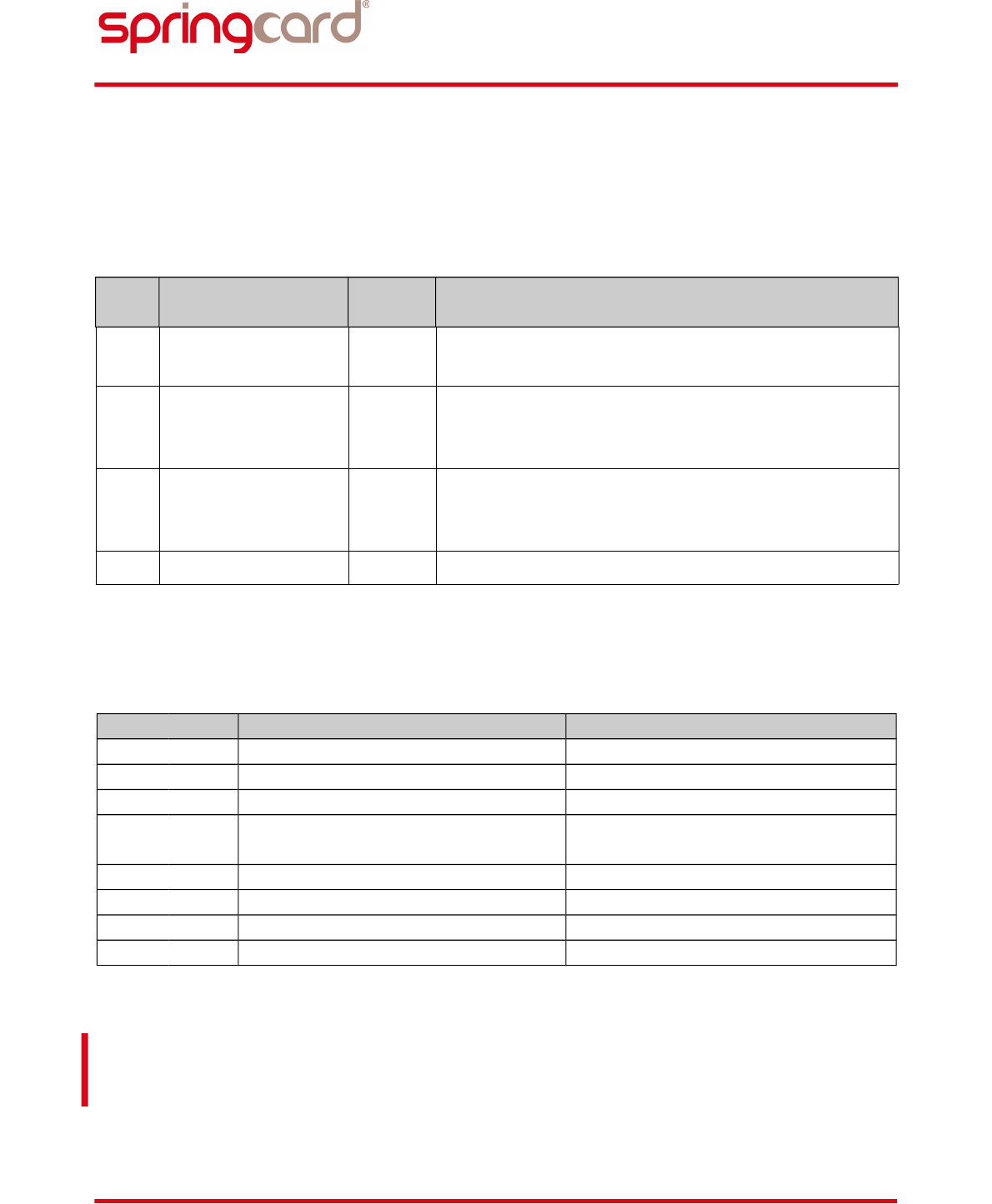
PMD2271-BA
page 108 of 118
SPRINGCARD PC/SC COUPLERS - H663 GROUP - Developer's reference manual
7.5.5. Options for T=CL (ISO 14443-4)
This register defines the behaviour of the ISO 14443-4 subsystem.
Address: hC5 – Size: 4 bytes
Byte Data Default
value
Remark
0 Extra guard time h00 Guard time (specified in ms) to add before sending a
frame to the PICC.
1 Retries on card mute h03 Number of retries before giving up when the PICC does
not answer (communication timeout, and no other
error detected)
2 Retries on comm.
error
h03 Number of retries before giving up when the PCC does
not understand the PICC's response (CRC, parity,
framing errors...)
3 RFU h00 This byte must be h00
7.5.6. Number of antennas + auto-stop
Address: hC8 – Size: 1 byte
Bit Action if set Note
msb 7 RFU
6 RFU
5 RFU
4 Suspend the contactless slot when a
contact card is inserted
This feature is needed by some 'dual'
cards which can't work in both modes
3 RFU
2 RFU
1 RFU
lsb 0 Activate the secondary antenna
Default value: h00 (only one antenna)
Please refer to doc. PNA2236 “H663 integration guide” for information regarding the second
antenna. This feature is available for H663S (unbalanced) only. Note that both antennas must
have exactly the same RF characteristics.
SPRINGCARD, the SPRINGCARD logo, PRO ACTIVE and the PRO ACTIVE logo are registered trademarks of PRO ACTIVE SAS.
All other brand names, product names, or trademarks belong to their respective holders.
Information in this document is subject to change without notice. Reproduction without written permission of PRO ACTIVE is forbidden.
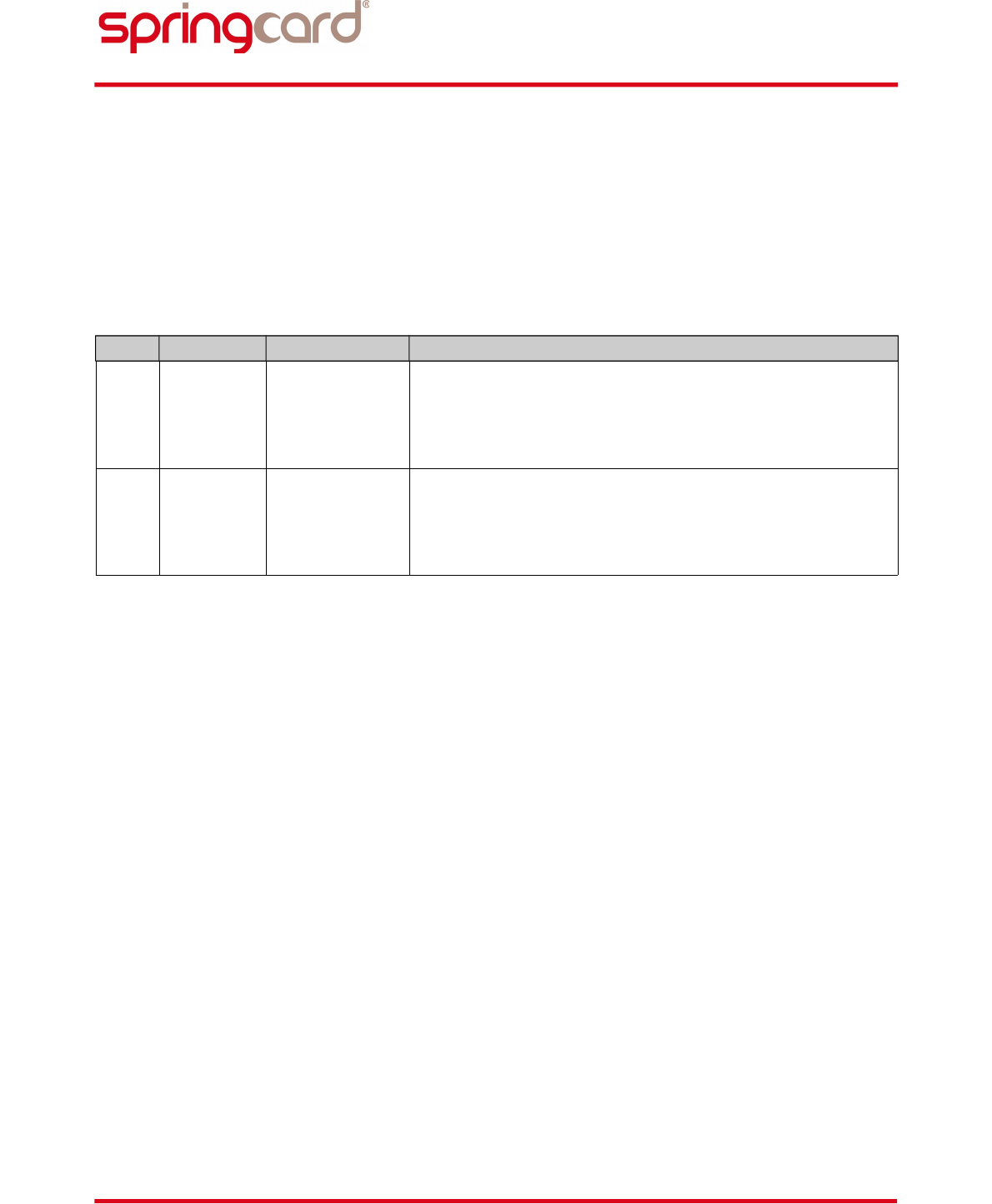
PMD2271-BA
page 109 of 118
SPRINGCARD PC/SC COUPLERS - H663 GROUP - Developer's reference manual
7.6. FELICA CONFIGURATION
7.6.1. Service Codes for Felica read/write
Use this register to define how the H663 processes Felica cards and NFC Type 3 Tags.
Address: hCF – Size: 4 bytes
Byte Data Default value Remark
0 - 1 Read
Service
Code
h000B Service Code used when the READ BINARY instruction is
invoked (MSB first)
The value h000B is mandated by the specification of the
NFC Forum Type 3 Tag
2 - 3 Update
Service
Code
h0009 Service Code used when the UPDATE BINARY instruction is
invoked (MSB first)
The value h0009 is mandated by the specification of the
NFC Forum Type 3 Tag
Those values may be temporarily overwritten right into the SCardTransmit stream using the SET
FELICA RUNTIME PARAMETERS instruction (§ 3.3.6).
SPRINGCARD, the SPRINGCARD logo, PRO ACTIVE and the PRO ACTIVE logo are registered trademarks of PRO ACTIVE SAS.
All other brand names, product names, or trademarks belong to their respective holders.
Information in this document is subject to change without notice. Reproduction without written permission of PRO ACTIVE is forbidden.

PMD2271-BA
page 110 of 118
SPRINGCARD PC/SC COUPLERS - H663 GROUP - Developer's reference manual
7.7. ISO 18092 / NFC-DEP CONFIGURATION
7.7.1. Global Bytes in ATR_REQ
Address: hE1 – Size: 0 to 15 bytes
This register defines the GI bytes sent in ATR_REQ.
If this register remains empty, the default value is:
46 66 6D LLCP magic number
01 01 11 LLCP version 1.1
03 02 00 13 Services = LLC Link Management + SNEP (NDEF exchange protocol)
04 01 96 Link timeout = 1.5 seconds
SPRINGCARD, the SPRINGCARD logo, PRO ACTIVE and the PRO ACTIVE logo are registered trademarks of PRO ACTIVE SAS.
All other brand names, product names, or trademarks belong to their respective holders.
Information in this document is subject to change without notice. Reproduction without written permission of PRO ACTIVE is forbidden.

PMD2271-BA
page 111 of 118
SPRINGCARD PC/SC COUPLERS - H663 GROUP - Developer's reference manual
7.8. ISO 7816 CONFIGURATION
7.8.1. Options for the smartcard slots
This register defines the parameters used by the H663 for the smartcard and SIM/SAM slots.
Address: hC3 – Size: 5 bytes
Byte Data Default value Remark
0 Configuration of the ID-1
slot
hB3 - Contact if the coupler has a ID-1 slot
- not used otherwise
1 Configuration of the
SAM1 slot
hB3 - “SAM A” if the coupler has 1 or 4 SAMs
- not used otherwise
2 Configuration of the
SAM2 slot
hB3 - “SAM A” if the coupler has 3 SAMs
- “SAM B” if the coupler has 4 SAMs
2 Configuration of the
SAM3 slot
hB3 - “SAM B” if the coupler has 3 SAMs
- “SAM C” if the coupler has 4 SAMs
4 Configuration of the
SAM4 slot
hB3 - “SAM C” if the coupler has 3 SAMs
- “SAM D” if the coupler has 3 SAMs
Every byte's bits are defined as follow:
Bit Action if set Note
msb 7 Enable automatic PPS
6 Enable HSP Use this only with Calypso SAMs
5 Enable EMV power on EMV mode is tried before standard mode
4 Enable non-EMV power on Non-EMV cards will be rejected
3 RFU
2 Enable class C (1.8V) The coupler tries the lower voltage class
first, and then increments until one
matches.
1 Enable class B (3V)
lsb 0 Enable class A (5V)
hB3 stands for
•PPS automatic
•HSP disabled
•EMV power on tried before standard power on
•Class = AB (3V then 5V)
SPRINGCARD, the SPRINGCARD logo, PRO ACTIVE and the PRO ACTIVE logo are registered trademarks of PRO ACTIVE SAS.
All other brand names, product names, or trademarks belong to their respective holders.
Information in this document is subject to change without notice. Reproduction without written permission of PRO ACTIVE is forbidden.

PMD2271-BA
page 112 of 118
SPRINGCARD PC/SC COUPLERS - H663 GROUP - Developer's reference manual
8. ANNEX A – SPECIFIC ERROR CODES
When the APDU interpreter returns SW1 = h6F, the value of SW2 maps to one of the H663 specific
error codes listed below.
SW2 Symbolic name25 Meaning
h01 MI_NOTAGERR No answer received (no card in the field, or
card is mute)
h02 MI_CRCERR CRC error in card's answer
h03 MI_EMPTY No data available
h04 MI_AUTHERR Card authentication failed
h05 MI_PARITYERR Parity error in card's answer
h06 MI_CODEERR Invalid card response opcode
h07 MI_CASCLEVEX Bad anti-collision sequence
h08 MI_SERNRERR Card's serial number is invalid
h09 MI_LOCKED Card or block locked
h0A MI_NOTAUTHERR Card operation denied, must be authenticated
first
h0B MI_BITCOUNTERR Wrong number of bits in card's answer
h0C MI_BYTECOUNTERR Wrong number of bytes in card's answer
h0D MI_VALUEERR Card counter error
h0E MI_TRANSERR Card transaction error
h0F MI_WRITEERR Card write error
h10 MI_INCRERR Card counter increment error
h11 MI_DECRERR Card counter decrement error
h12 MI_READERR Card read error
h13 MI_OVFLERR RC: FIFO overflow
h15 MI_FRAMINGERR Framing error in card's answer
h16 MI_ACCESSERR Card access error
h17 MI_UNKNOWN_COMMAND RC: unknown opcode
h18 MI_COLLERR A collision has occurred
h19 MI_COMMAND_FAILED RC: command execution failed
h1A MI_INTERFACEERR RC: hardware failure
h1B MI_ACCESSTIMEOUT RC: timeout
h1C MI_NOBITWISEANTICOLL Anti-collision not supported by the card(s)
h1D MI_EXTERNAL_FIELD An external RF field is already present, unable
to activate the coupler's RF field
25 As used in SpringProx API (defines in springprox.h)
SPRINGCARD, the SPRINGCARD logo, PRO ACTIVE and the PRO ACTIVE logo are registered trademarks of PRO ACTIVE SAS.
All other brand names, product names, or trademarks belong to their respective holders.
Information in this document is subject to change without notice. Reproduction without written permission of PRO ACTIVE is forbidden.

PMD2271-BA
page 113 of 118
SPRINGCARD PC/SC COUPLERS - H663 GROUP - Developer's reference manual
h1F MI_CODINGERR Bad card status
h20 MI_CUSTERR Card: vendor specific error
h21 MI_CMDSUPERR Card: command not supported
h22 MI_CMDFMTERR Card: format of command invalid
h23 MI_CMDOPTERR Card: option of command invalid
h24 MI_OTHERERR Card: other error
h3C MI_WRONG_PARAMETER Coupler: invalid parameter
h64 MI_UNKNOWN_FUNCTION Coupler: invalid opcode
h70 MI_BUFFER_OVERFLOW Coupler: internal buffer overflow
h7D MI_WRONG_LENGTH Coupler: invalid length
SPRINGCARD, the SPRINGCARD logo, PRO ACTIVE and the PRO ACTIVE logo are registered trademarks of PRO ACTIVE SAS.
All other brand names, product names, or trademarks belong to their respective holders.
Information in this document is subject to change without notice. Reproduction without written permission of PRO ACTIVE is forbidden.

PMD2271-BA
page 114 of 118
SPRINGCARD PC/SC COUPLERS - H663 GROUP - Developer's reference manual
9. ANNEX B – ACTIVATING SCARDCONTROL WITH THE DIFFERENT DRIVERS
Being compliant with the CCID specification, the H663 is supported by (at least) 4 USB drivers:
SpringCard CCID driver for Windows (ref. SDD480),
Microsoft CCID kernel-mode driver (USBCCID) coming with Windows 2000/XP/Vista,
Microsoft CCID user-mode driver (WUDFUsbccidDriver) coming with Windows 7,
The open-source CCID driver from the PCSC-Lite package on Linux, MacOS X, and other
UNIX operating systems.
9.1. DIRECT CONTROL USING SPRINGCARD SDD480
Direct control is always enabled in SpringCard SDD480 driver.
With this driver, in SCardControl function call, parameter dwControlCode shall be set to
SCARD_CTL_CODE(2048).
SCARD_CTL_CODE is a macro defined in header winscard.h from Windows SDK. For non-C/C++
languages, replace SCARD_CTL_CODE(2048) by constant value h00241FE4 (d3219456).
9.2. DIRECT CONTROL USING MS USBCCID
With MS USBCCID driver, direct control of the coupler must be enabled on a per-coupler basis:
each coupler has its own USB serial number, and the direct control has to be unequivocally
enabled for this serial number.
This is done by writing a value in registry, either using regedit or custom software. See for instance
the command line tool ms_ccid_escape_enable, available with its source code in SpringCard
PC/SC SDK.
The target key in registry is
HKEY_LOCAL_MACHINE
SYSTEM
CurrentControlSet
Enum
USB
VID_1C34&PID_91B1
yyyyyyyy
Device Parameters
where yyyyyyyy is the coupler’s Serial Number.
SPRINGCARD, the SPRINGCARD logo, PRO ACTIVE and the PRO ACTIVE logo are registered trademarks of PRO ACTIVE SAS.
All other brand names, product names, or trademarks belong to their respective holders.
Information in this document is subject to change without notice. Reproduction without written permission of PRO ACTIVE is forbidden.

PMD2271-BA
page 115 of 118
SPRINGCARD PC/SC COUPLERS - H663 GROUP - Developer's reference manual
Under this registry key, create the registry entry EscapeCommandEnabled, of type DWORD, and
set it to value 1. Once the value has been written, unplug and plug the coupler again (or restart
the computer) so the driver will restart, taking the new parameter into account.
With this driver, in SCardControl function call, parameter dwControlCode shall be set to
SCARD_CTL_CODE(3050).
SCARD_CTL_CODE is a macro defined in header winscard.h from Windows SDK. For non-C/C++
languages, replace SCARD_CTL_CODE(3500) by constant value h004074F8 (d3225264).
9.3. DIRECT CONTROL USING MS WUDFUSBCCIDDRIVER
With MS WUDFUsbccidDriver (new user-mode driver introduced in Windows 7), direct control of
the coupler must also be enabled on a per-coupler basis: each coupler has its own USB serial
number, and the direct control has to be unequivocally enabled for this serial number.
This is done by writing a value in registry, either using regedit or custom software. See for instance
the command line tool ms_ccid_escape_enable, available with its source code in SpringCard
PC/SC SDK.
The target key in registry is
HKEY_LOCAL_MACHINE
SYSTEM
CurrentControlSet
Enum
USB
VID_1C34&PID_91B1
yyyyyyyy
Device Parameters
WUDFUsbccidDriver
where yyyyyyyy is the coupler’s Serial Number.
Under this registry key, create the registry entry EscapeCommandEnabled, of type DWORD, and
set it to value 1. Once the value has been written, unplug and plug the coupler again (or restart
the computer) so the driver will restart, taking the new parameter into account.
With this driver, in SCardControl function call, parameter dwControlCode shall be set to
SCARD_CTL_CODE(3050).
SCARD_CTL_CODE is a macro defined in header winscard.h from Windows SDK. For non-C/C++
languages, replace SCARD_CTL_CODE(3500) by constant value h004074F8 (d3225264).
SPRINGCARD, the SPRINGCARD logo, PRO ACTIVE and the PRO ACTIVE logo are registered trademarks of PRO ACTIVE SAS.
All other brand names, product names, or trademarks belong to their respective holders.
Information in this document is subject to change without notice. Reproduction without written permission of PRO ACTIVE is forbidden.

PMD2271-BA
page 116 of 118
SPRINGCARD PC/SC COUPLERS - H663 GROUP - Developer's reference manual
9.4. DIRECT CONTROL USING PCSC-LITE CCID
To be written.
SPRINGCARD, the SPRINGCARD logo, PRO ACTIVE and the PRO ACTIVE logo are registered trademarks of PRO ACTIVE SAS.
All other brand names, product names, or trademarks belong to their respective holders.
Information in this document is subject to change without notice. Reproduction without written permission of PRO ACTIVE is forbidden.
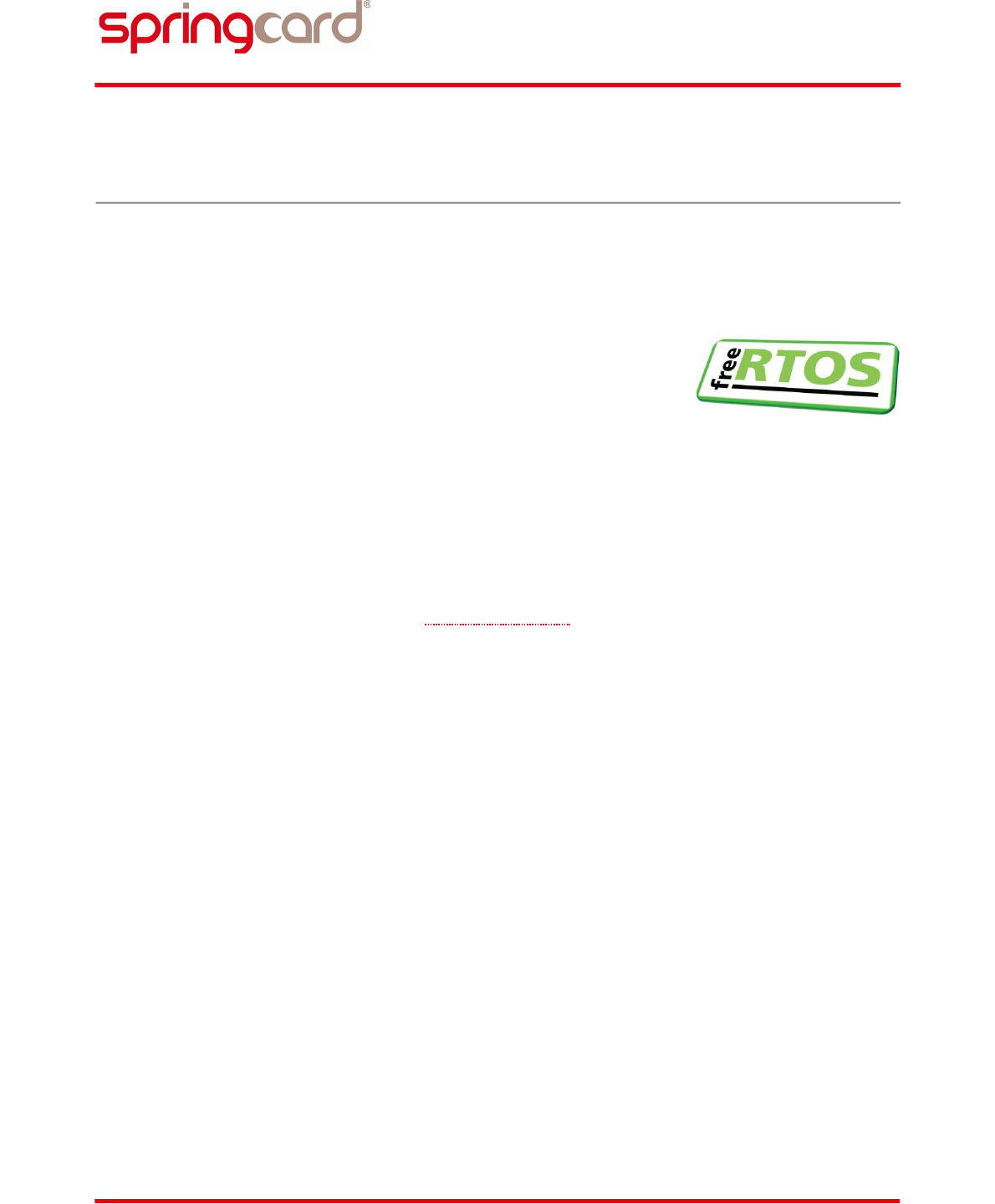
PMD2271-BA
page 117 of 118
SPRINGCARD PC/SC COUPLERS - H663 GROUP - Developer's reference manual
10. 3RD-PARTY LICENSES
SpringCard H663 uses one 3-rd party open-source software component.
10.1. FREERTOS
FreeRTOS is a market leading real time operating system (or RTOS) from Real Time Engineers Ltd.
Starting from firmware version 2.00, SpringCard H663 runs on FreeRTOS v8.2.0.
FreeRTOS is distributed under a modified GNU General Public License (GPL) that allows to use it in
commercial, closed-source products.
For more information, or to download the source code of FreeRTOS, please visit
www.freertos.org
SPRINGCARD, the SPRINGCARD logo, PRO ACTIVE and the PRO ACTIVE logo are registered trademarks of PRO ACTIVE SAS.
All other brand names, product names, or trademarks belong to their respective holders.
Information in this document is subject to change without notice. Reproduction without written permission of PRO ACTIVE is forbidden.

PMD2271-BA
page 118 of 118
SPRINGCARD PC/SC COUPLERS - H663 GROUP - Developer's reference manual
DISCLAIMER
This document is provided for informational purposes only and shall not be construed as a commercial offer, a license,
an advisory, fiduciary or professional relationship between PRO ACTIVE and you. No information provided in this
document shall be considered a substitute for your independent investigation.
The information provided in document may be related to products or services that are not available in your country.
This document is provided "as is" and without warranty of any kind to the extent allowed by the applicable law. While
PRO ACTIVE will use reasonable efforts to provide reliable information, we don't warrant that this document is free of
inaccuracies, errors and/or omissions, or that its content is appropriate for your particular use or up to date. PRO
ACTIVE reserves the right to change the information at any time without notice.
PRO ACTIVE doesn't warrant any results derived from the use of the products described in this document. PRO ACTIVE
will not be liable for any indirect, consequential or incidental damages, including but not limited to lost profits or
revenues, business interruption, loss of data arising out of or in connection with the use, inability to use or reliance on
any product (either hardware or software) described in this document.
These products are not designed for use in life support appliances, devices, or systems where malfunction of these
product may result in personal injury. PRO ACTIVE customers using or selling these products for use in such
applications do so on their own risk and agree to fully indemnify PRO ACTIVE for any damages resulting from such
improper use or sale.
COPYRIGHT NOTICE
All information in this document is either public information or is the intellectual property of PRO ACTIVE and/or its
suppliers or partners.
You are free to view and print this document for your own use only. Those rights granted to you constitute a license
and not a transfer of title: you may not remove this copyright notice nor the proprietary notices contained in this
documents, and you are not allowed to publish or reproduce this document, either on the web or by any mean,
without written permission of PRO ACTIVE.
Copyright © PRO ACTIVE SAS 2015, all rights reserved.
EDITOR’S INFORMATION
PRO ACTIVE SAS company with a capital of 227 000 €
RCS EVRY B 429 665 482
Parc Gutenberg, 2 voie La Cardon
91120 Palaiseau – FRANCE
CONTACT INFORMATION
For more information and to locate our sales office or distributor in your country or area, please visit
www.springcard.com
SPRINGCARD, the SPRINGCARD logo, PRO ACTIVE and the PRO ACTIVE logo are registered trademarks of PRO ACTIVE SAS.
All other brand names, product names, or trademarks belong to their respective holders.
Information in this document is subject to change without notice. Reproduction without written permission of PRO ACTIVE is forbidden.
